Zot! (1984) #1-36 by Scott McCloud and Zot! #14½ by Matt Feazell
If somebody mentions “Eclipse Comics”, I think the most likely response you’ll get is “eh? what? do I know you?”, but the second most likely response is “they published Zot!, right?”
Right.
I read this comic as a teenager (i.e., when it was being published), but I stopped reading about issue 8, and I didn’t pick it up again until about the mid-teens (after which I backfilled), and I have not re-read these comics since. This is what I think I remember: The first ten issues are super-hero comics that may be better than the pack, but they still aren’t really worth reading, and 2) from #11 and until it ends it’s about high-school drama.
Join me in this overly long blog post and see whether I remember right or not!
Kurt Busiek is listed as “script consultant” for most of the initial ten-issue run, which is, er, not the most common role in comics…
Anyway! Zot!’s about a girl who goes to a magical alternate Earth where she meets up with a teenage superhero. So far I seem to be remembering correctly. The colouring is super-traditional, as if McCloud wants to invoke the old-timey comics. That, and Zot’s suit apparently lead many to believe that Zot! was an homage to CC Beck’s Captain Marvel comics, but McCloud takes pains to explain that that’s not the case.
The comics are basically a kinetic blast of fun. Zot encounters one deranged super-villain after another and has it out with them, all while cracking jokes and being heroic. I can see why I would be less than enthused by this as a kid, because I was into serious stuff back then, but reading it now, I find it to be a blast.
And McCloud has such a kooky imagination. Some of them are genuinely spooky (like 9JACK9), and some are both deranged and touching (like Art Dekko (*groan*) up there).
McCloud explains where his main inspiration for Zot! is coming from: Not Captain Marvel, but Astro Boy by Osamu Tezuka, the Japanese comics artist who (with the help of his studio of assistants) allegedly cranked out 150K pages during his lifetime. I guess there’s worse place to find inspiration.
Zot! is a super-hero book, and it’s funny, but it rarely goes intertextual, but McCloud can’t help himself sometimes…
I find it amusing how certain of McCloud’s obsessions have remained unchanged throughout the years. The villain Dekko once made beautiful paintings, but then he excised feeling from his artwork and became a commercial success. In McCloud’s recentish doorstop (which is about a guy who’s bitten by a radioactive painting and then gains the superpower to create Balinese tourist souvenirs by waving his hands around, if I remember correctly), he also rails against modern artists and how bad the art world is these days.
I may be misremembering some details from that book, too, but I’m not going to re-read it.
Aaaanyway! McCloud’s pages do have a very Japanese feel to them here and there. I mean, look at those triangles moving around in those panels. Isn’t that so Yuichi Yokoyama? I mean, I don’t think that Yokoyama was around in the 80s? But they’re dipping into the same well.
And if you squint a lot (I mean, A LOT), you get the same kind of endless propulsion hinted at in Zot! as you do in, say, Garden.
I know, it’s a stretch. But squint and then squint at Garden.
Larry Marder writes in and commends McCloud on his clearly readable pages. And it’s true, McCloud’s pages are extremely readable, even if they’re nothing like Joe Shuster.
But everything isn’t perfect. You sometimes have to question McCloud’s taste level when he does things like this The Shy Guy Gets The Girl At The Party one-pager. I know, it’s probably just an exercise in trying minimal storytelling, but it’s still kinda embarrassing.
And then things go rather pear-shaped dramatically in the Zot storyline. While things have been “whahoo!” until now, McCloud apparently felt it was a good idea to introduce some real drama into the book, so he (spoiler alert) kills of the wimpiest character. While reading this now, I was scouring the pages for any sign that this was a gay character, because killing off teh gayz has been the number one strategy to add some sobriety to drama. (And if there’s more than one gay character, you kill off the gayest one: Viz. Star Trek Discovery some weeks ago, so not much have changed.)
In any case, it pauses the fun for some pages, and it doesn’t really work within the context.
McCloud has fun producing quite a few of Dekko’s artworks, and, er, I don’t think they’re very good, but I kinda liked that one. Could look nice on a t-shirt.
You mostly can’t fault the production on these comics: Nice paper, well-printed, top-notch staples, excellent bouquet, but one issue is printed with the yellow horribly off-register on half the pages.
McCloud finally explains why Kurt Busiek and Adam Philips are listed as “consultants” on the credits page: They read the books and offer feedback. You get the feeling that McCloud takes his craft quite seriously and welcomes input, which is admirable.
A six-part backup story by Kurt Busiek and Dan Spiegle is announced. Fortunately, only one is printed, because it’s… er… what’s the word for “not very good”? Not very good?
The next issue we find that the backup feature has been dropped. Because of “circumstances beyond much of anyone’s control”. I wonder what the story behind that is. I mean, beyond it not being very good, perhaps there just wasn’t money enough to pay Busiek and Spiegle? Apparently Zot! wasn’t selling gangbusters by this issue…
Instead we get some behind-the-scenes pages with concept art and logo design. Which is, frankly, more interesting.
McCloud announces a pie-in-the-face contest. The contest ran for several years; perhaps longer than McCloud had intended.
McCloud later became the (for a while in the 90s) the premiere comic book theoretician, and later suggested many ways comics could change to make use of the possibilities online publishing offers (infinite canvas, etc). I find it interesting that he was conscious of the little details in serial comics production and making use of them. For instance, Zot up there is realising that there’s a camera on him, and then you turn the page…
… to this two-page spread over the centre of the comic book. Since these two pages are the only one that are guaranteed to have no gutters between the pages (note the staples in the middle), the page 16-17 spread can be used for things like this without fear of having the effect spoiled.
So you have to pace the plot so that you can do this exactly here, which is a level of attention most (non-art-comics) comic book artists don’t feel worth having.
And then we get an announcement: Zot! is going on a hiatus. This is both because Zot! isn’t selling well enough, because McCloud is afraid of going stale, and because McCloud wants to do other projects.
The hiatus lasted for a year and a half, and the only thing McCloud completed in that period was the Destroy! book (which we’ll cover later in this blog series).
Issue number ten kinda ended in a natural spot: We got most major plot points tied up. So how were they?
I liked them a lot better than I did when I was a kid, I think. They have an exuberance I find quite irresistible. However, dramatically it doesn’t quite hold up. There’s one long plot (about a magical key) that runs throughout this run, and after finishing it, I feel that there were issues that mostly functioned like speed-bumps: The Dekko issues were fun, but had nothing to do with anything, so structurally they made no sense where they were.
And the aforementioned Death of the Wimp was tonal wreckage.
So let’s see what happens next! Is it all high-school drama?
I find this checker banner Eclipse used on some of their black & white comics amusing: As if the lack of colour is a sales gimmick. Which I guess it was; this is slightly after the black & white boom and bust, isn’t it? (For those too young to remember, it was an collectors investment mania triggered by the sudden popularity of Ninja Mutant Teenage Turtles. Yes. It’s a strange world.)
But, indeed, we have a black and white comic book now, and McCloud adjusts his art style accordingly: Gone are the bright open panels, and instead we get juicy blacks and textures.
And we go from a comic that doesn’t deal with sex at all to one that does. Slightly. In a teen-age way.
The letters pages expand, and gets a more intimate clubhouse feel, what with competitions and recommendations for other comics. And all the comics McCloud recommends are, indeed, pretty spiffy, so he has excellent taste (which we also saw in the edition of America’s Best Comics he edited the other year).
Finally, rounding out each issue, we have The Adventures of Zot! in Dimension 10½ by Matt Feazell.
While the direction of the stories haven’t really changed all that much (it’s still mostly super-hero hi-jinx, so I misremembered), it feels like a much more complete package now. We get a satisfying chunk of the main Zot storyline, and then a chatty letters page with many returning letter-writers, and this backup feature, and it’s all very… satisfying.
(Some readers may have been dissatisfied with the price increase from $1.50 (when Zot! was in colour) to $2.00 now, though, but black & white comics sell less, and lower print runs are more expensive…)
I do find it amusing that Eclipse was pushing the black & white boom like this, though. But we’ll get back to that when we reach the start of those series listed above…
McCloud experimented with er crayons? on Jenny’s head for a handful of issues. I think it’s a nice effect, but when that’s the only place it’s being used, it’s a bit distracting.
And look at that masterful stink face Jenny’s giving Zot! McCloud got really good at facial expressions as the series progressed.
McCloud’s still using the centrefold (er) to great effect in a few issues. I mean, LOOK!
This is probably the most iconic image from the second part of this series: It’s the entire series in one single image. The adventure, the romance, the fantasy.
Am I on crack when I think that McCloud is more than slightly influenced by Beto Hernandez on pages like this? Think of those Errata Stigmata pages in the futuristic city…
I don’t think we’ve come this far in this blog series before with any of the “normal” Eclipse books? I’m re-reading and writing chronologically, but I’m doing them chronologically by #1 of each series, so how far I get depends on how long the series last. Anyway, I think this is the first of these “news” pages Eclipse tried running for a while to keep the readers abreast of what Eclipse was publishing. They’re laying it on rather thick when hawking these comics…
DID IT!?
See? More Errata Stigmata (or perhaps the Beto Hernandez layouts from Mister X)…
Then we get to the issue between #14 and #15, and it’s a fill-in issue by Matt Feazell. He uncramps his layouts quite a bit.
And it’s all good fun.
The “news” page claims that Eclipse is selling out of all kinds of comics, but says that this is because comics shops don’t have enough money to put in the orders they should be putting in, apparently. The direct sales market has had so many melt-downs over the years…
McCloud announces a crossover with Omaha the Cat Dancer. Heh heh.
So if Matt Feazell is doing the main feature, then McCloud has to do the backup page, right? Right.
I guess I haven’t really written much about what the comic is about here in the teens… It mostly takes place on Zot’s Earth, and there’s the usual selection of goofy villains and evil plots to take over the world. It’s great fun, but then we get dreary bits like “do machines have souls?” Why. Just why.
But we also get more fun Dekko paintings. A lot. These are some of the better ones.
And yet another call to action. Get retailers to buy more Zot!. But what’s that about “big Originals box”?
It’s this! Scott McCloud was selling his original pages for $46 (!) a piece, and people were not buying them like crazy. That’s… crazy. Adjusted for inflation, that’s $101 in 2018 money. I had no money back then because I was a student, but didn’t anybody else have any sense? There’s a lot of very pretty pages…
But then Chuck Austen fills in on artwork for two issues, and it’s… jarring. It’s not that he’s a bad artist or anything, but…
McCloud does the layouts, but the action seems a lot less intense, too.
“After a decade of excellence…” Eclipse didn’t lack confidence when doing the ads. So what do you do after a decade of excellence? James Bond by Mike Grell. I guess they’re announcing a change of pace, then!
We’ll see.
McCloud keeps experimenting with different approaches to black-and-white art. Is this overkill? Hm. I kinda like the overwrought hatching.
Even Feazell changes his artwork up, as in this homage to Chester Brown’s Yummy Fur.
And then we get back to the major controversy: When that wimpy guy was killed off 15 issues earlier. A letter writer assumes (like I did when I read it) that the wimpy guy was meant to be gay, and McCloud says that he hadn’t thought of that, but perhaps yes?
This angered at several letter-writers, but for wildly different reasons. There’s one fundamental religious guy who wrote several rants I didn’t pay much attention to, but another more interesting guy who accused McCloud of not thinking through the way he used his black and gay characters, and accused McCloud of tokenism. (McCloud defends himself admirably, I think.)
Oh, geez. How long have I been typing now? It’s the middle of the night now…
Let’s keep going…
Throughout the second run of Zot!, sales were apparently rising (or steady, at least), which is quite impressive. These day, no serial comics have growing readerships: They’re launched at a #1 with sales of X, and then there’s a “natural attrition” for every issue where it loses readers. Which is rather weird, when you think about it. The 80s, as fucked up as they were in many ways (comics wise), were healthier in other ways.
Anyway! I seem to be harping on McCloud’s usage of the comics format a lot, and here’s some more harping. We finally (after some years) get the pie throwing scene (after the readers voted for who they wanted to get a pie thrown in which face ***REMEMBER TO EDIT FOR GRAMMER BEFORE POSTING***), and McCloud does it masterfully. With some fake-outs first that use the materiality of reading comics perfectly.
So that’s the final panels on an odd-numbered page, so you turn the page over…
… and somebody doesn’t get the pie in their face. I laughed out loud. Trust me, it’s funnier if you’re actually turning the page.
These pie-throwing issues (yes, it goes beyond one) are a farewell to Zot’s universe. We get to see all the villains again, and visit with every character from Zot’s environment at a party), and it all feels very elegiac. We also get the beginning of an explanation of what Zot’s universe really is, but this isn’t really followed up on before the series ended. Reading that panel sent a tingle up my spine.
It seemed like just about every issue McCloud was apologising for being late. But he did manage to produce quite a solid stack of comics these years. He cut back to 18 Zot pages per issue (from 24) and gave the pages over to Feazell for an extended backup feature series to achieve a semblance of a schedule, though.
As a bonus, we get a page of all the characters getting pies in their faces. And more.
And then the part of Zot! I remembered started: The high-school years. For the last half a dozen issues, we get no visits to Zot’s world. We’re solidly stuck on our Earth and Zot has to deal with being in this crappy place, and Jenny and her friends have to deal with being in high school. I wonder how much of an influence Ivy Ratafia (co-plotter now and McCloud’s wife) was here.
The tonal shift, again, is huge.
Reading it now, I wasn’t sure whether I approved or not. Is this an incisive investigation in the futility of super-heroes in the real world, or is it just a bit embarrassing?
But then after an issue or two, things clicked and it all started to work, I think. It gets engrossing and so emotional.
Meanwhile, over in Feazell-world, things are as deranged as always, but he’s gotten a revolving cast of writers now. Some of them seem to be recruited from the letters pages, which lends the whole thing even more of an intimate, family feel.
And I think this is peak McCloud lushness. In later works he’d stylise more.
So! What more are these remaining issues about other than high-school? Each issue is centred on a single character from Jenny’s circle of friends. So we get one issue where we get a rather sympathetic, but unflinching and squirm-worthy look at the thought processes of a super-hero comic book nerd. We all knew that guy, right?
And here we have the girl who desperately tries to be happy and not think too much about things. (The happiness sometimes spills over.)
These mini-portraits mostly feel true and lived; they’re not a litany of after-school specials with one theme after another. They’re impressive and moving.
Which brings us to the issue that won all the awards:
#33, the Terry issue. Terry’s dealing with coming out as lesbian in high-school, and things are difficult. But Terry’s portrayed as a complex character, and we really get into her life situation in an amazing way in 18 short pages.
And again, McCloud uses the floppy comic book format amazingly. We have the end of the story, and then the letters page starts as normal. McCloud even has an announcement, that he’ll cut Zot! short (by two issues) from what he’d planned, but that the series will definitely be back after he’s had time do to other projects.
So you read the letters page and then flip the page and…
… AND THEN THE STORY CONTINUES ONE MORE PAGE!
I mean, I remembered the McCloud did this trick at some point in the Zot! storyline, but I didn’t remember that it was this issue, so it came as a complete surprise to me now. And it’s such a beautiful ending that I started bawling again, easily moved as I am.
It’s simply wonderfully done.
And I wonder what McCloud did with these things when Zot! was collected in paperback editions. I can’t believe any of these things were as effective there (the centre page spreads or this fake ending/reveal), but I guess that’s the problem when you tailor the comics to closely to the materiality of the floppies.
There are many interesting letter writers in these issues. This one points out that Zot!’s direction is problematic. McCloud created a super-hero romp, but here we are in real drama land all of a sudden. Can these realities be reconciled? Would it have made more sense to create a separate vehicle for these high-school issues?
And I think that’s a very good question. I think that Zot’s presence in these dramas make them something other than they would have been without his slight overt fantasy naivete. And I think it really works.
In the last few issues, McCloud experiments a lot with smaller panels to convey silence and diffidence.
There’s an avalanche of letters after the “Terry” issue, and one of them is from Howard Cruse.
I don’t mean to imply that everything in these issues is perfect. McCloud can lay it on pretty thick now and then, and having Jenny brooding during a thunderstorm pushes this melodrama into cliche.
And, to the surprise of nobody who was reading Zot!, it was nominated for all the Eisner and Harvey awards.
Heh. I wrote about Aztec Ace the other day, and there was apparently a plan to do a new mini-series by Doug Moench and Doug Heinlein in 1992. That never happened, I think.
And as the final issue of Zot! fades out, Matt Feazell’s Cynicalman bids us adieu.
So!
I really enjoyed spending these two evenings re-reading Zot!, and I can imagine doing so again in a few years. The fun bits are fun, the exciting bits are exciting, and the emotional bits are… effective.
But what did the critics say? Quoth Tom Spurgeon from The Comics Journal 197:
I’ve never quite understood the cult of Zot!, which seems to have been given new life in the past few years as the kind of Older, hardcore fan who is likely to be a cult member takes to Internet chat groups with increasing regularity. Scott McCloud’s first major comics work was a moderately successful light fantasy utilizing the superhero motif that was serialized by Eclipse Comics from 1984 to 1991. It enjoyed erratic sales and periodically fervent critical response which petered Out the further one got away from comic fandom’s warm, fuzzy center and into either hardcore super-dupers or comics for art’s sake. I’m not sure the creator has a stake in the goodwill continued to be directed ZOE’s way: one gets the Sense from interviews that McCloud is fond Of his creation but not in any way absorbed by it; he has promised more comics starring the characters but doesn’t seem to be in any hurry to do them.
Then again, we have Carter Scholz in Comics Journal 98:
Eclipse Comics has been publishing Scott McCloud’s ZOt! for five months now, and it’s a find. This title is a simple but not simple-minded antidote to the other two books mentioned here. The style is nostalgic, but the picked-up pieces are made new. Zot (full name, Zachary T. Paleozogt) (s a teenaged super-hero from an alternative Earth, who comes screaming through a spatiodimen. uh, no, a temporal disp . no, it wasn’t that well, it’s a kind of a window to another world—and into the life of bored teenaged Jenny Weaver on our Earth. Hot on his heels is a crew of murderous robots (“Hey! You there! Look out! I said look out! They’re coming through!’ which he merrily trashes, all but one, which Jenny uses his blaster to dispatch. Then, after some exposition and the arrival of the police, he goes back through the window, followed by Jenny and her apish brother, who fall through just before it closes, ending up on the perilous ledge of a futuristic skyscraper. holy moley! This is a delightful book.
So there you go.
Half of the colour issues were released in a paperback edition by Eclipse in the late 80s, and all ten were collected by Kitchen Sink in the late 90s. In 2008, all the black-and-white issues were collected and published by It Books, and is still in print.
These days McCloud is most famous for having written Understanding Comics, and less well known for having done the followup book Reinventing Comics.

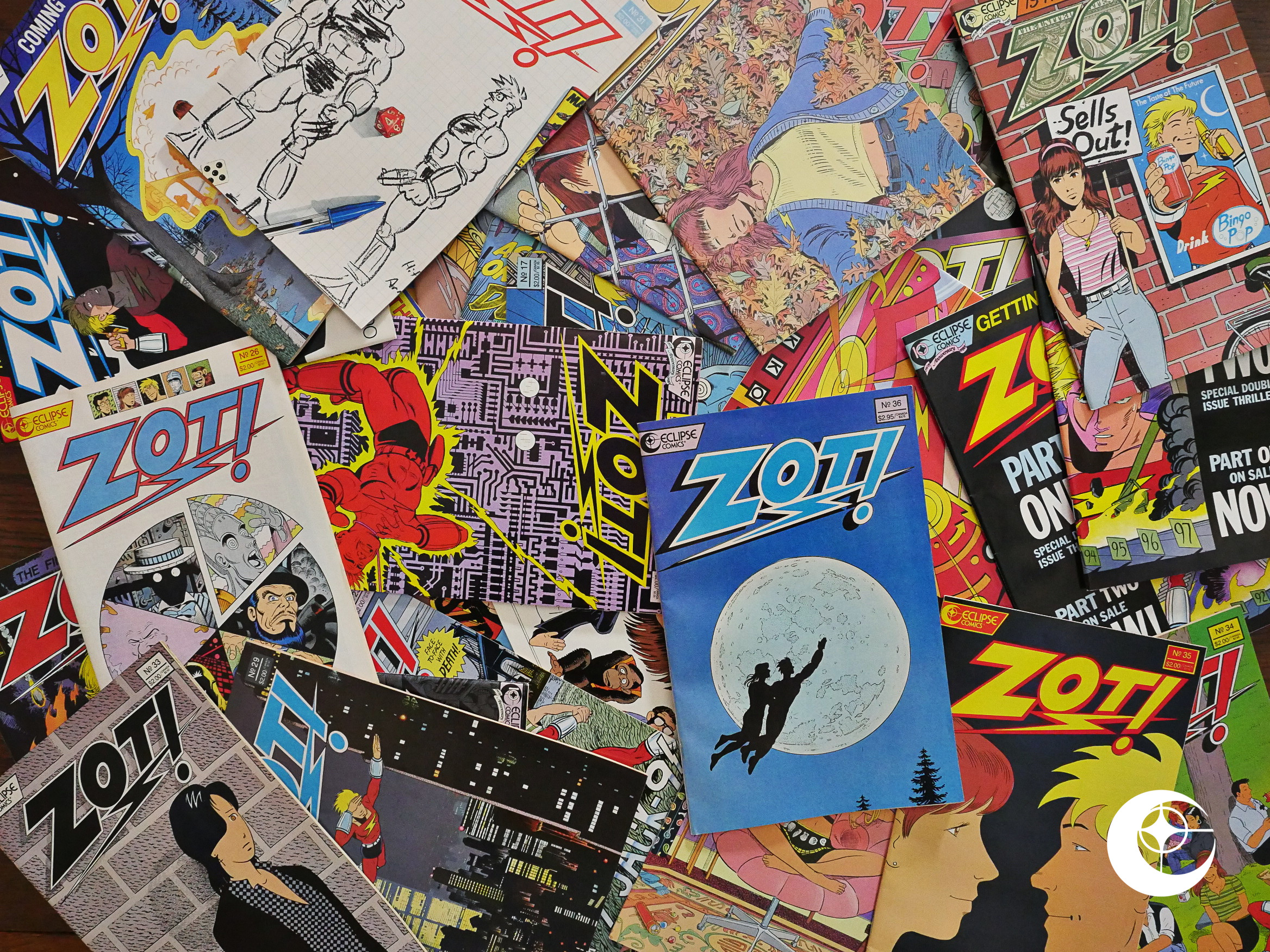
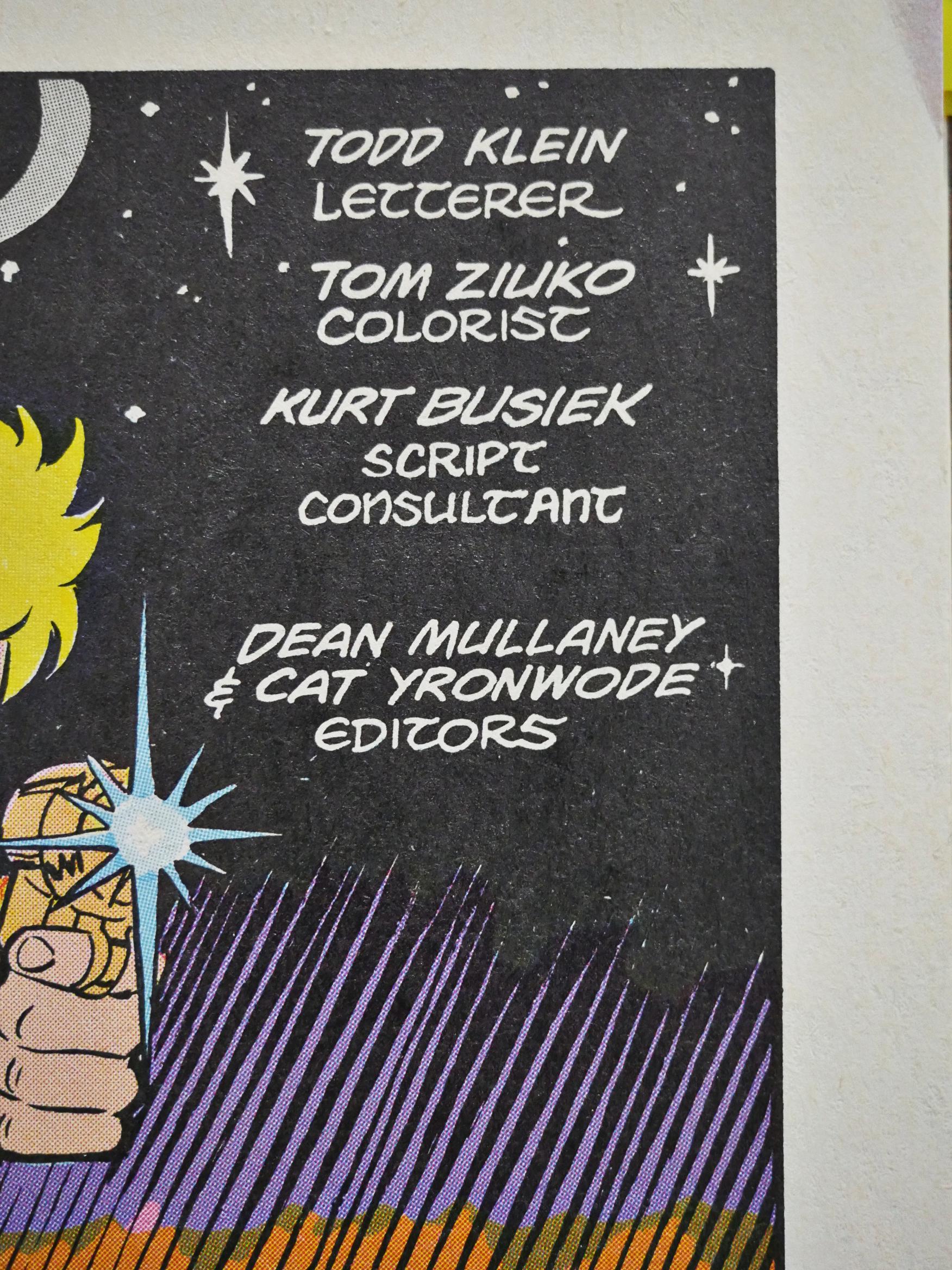
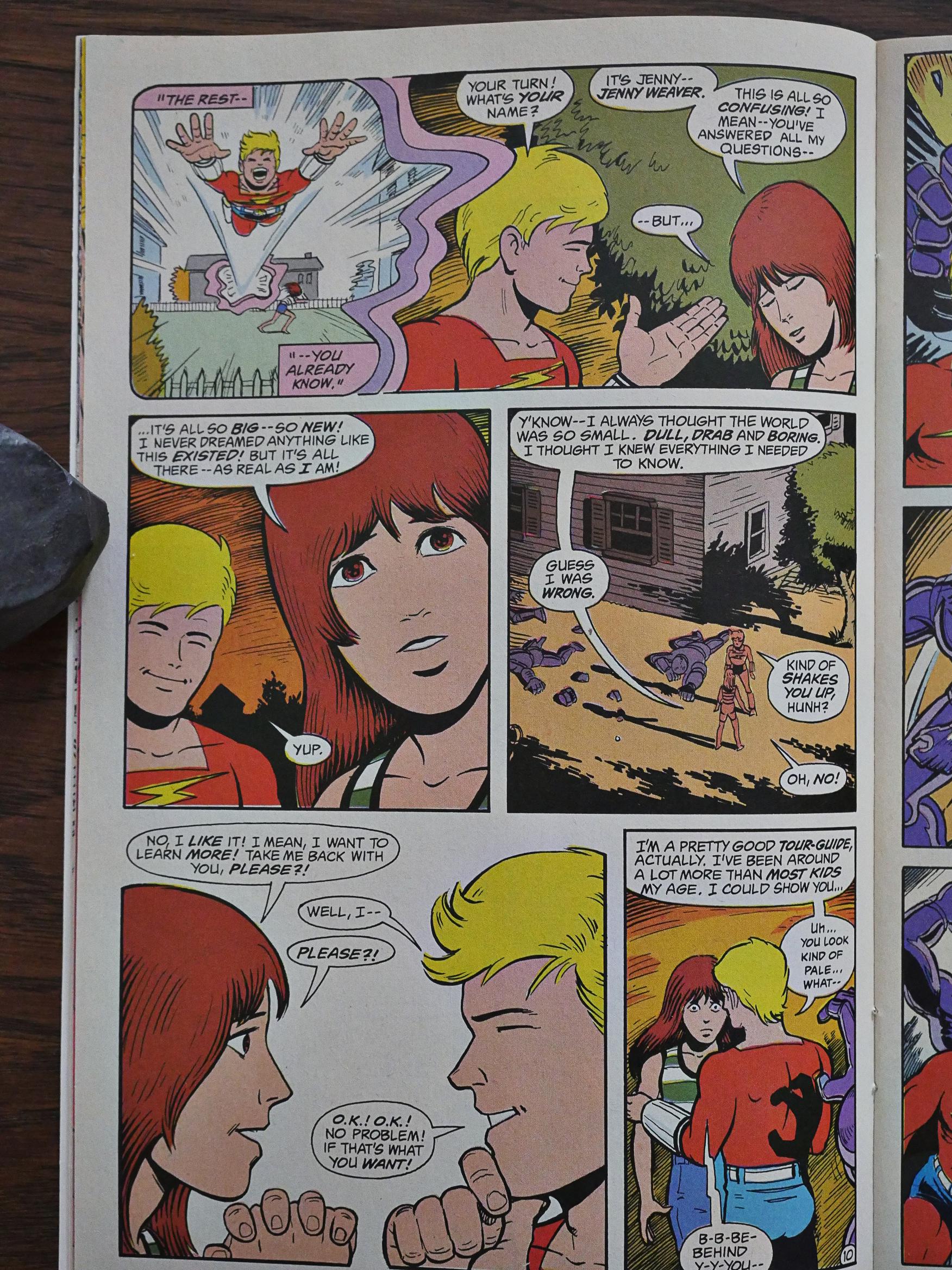
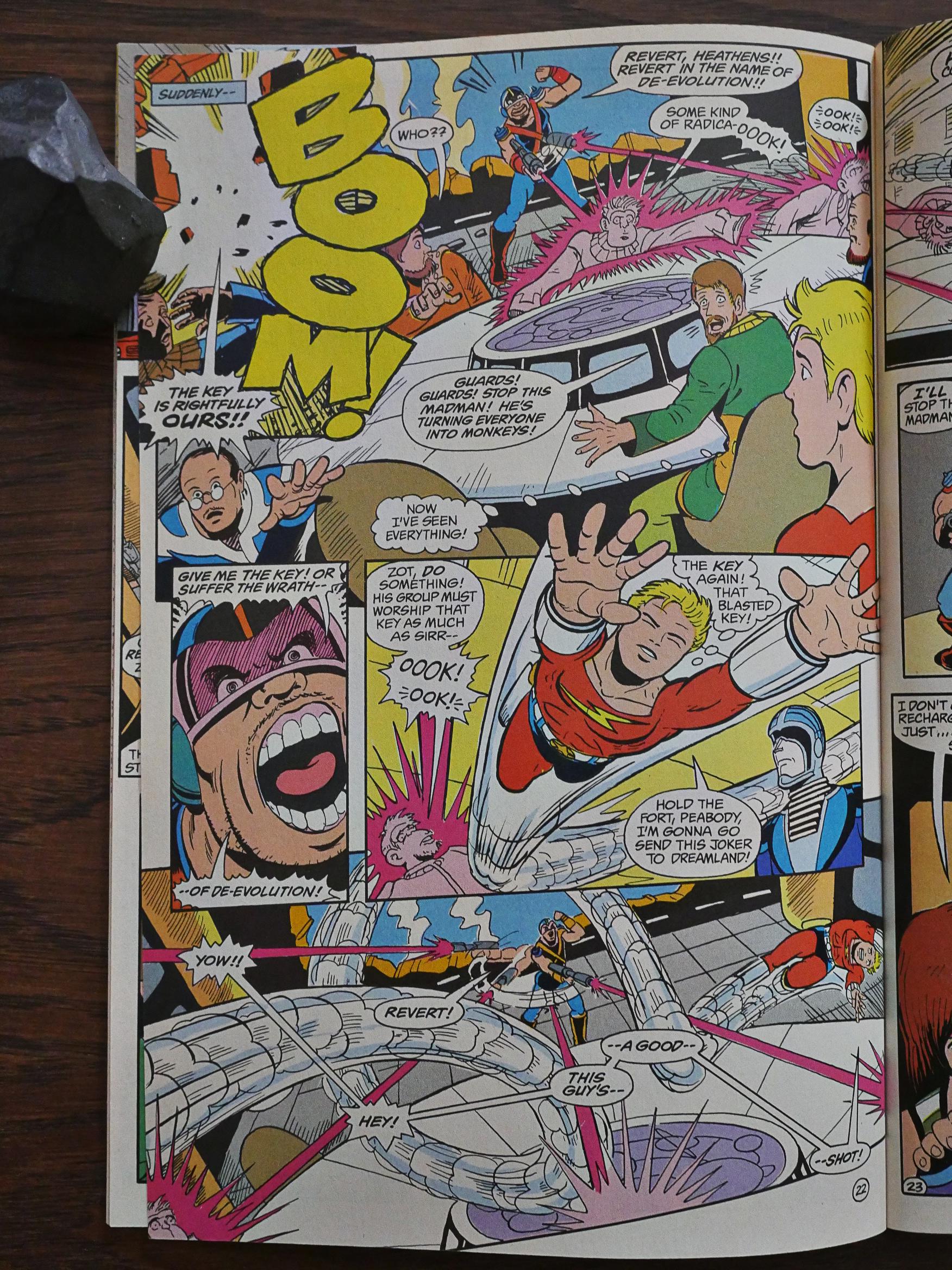
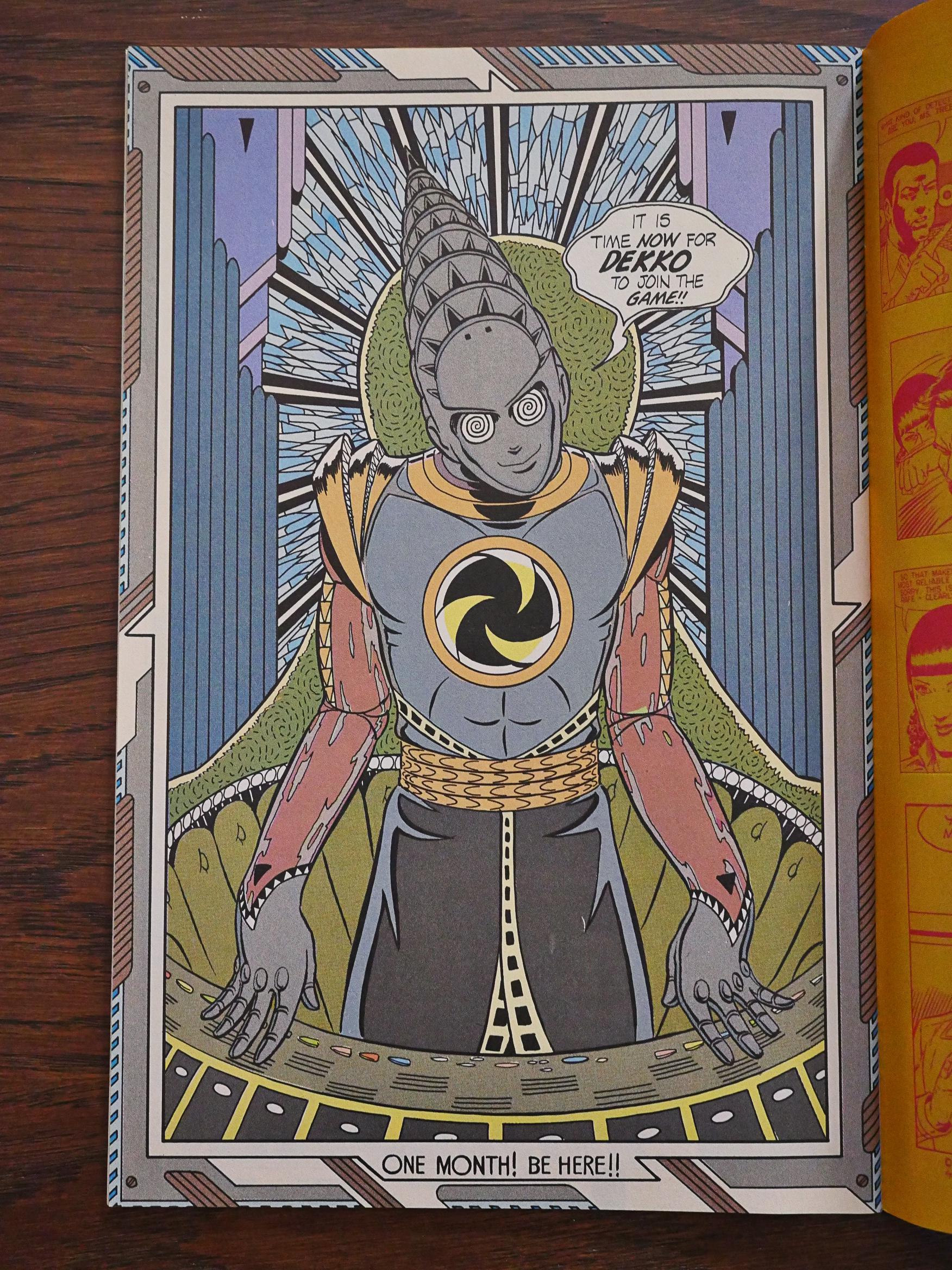
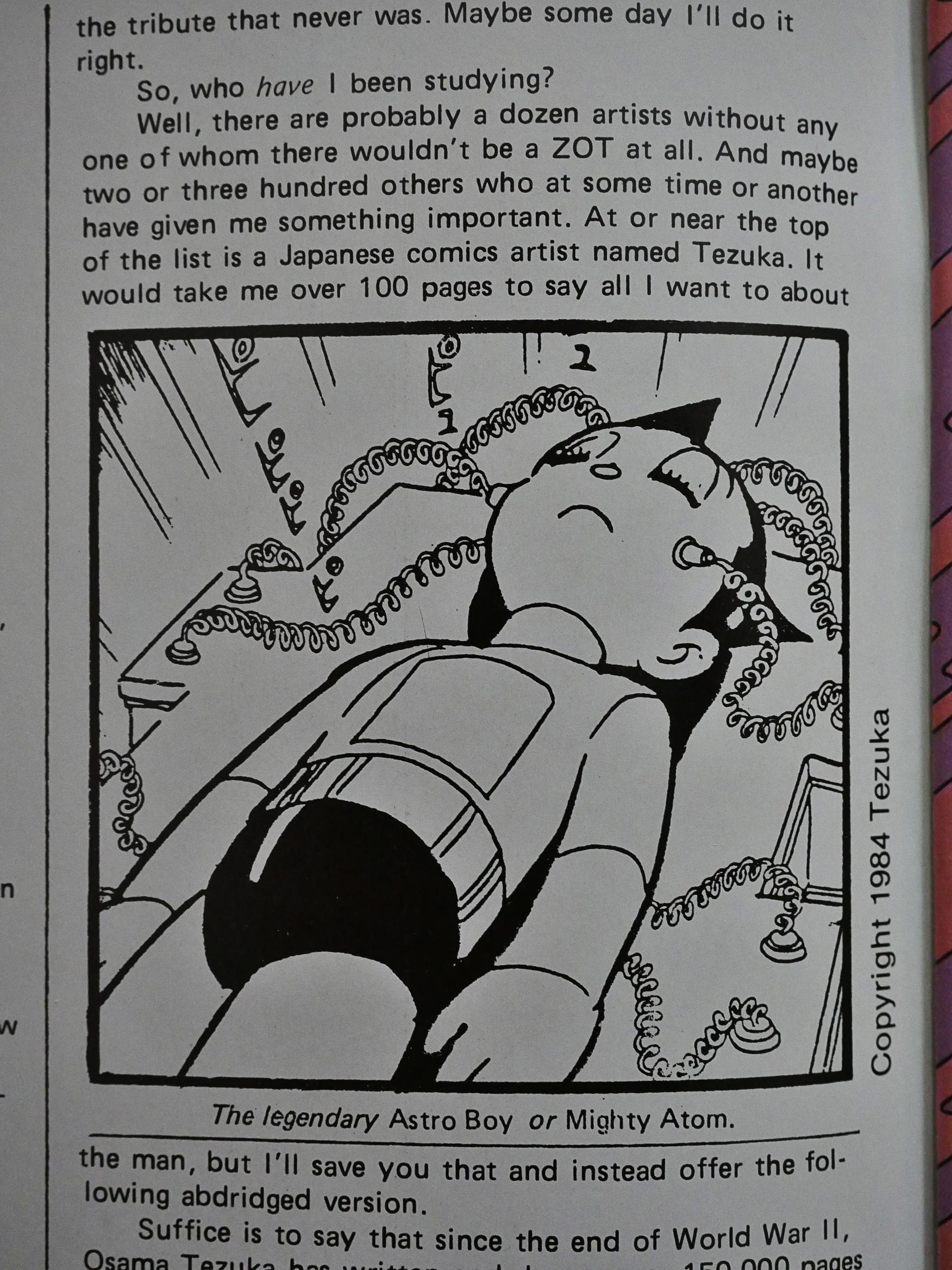
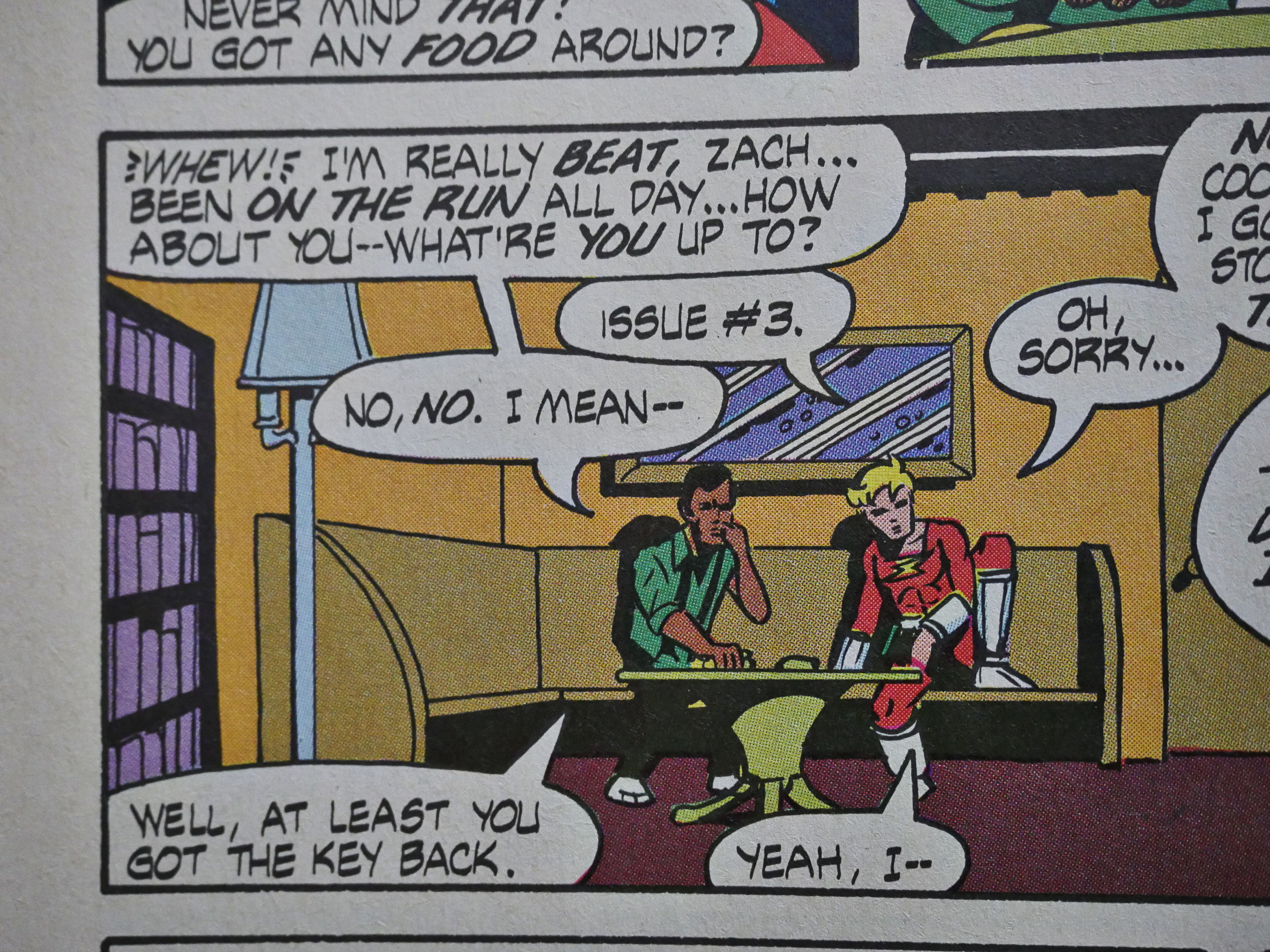
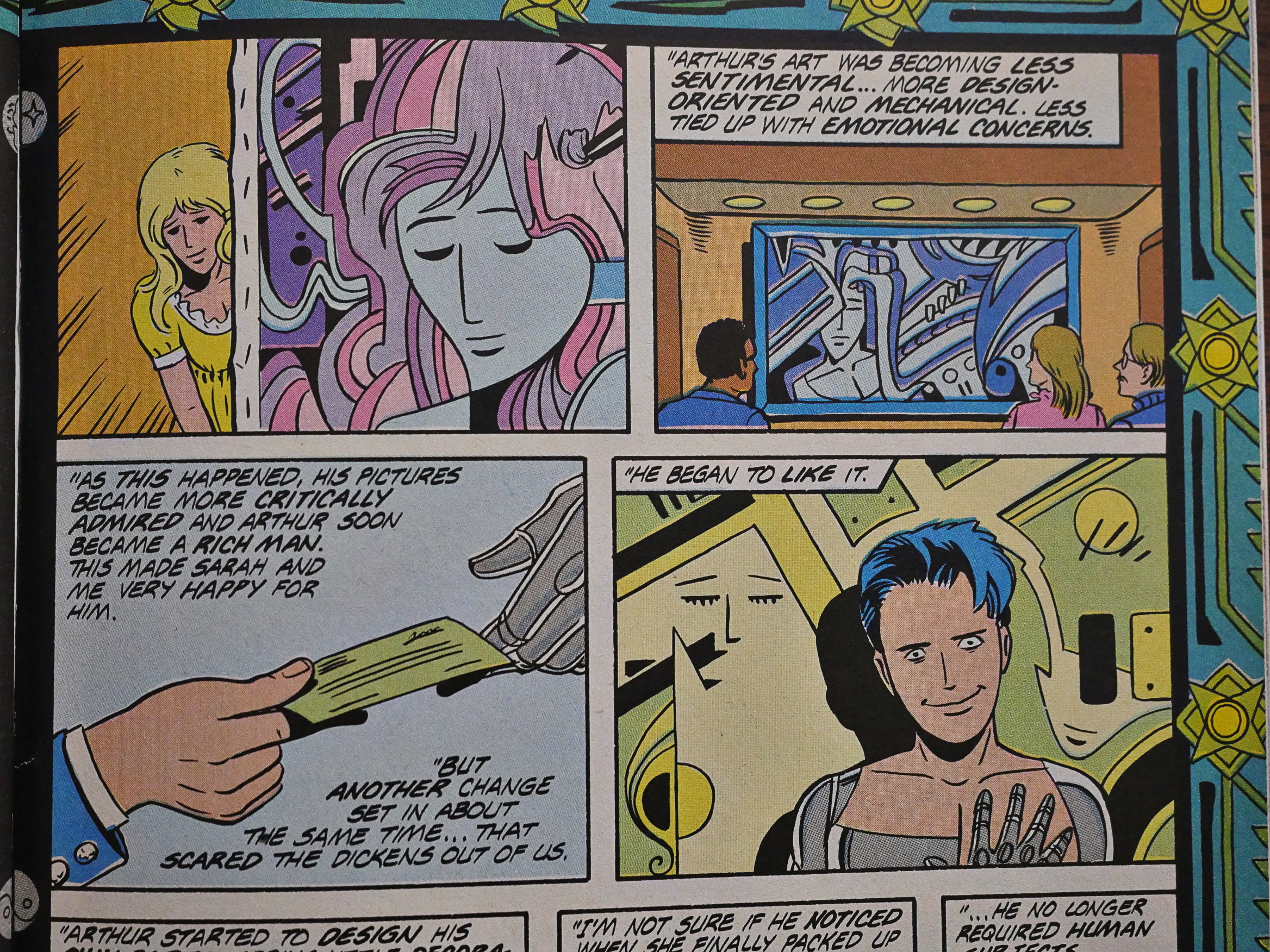
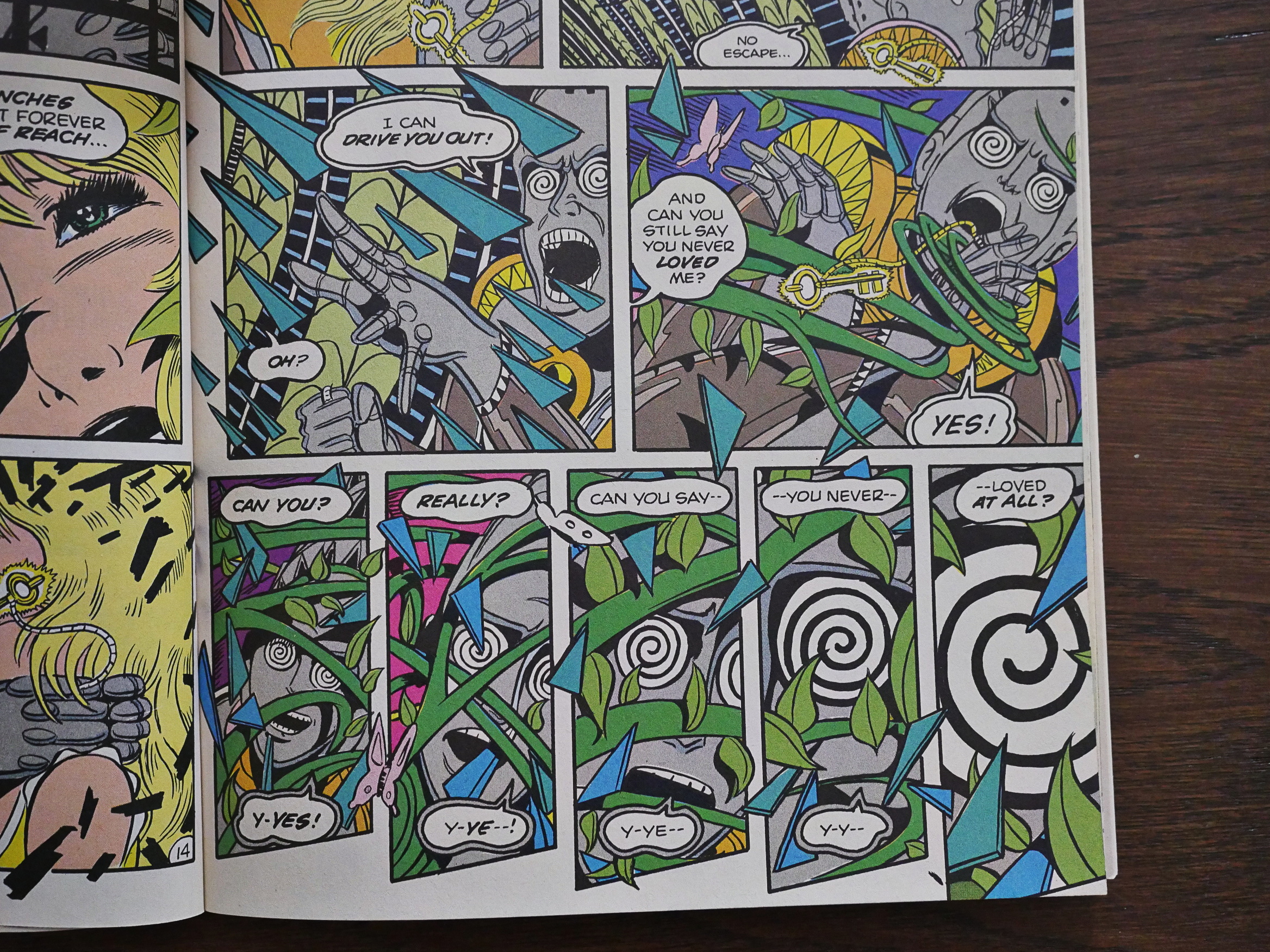
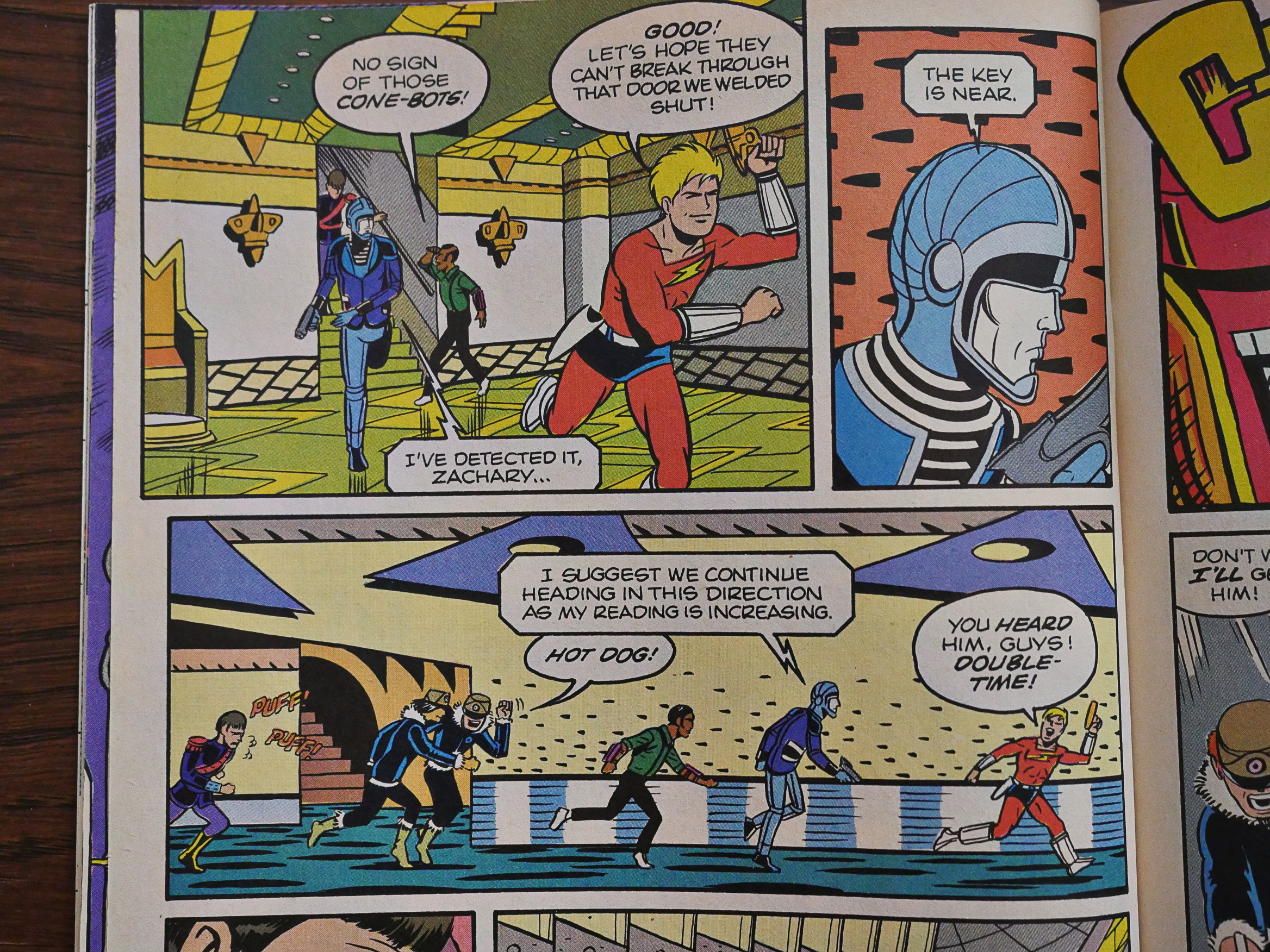
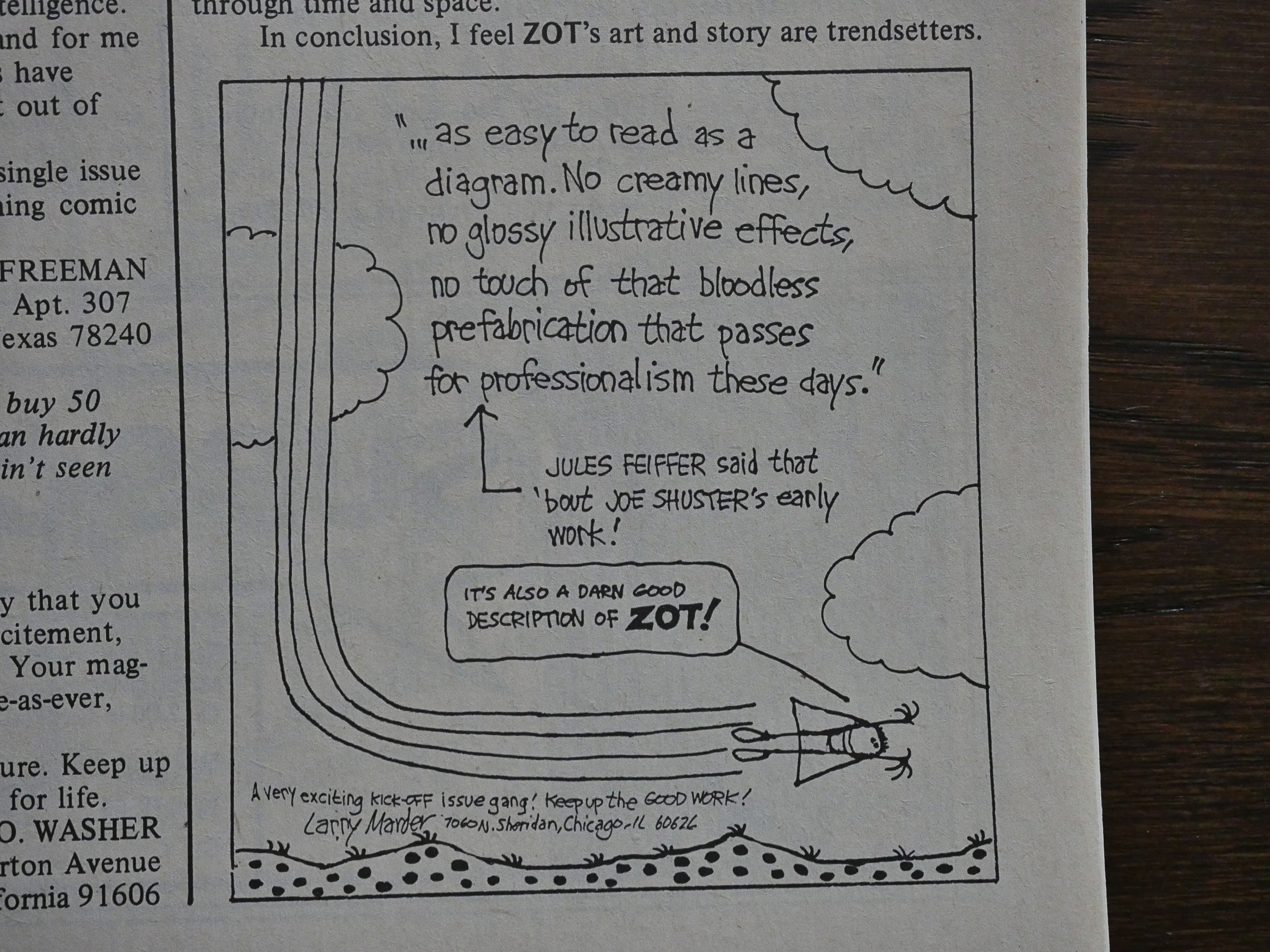
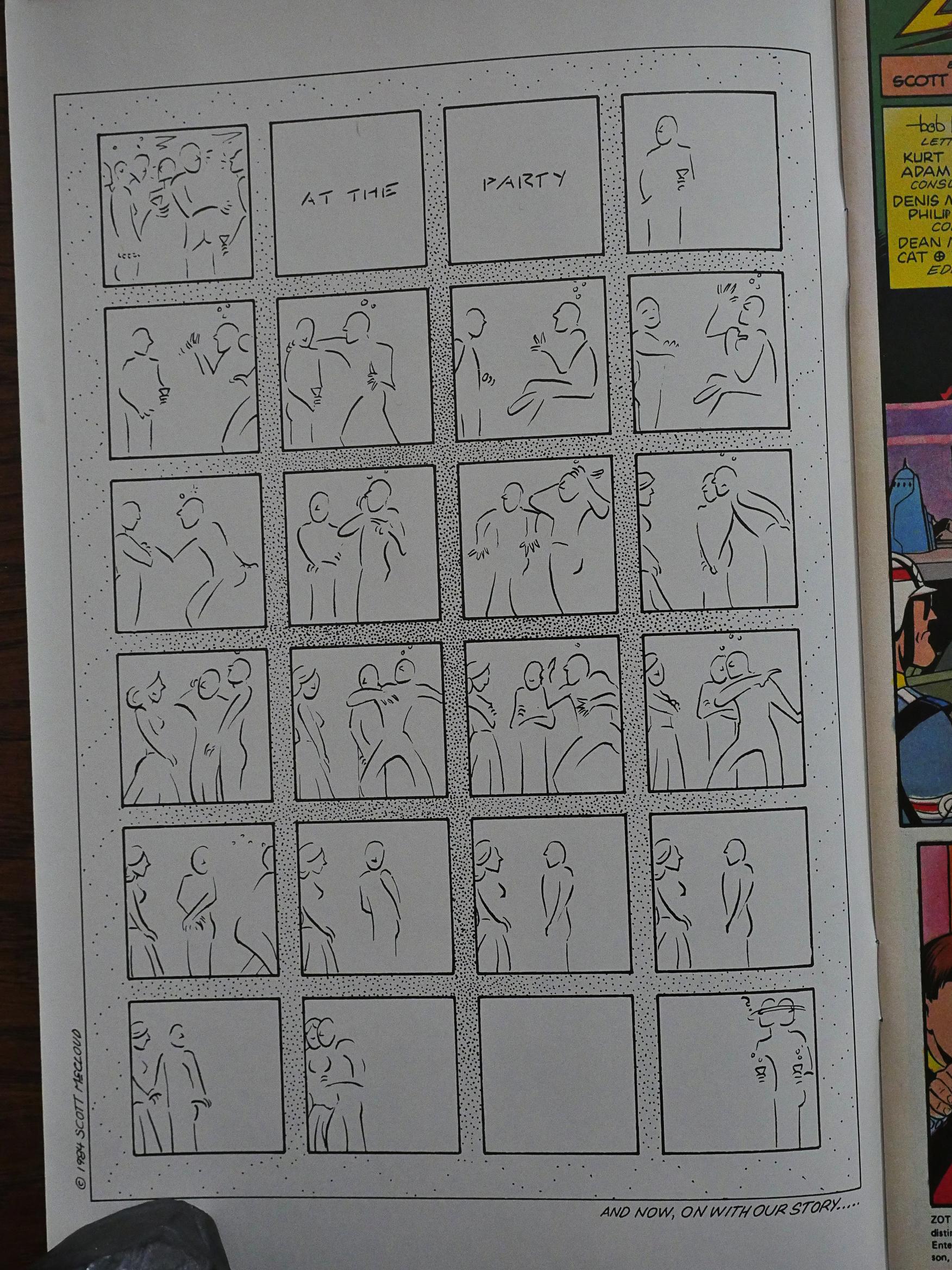
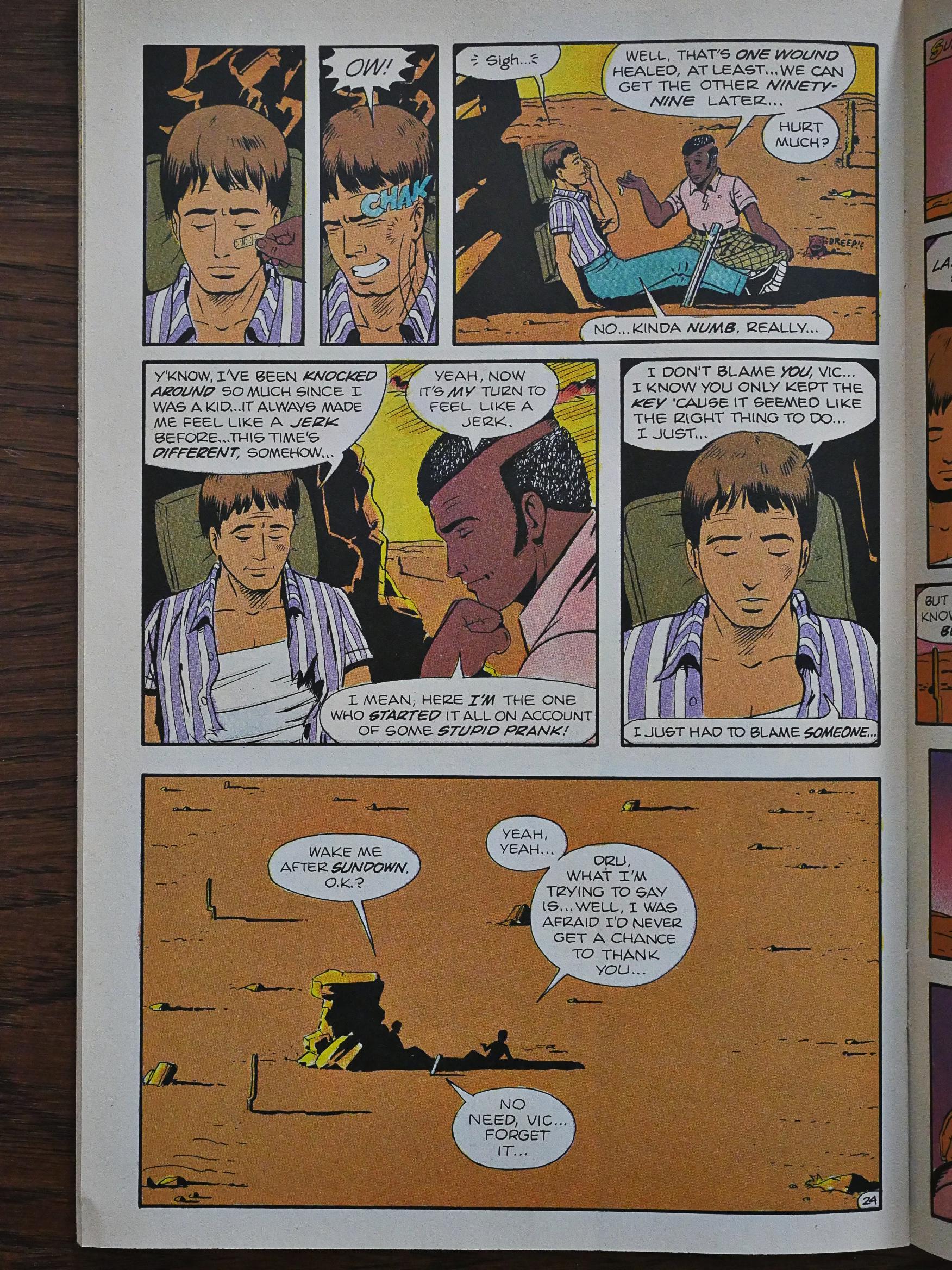
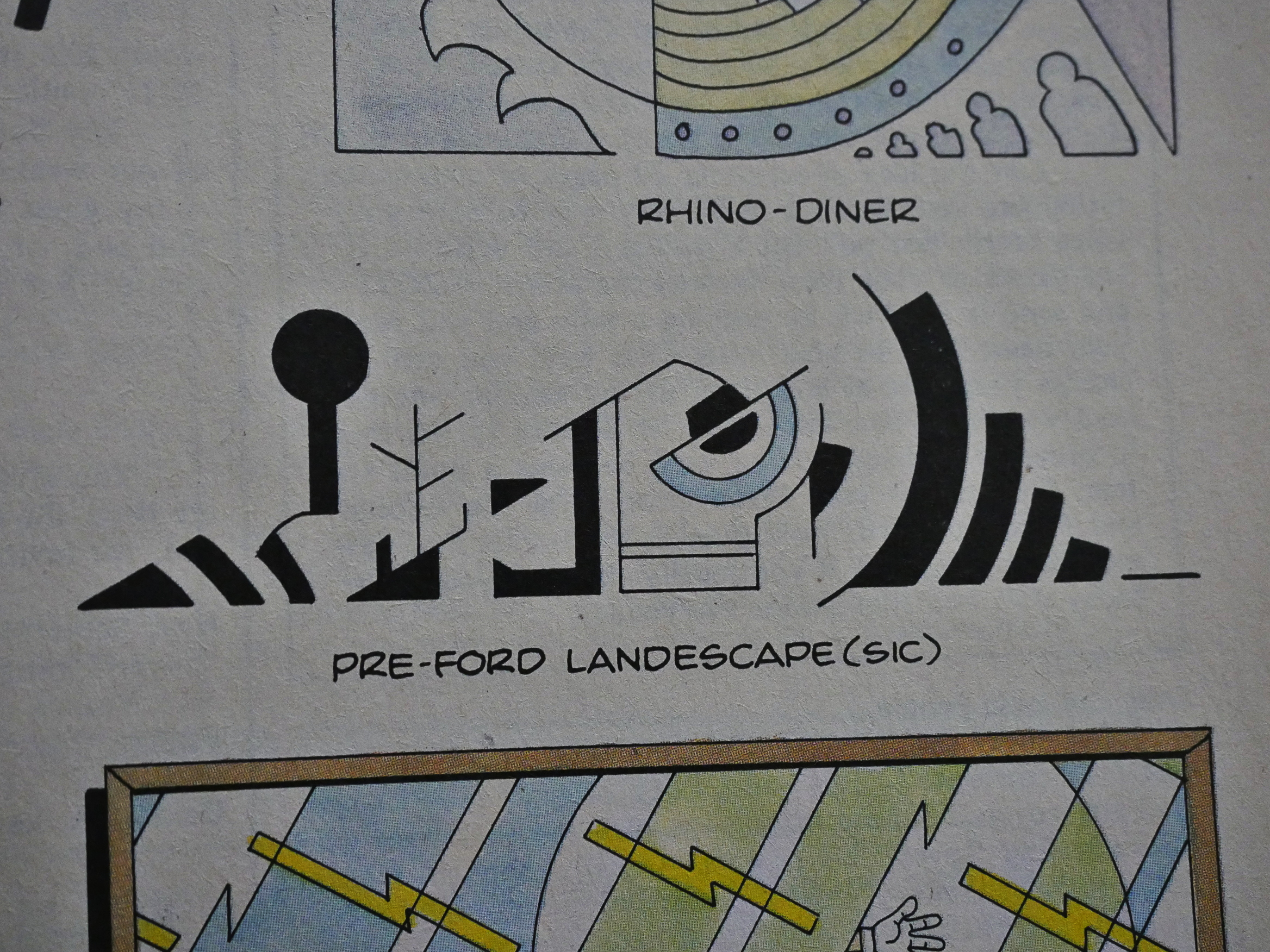
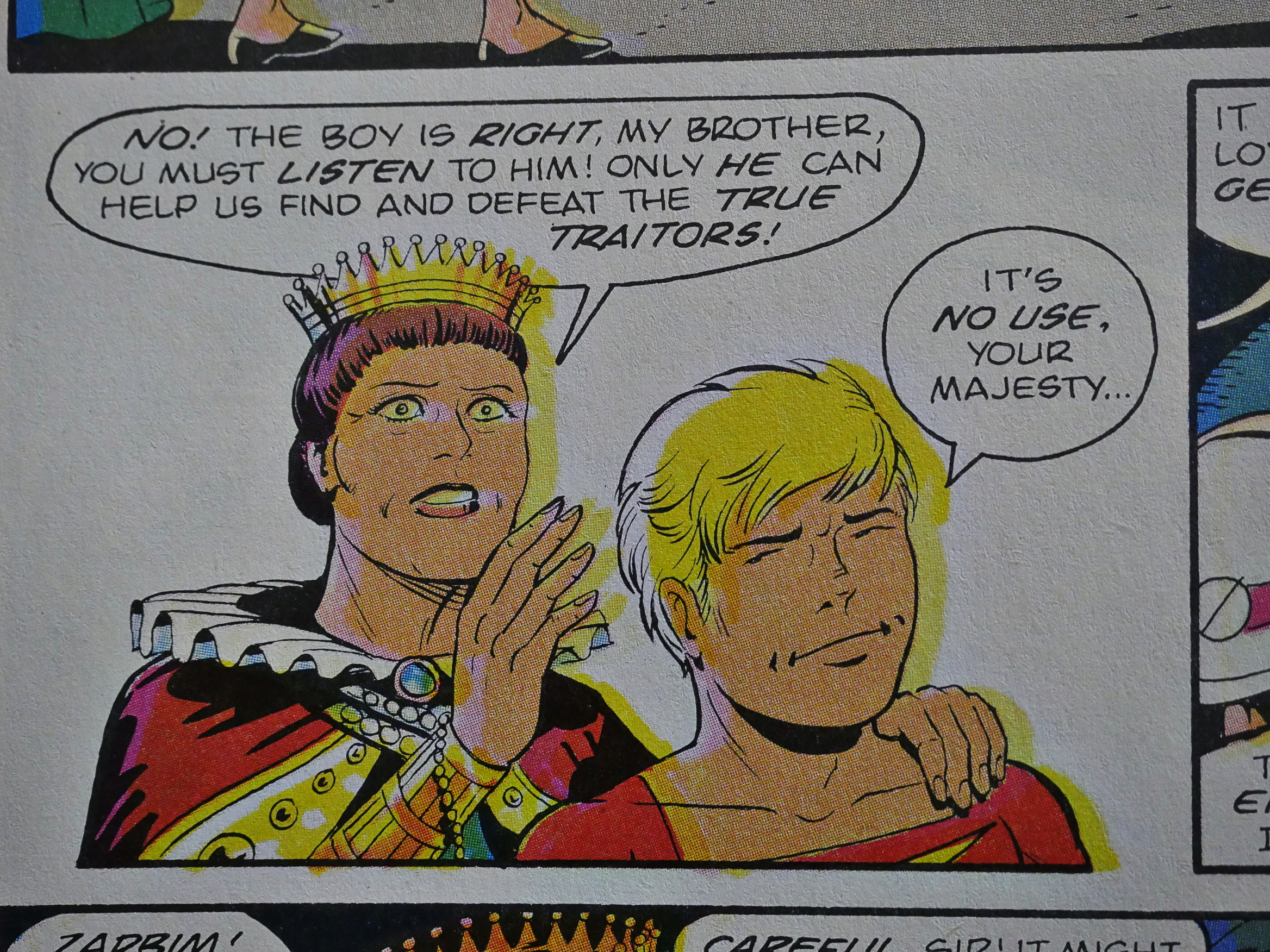
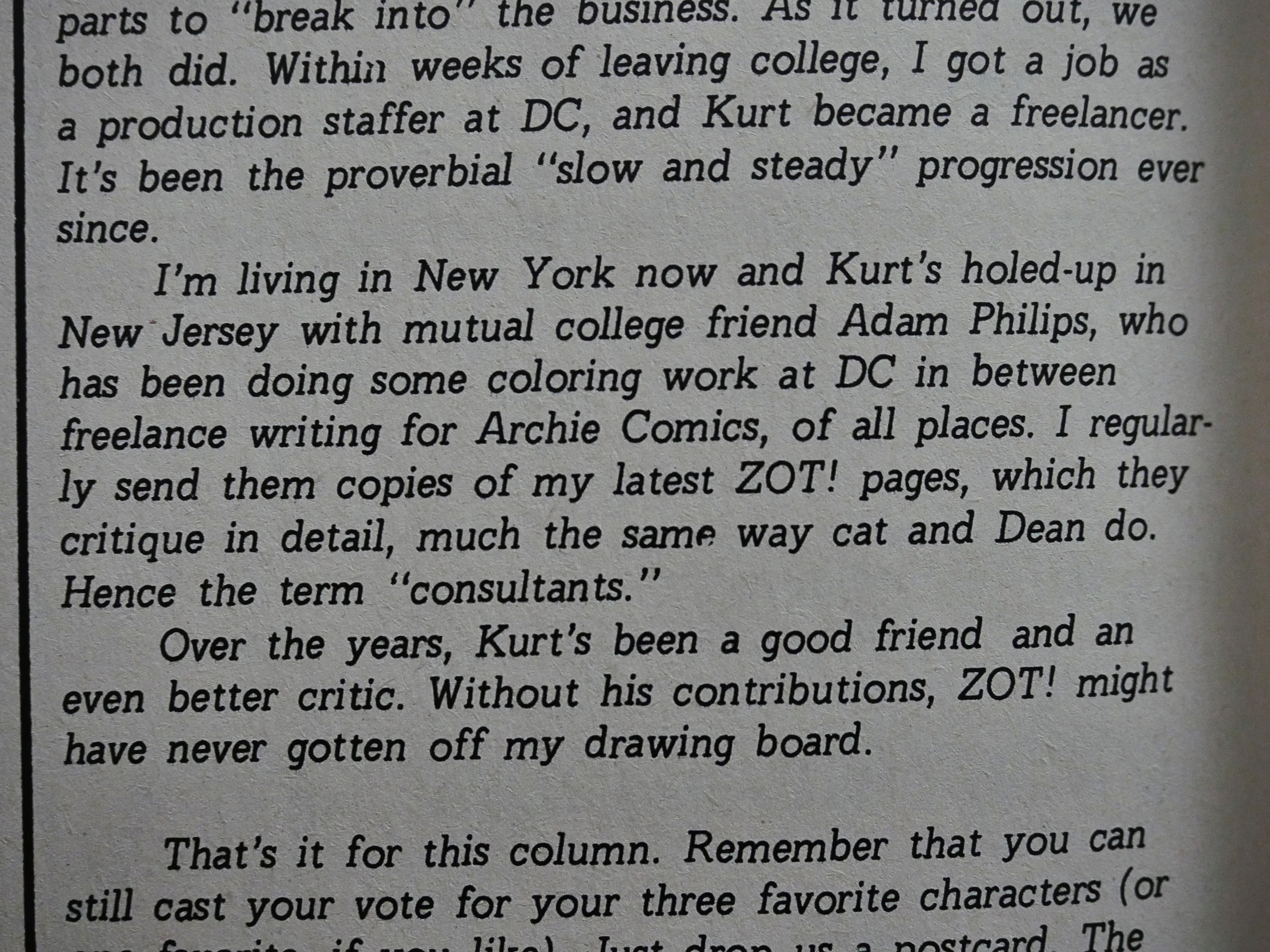
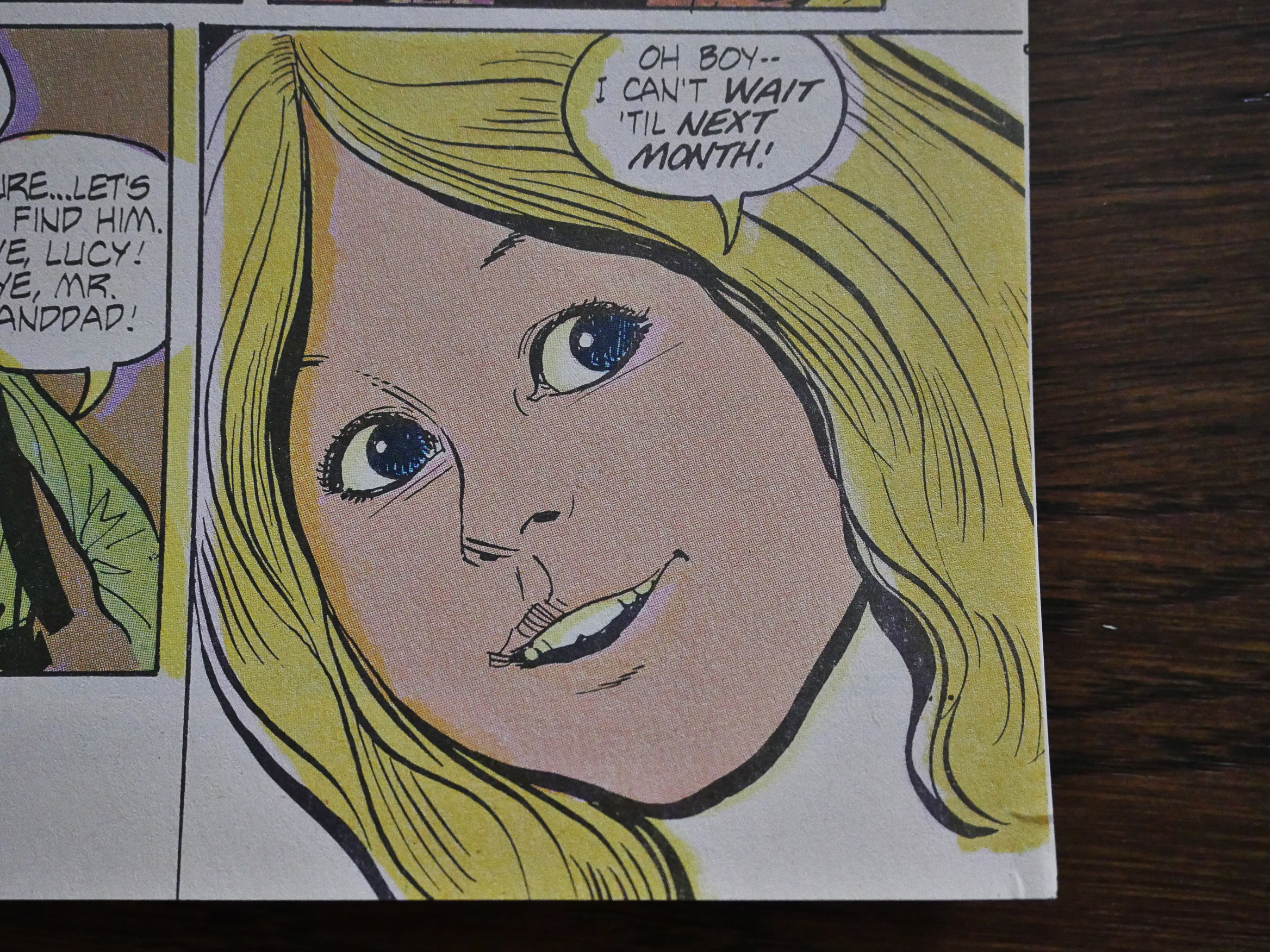
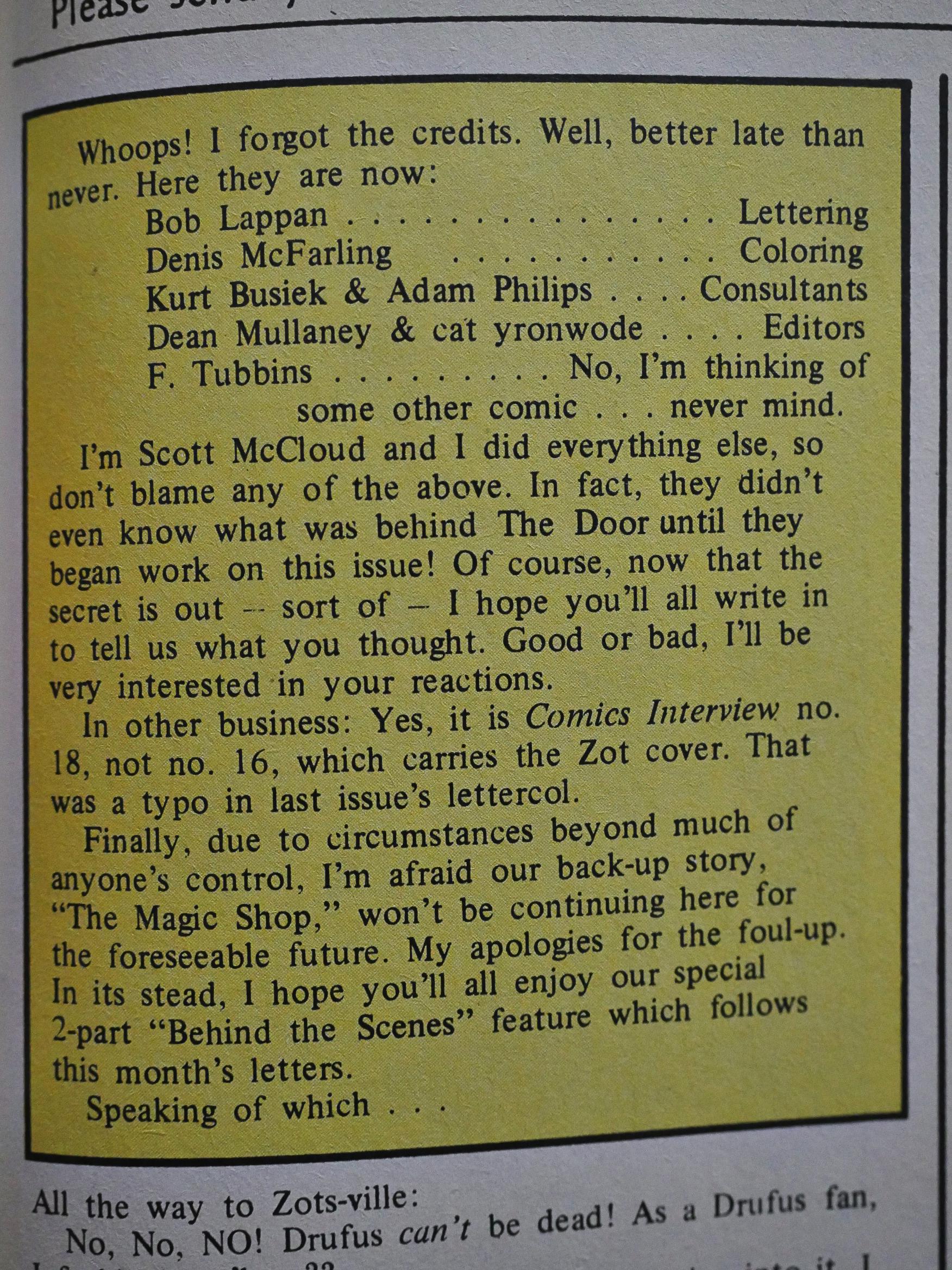
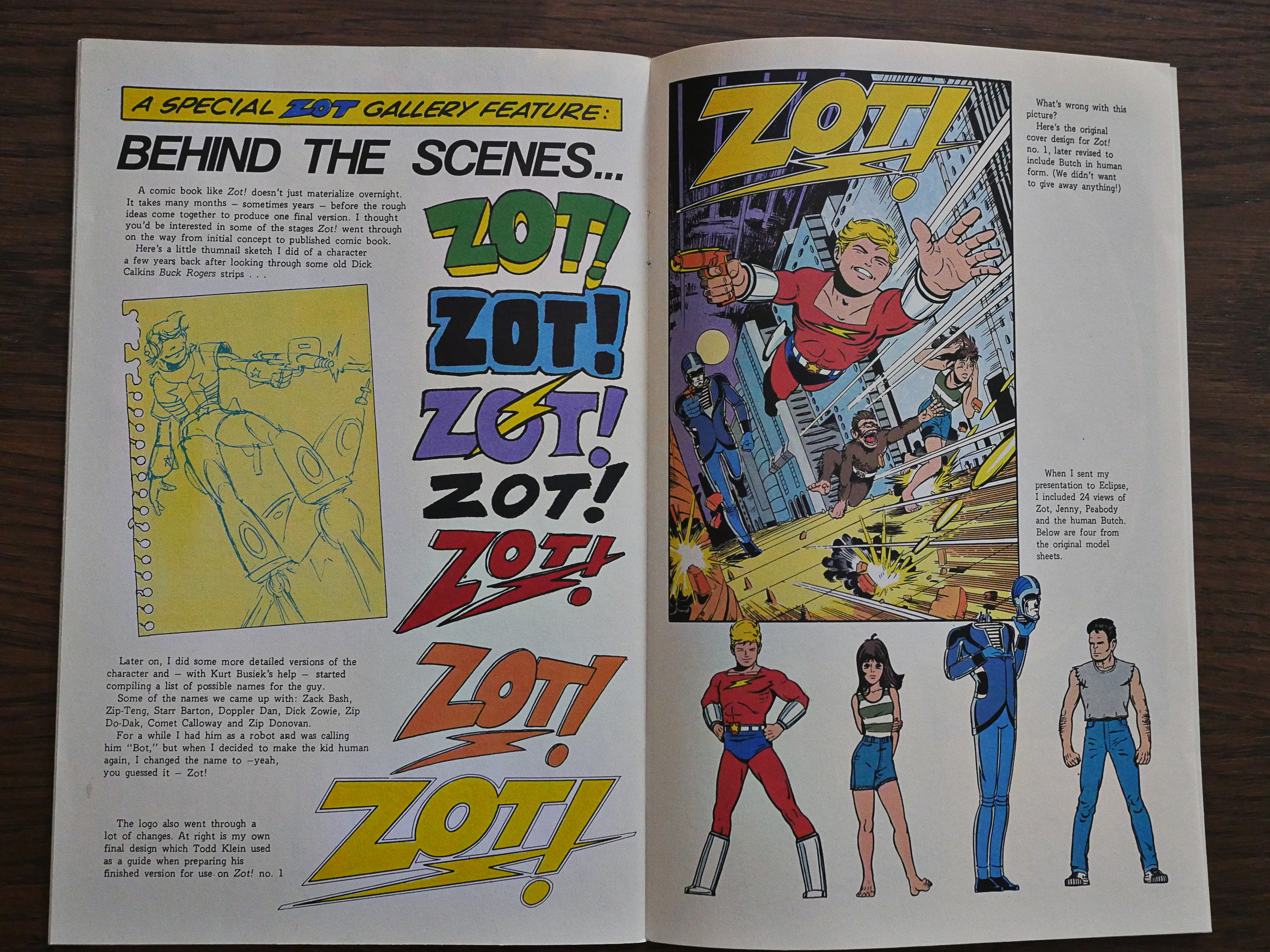
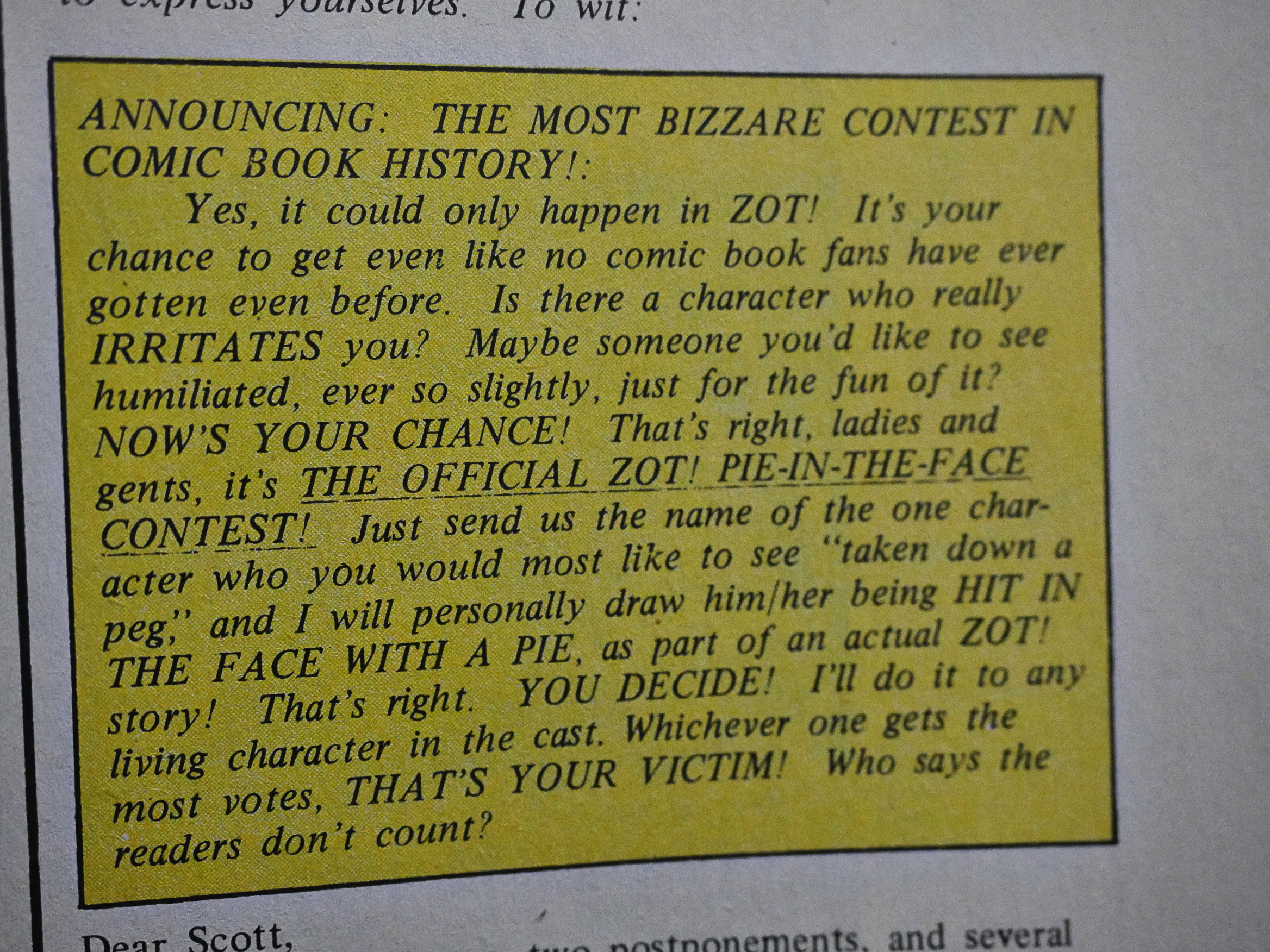
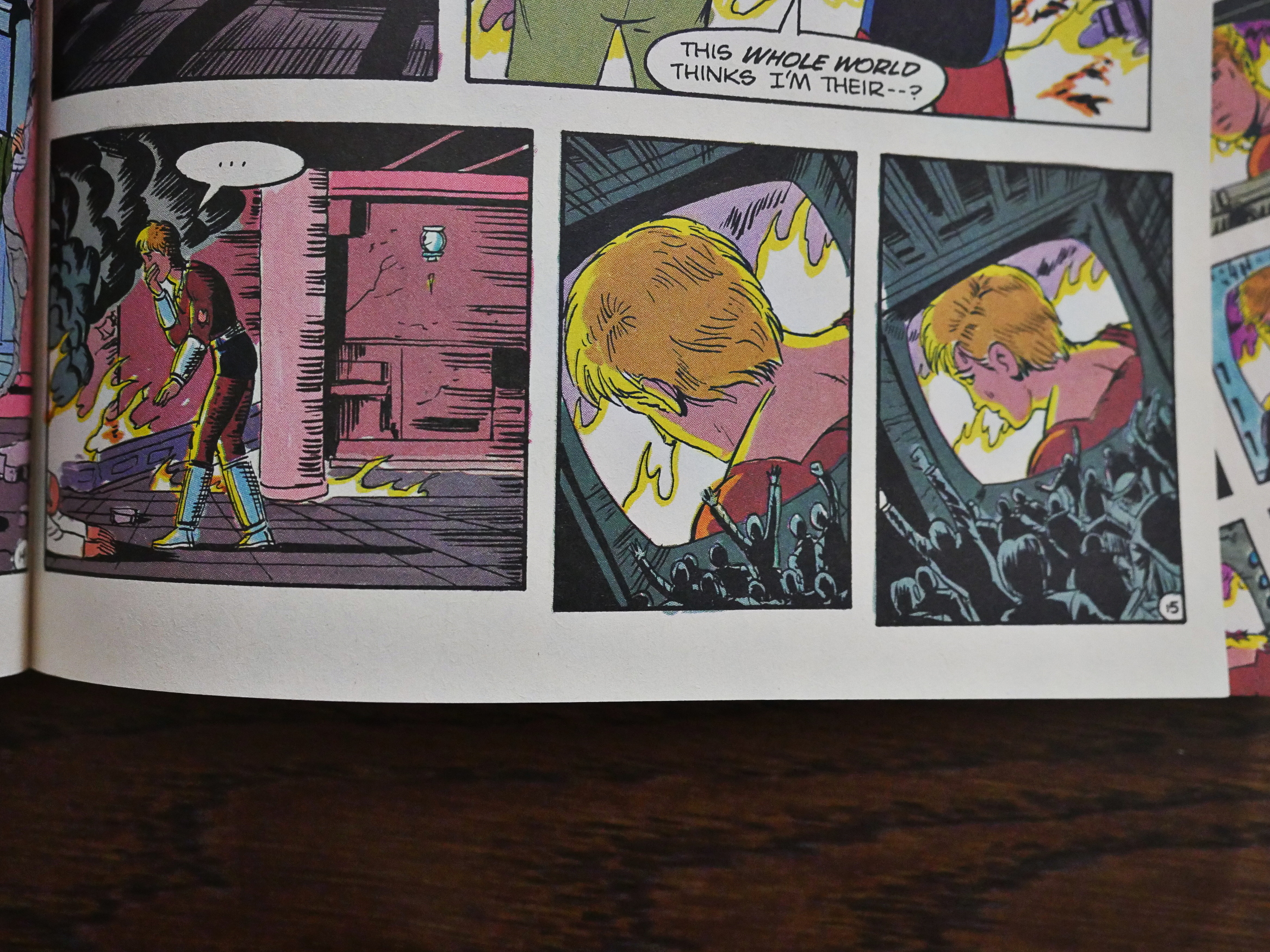
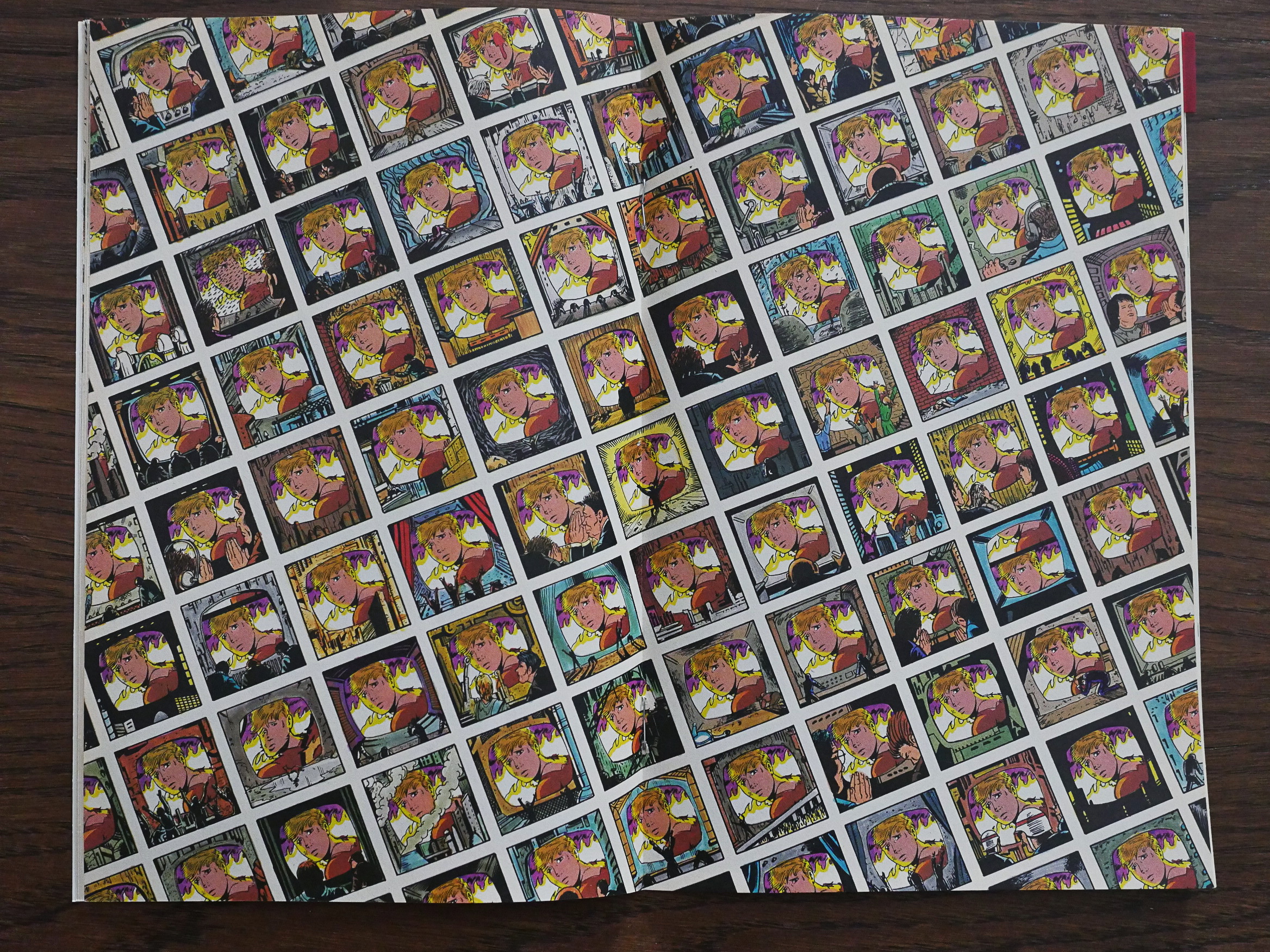
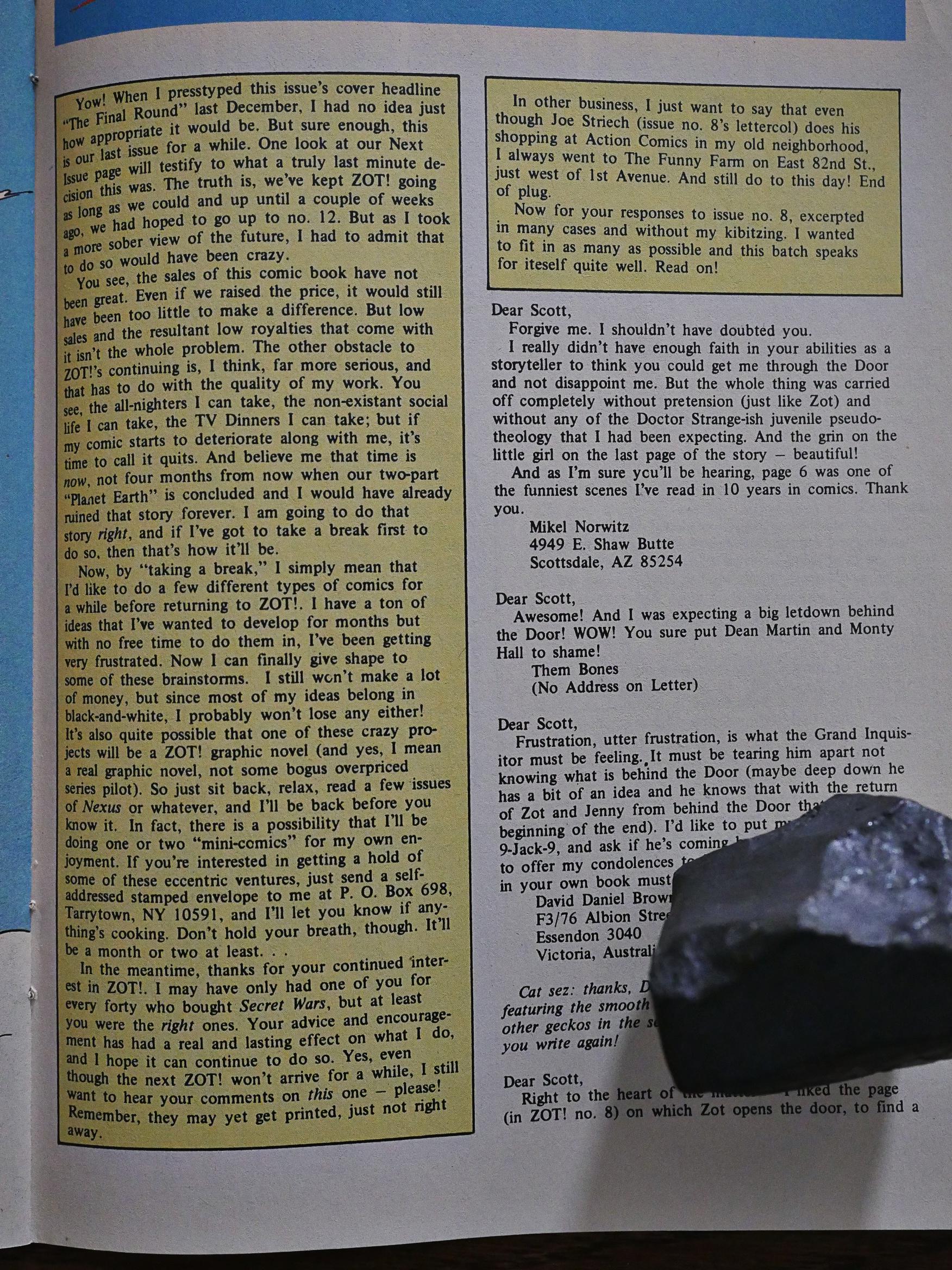
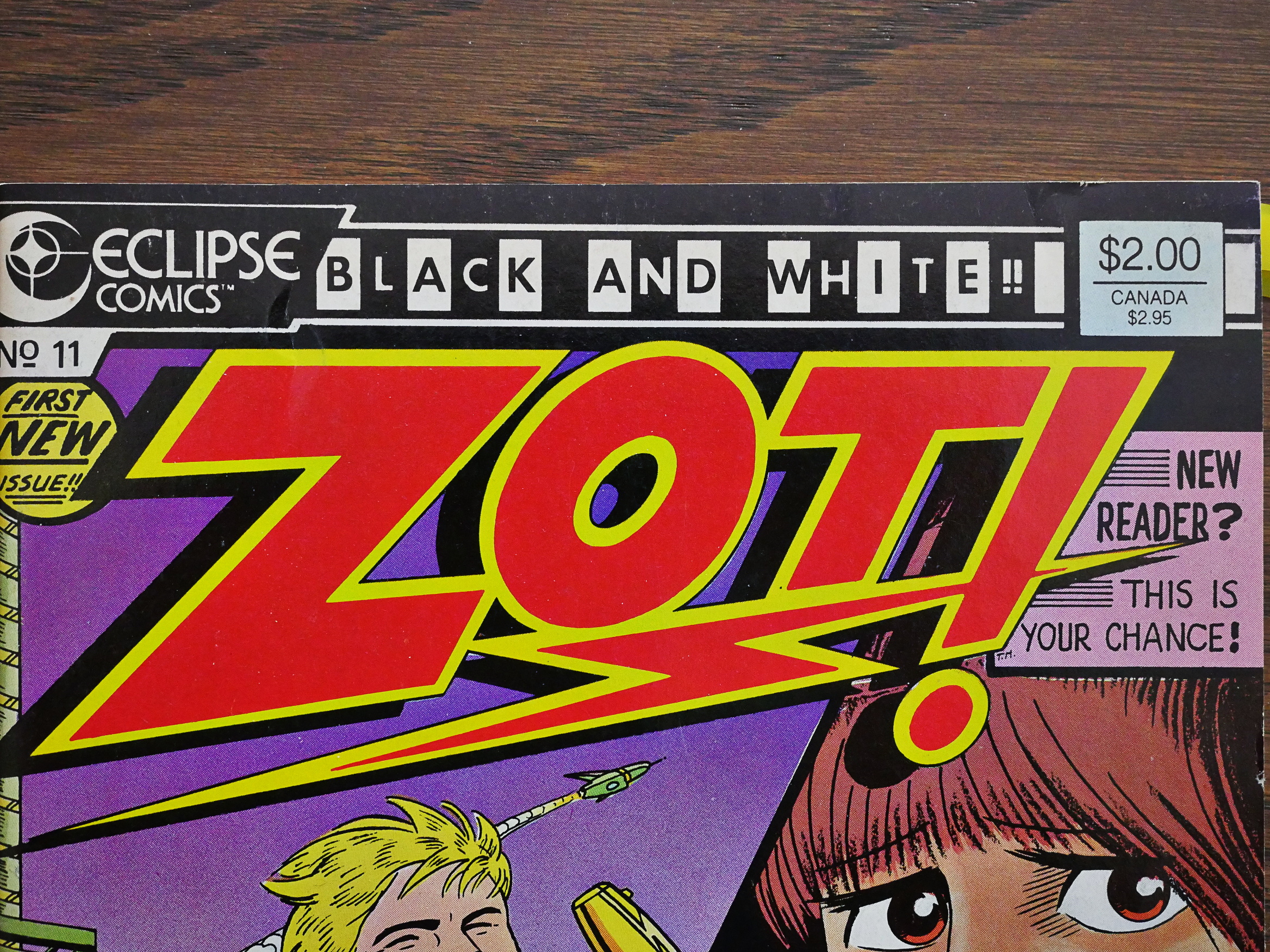
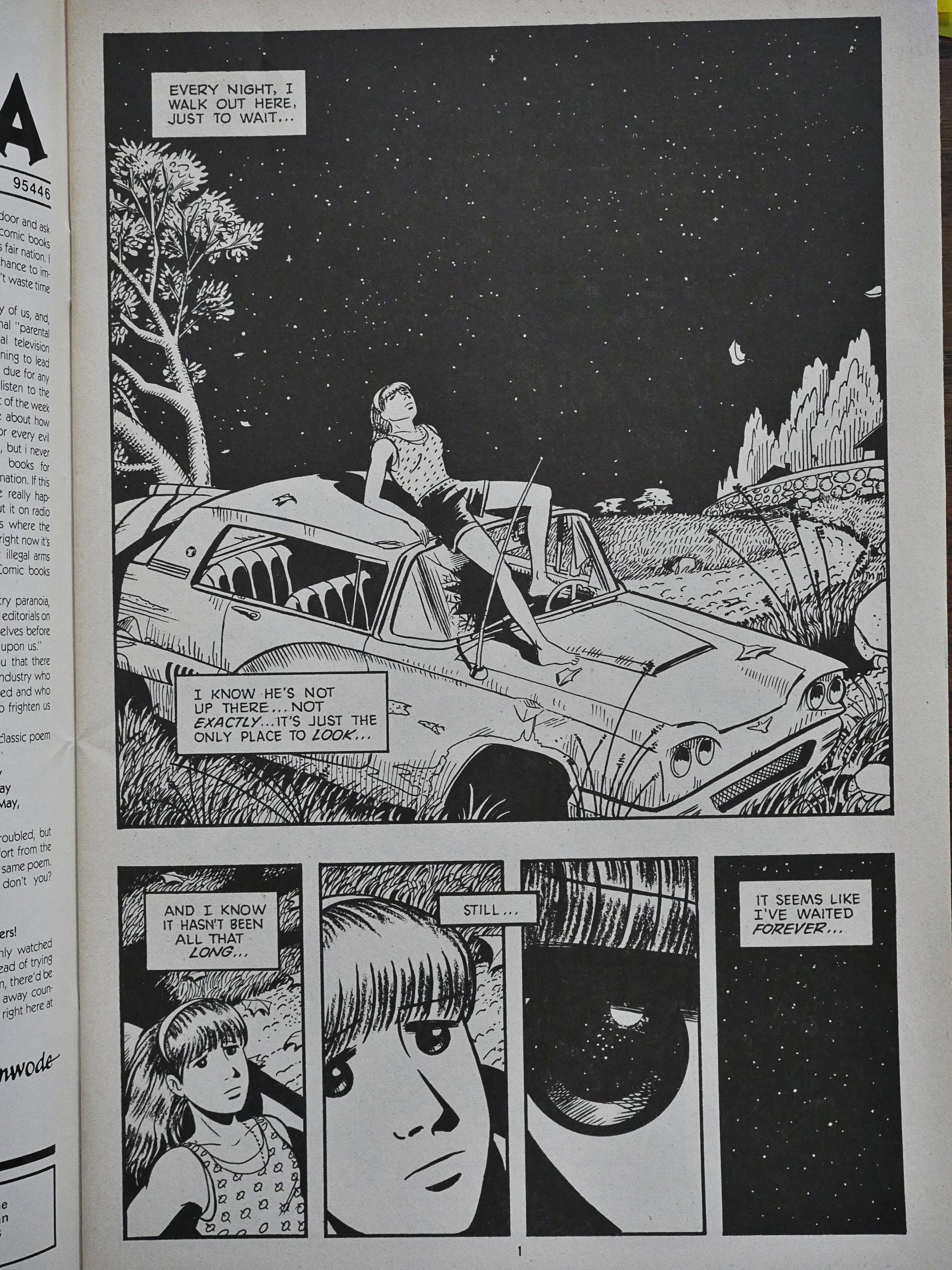
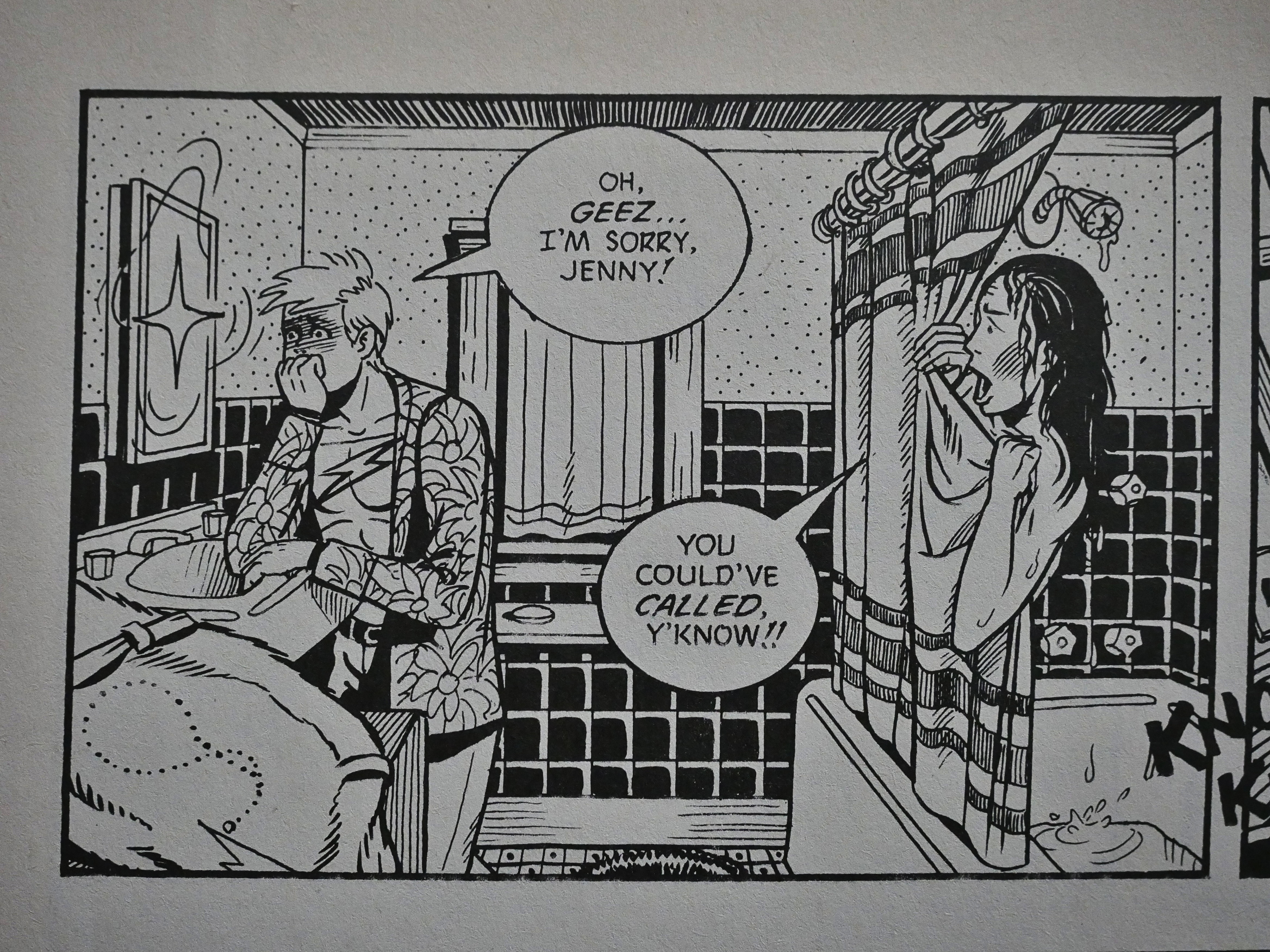
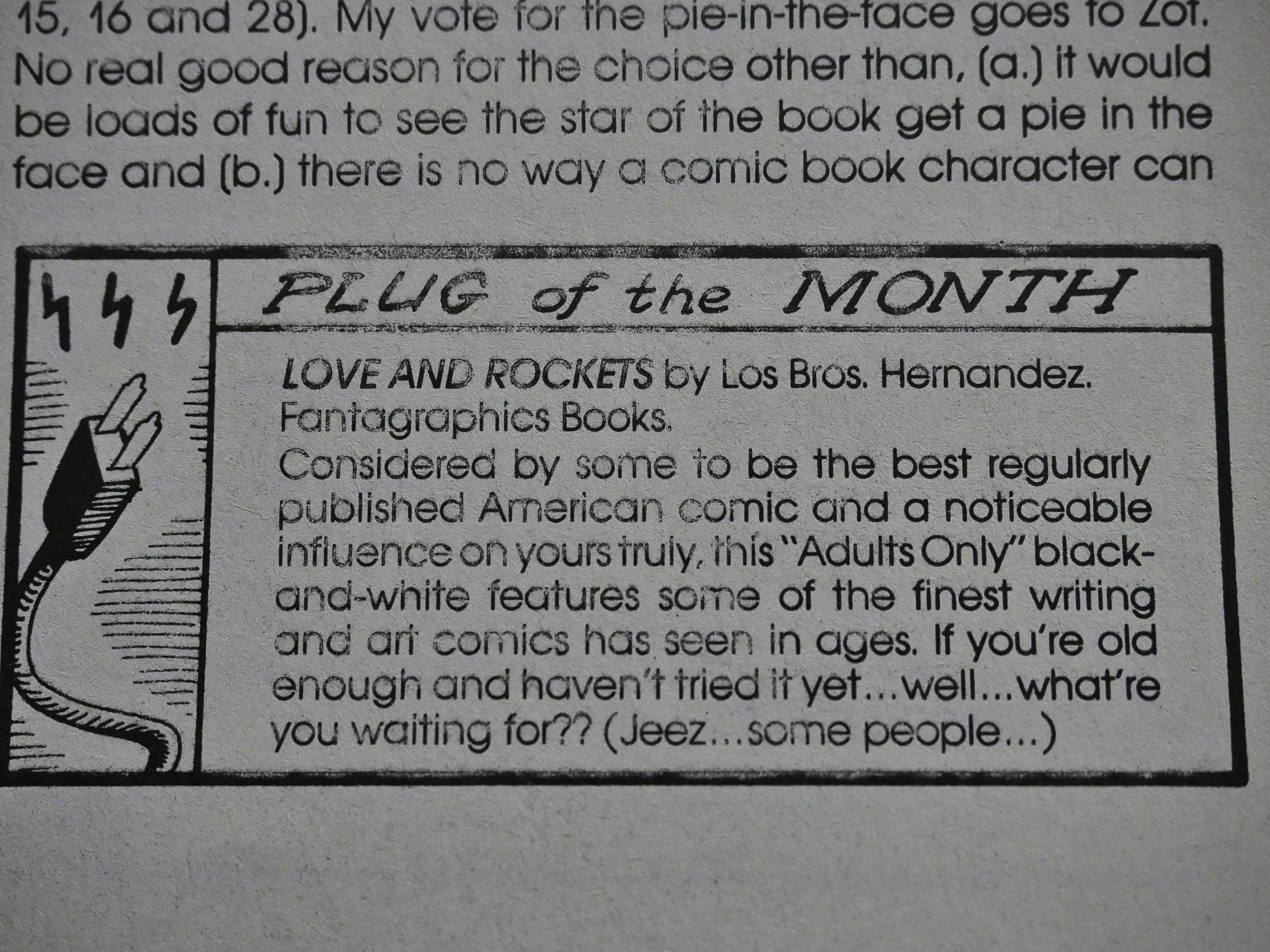
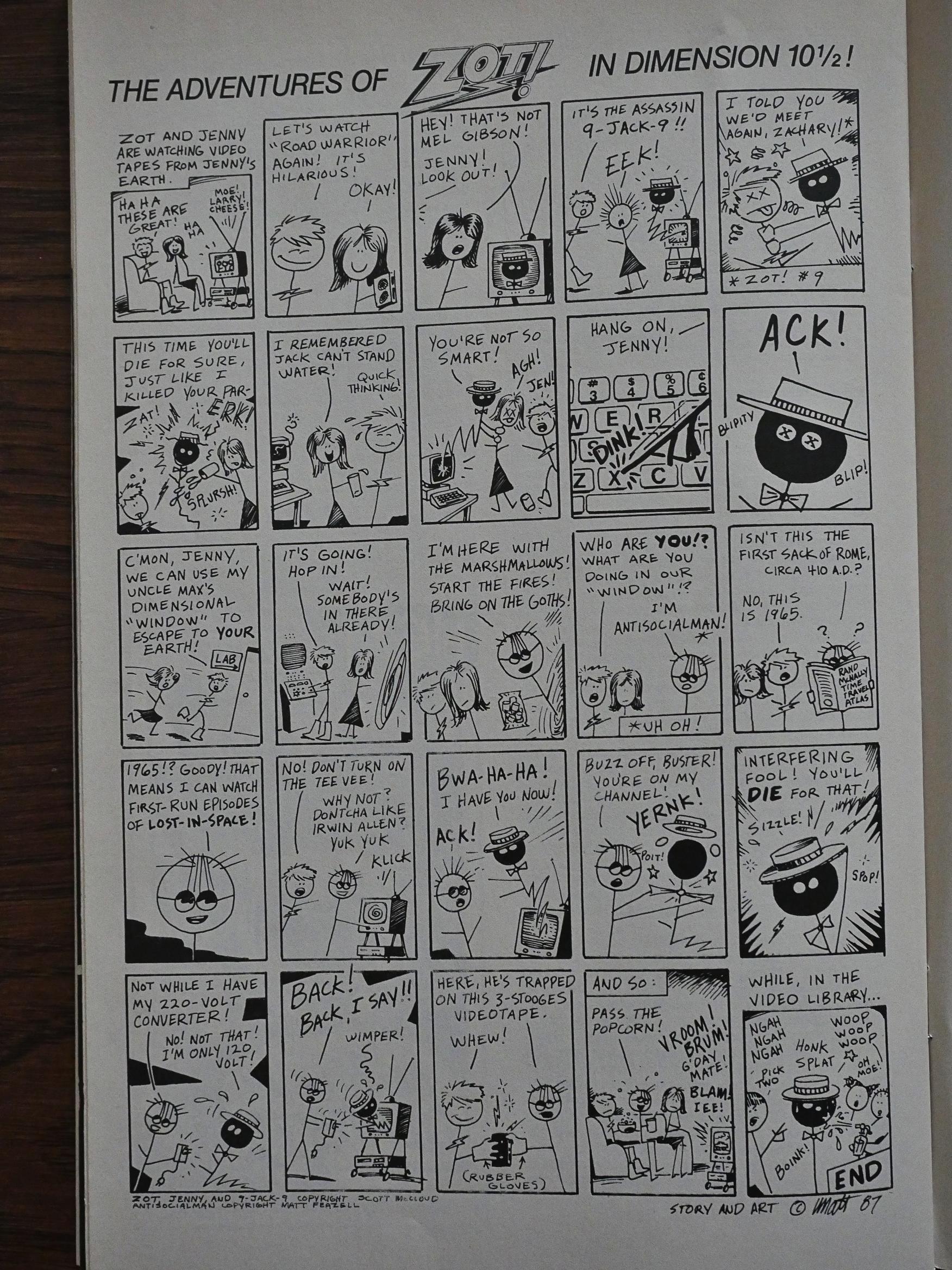
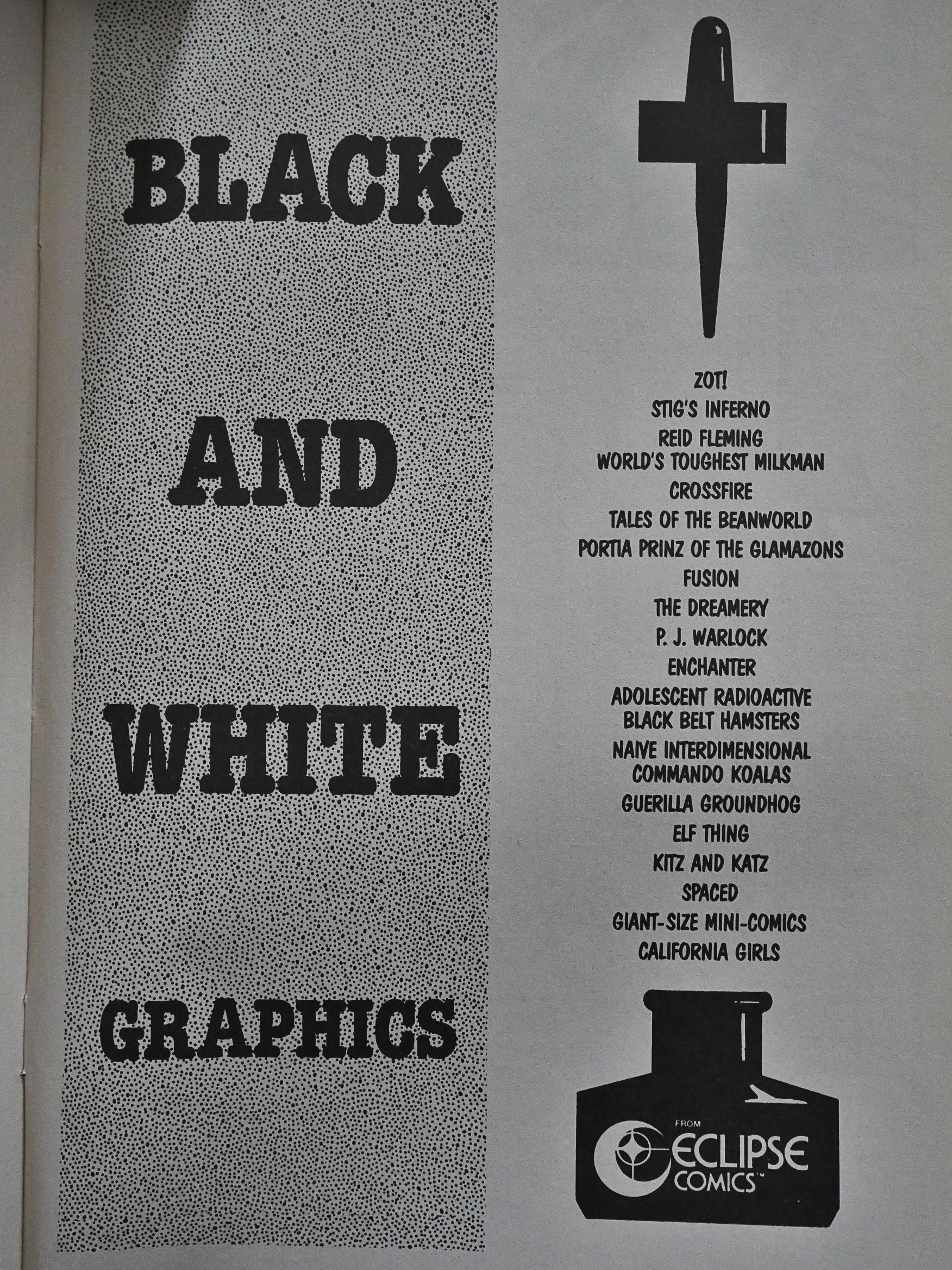
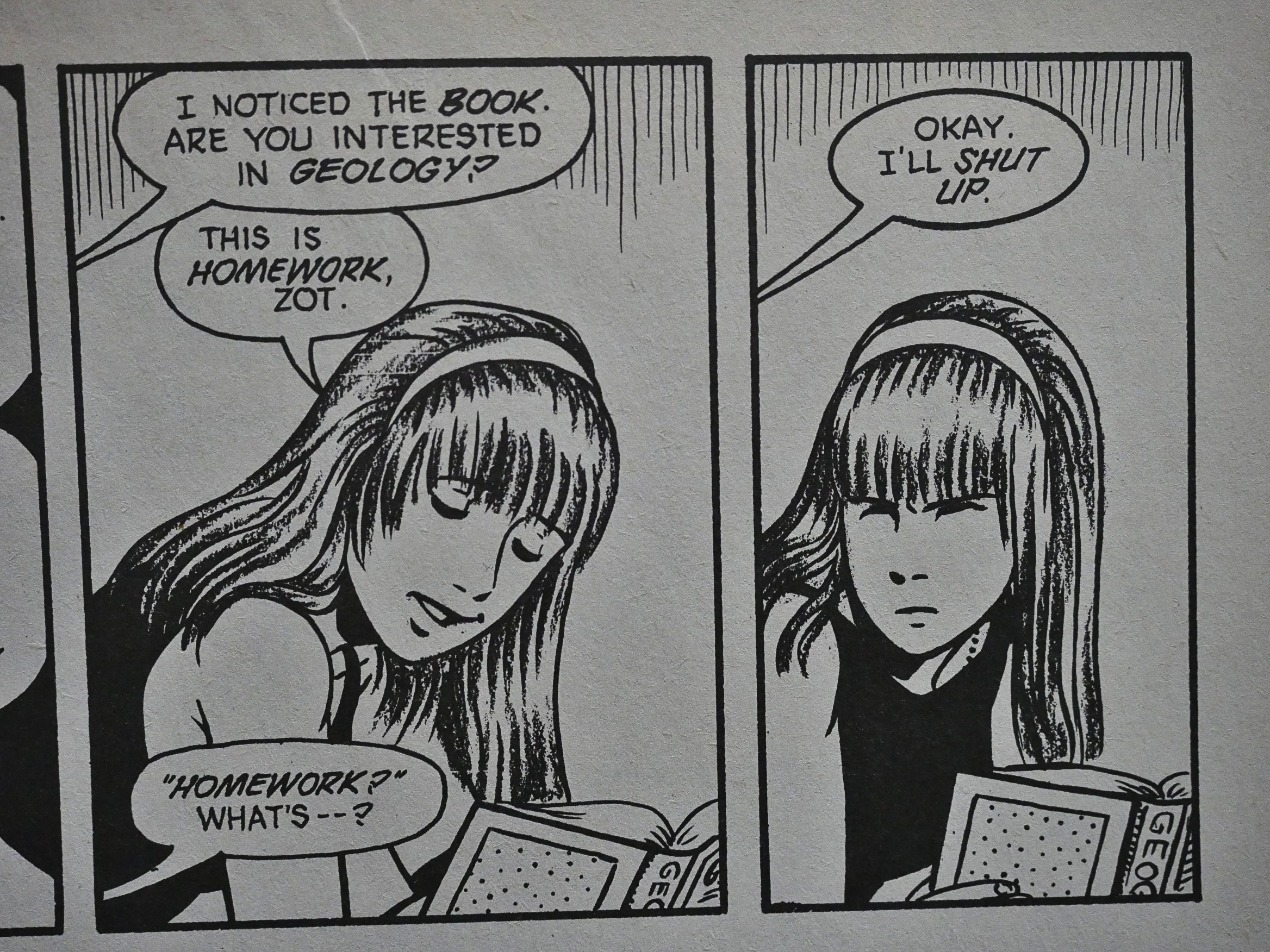

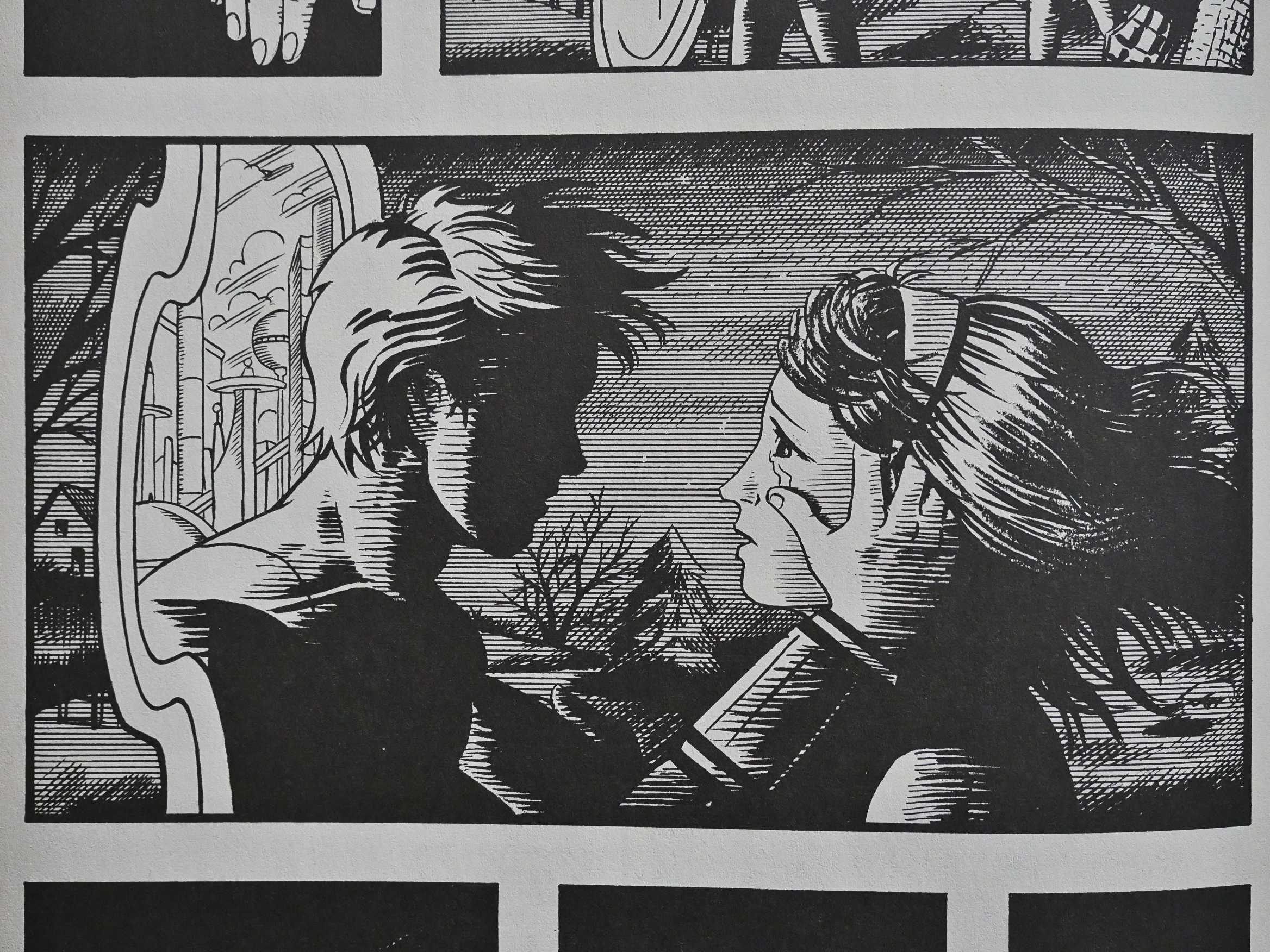
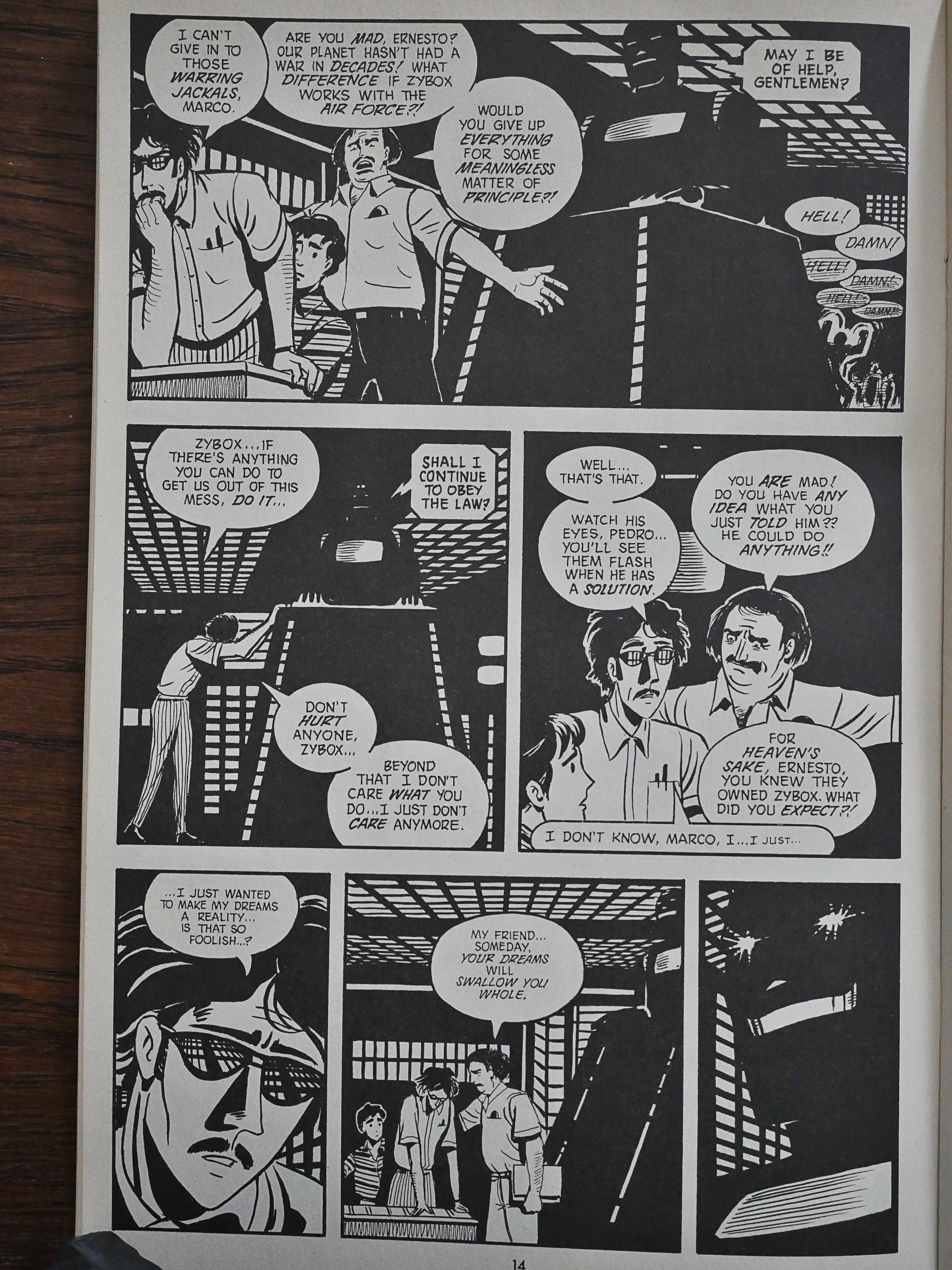
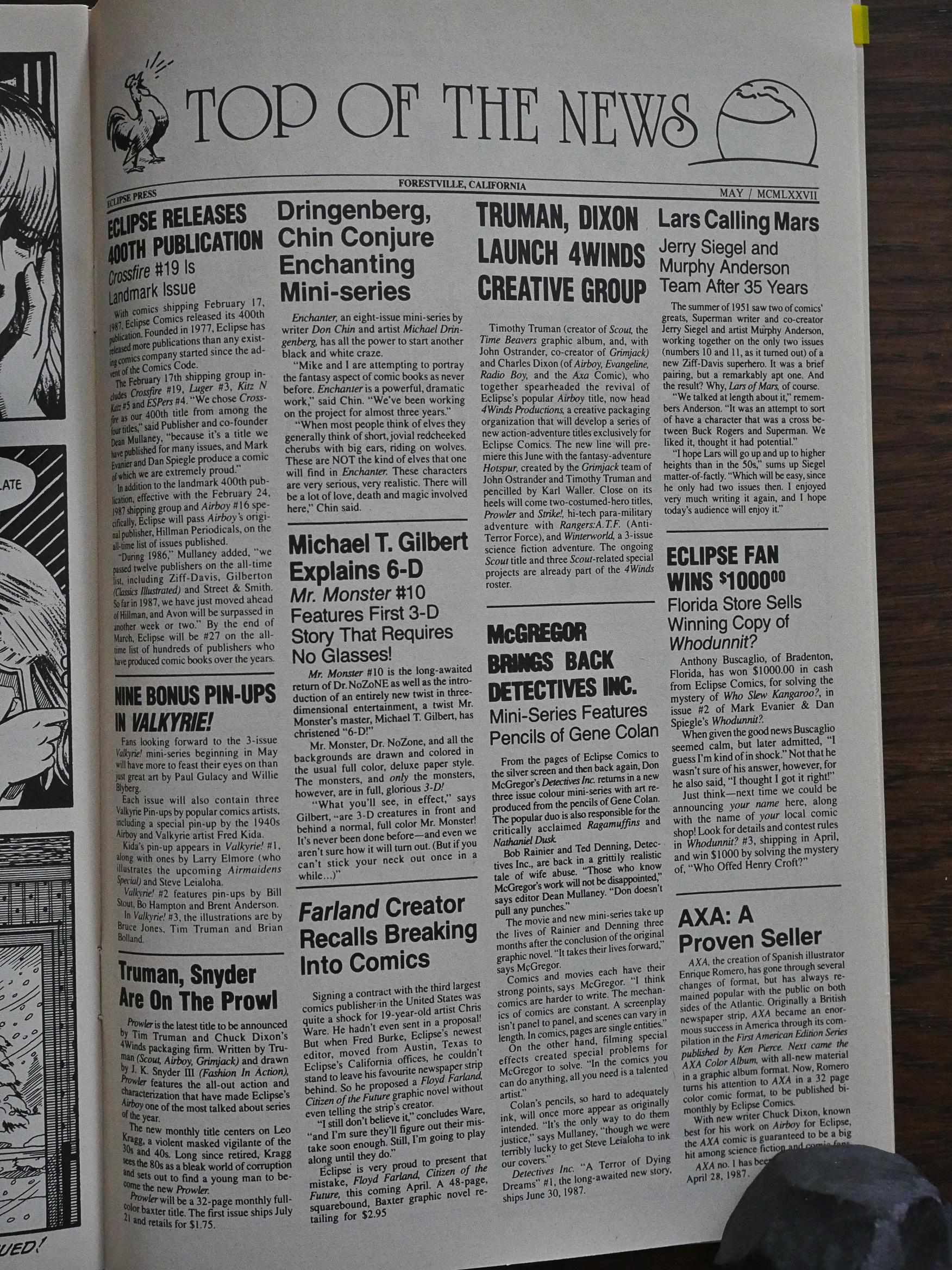
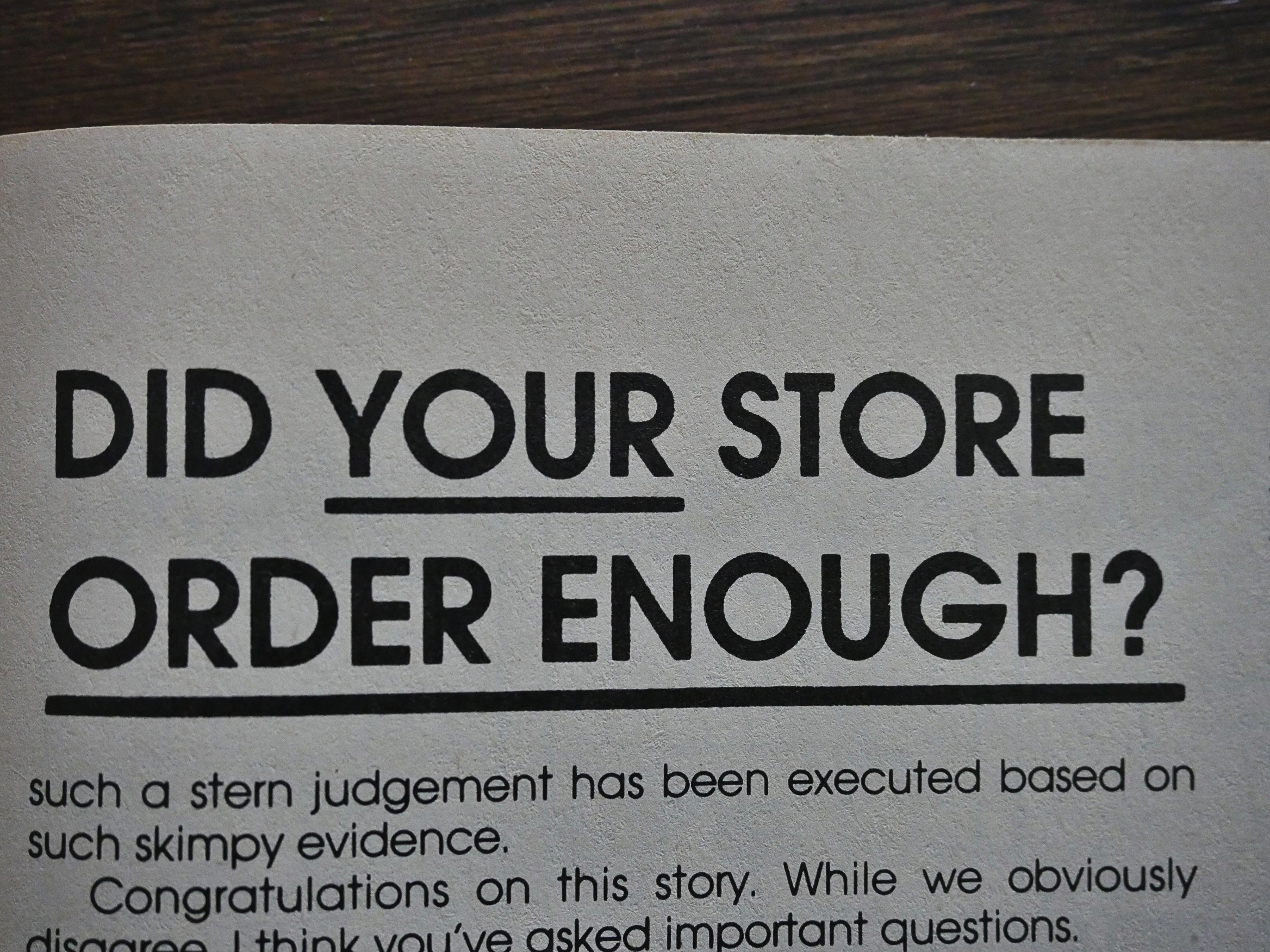
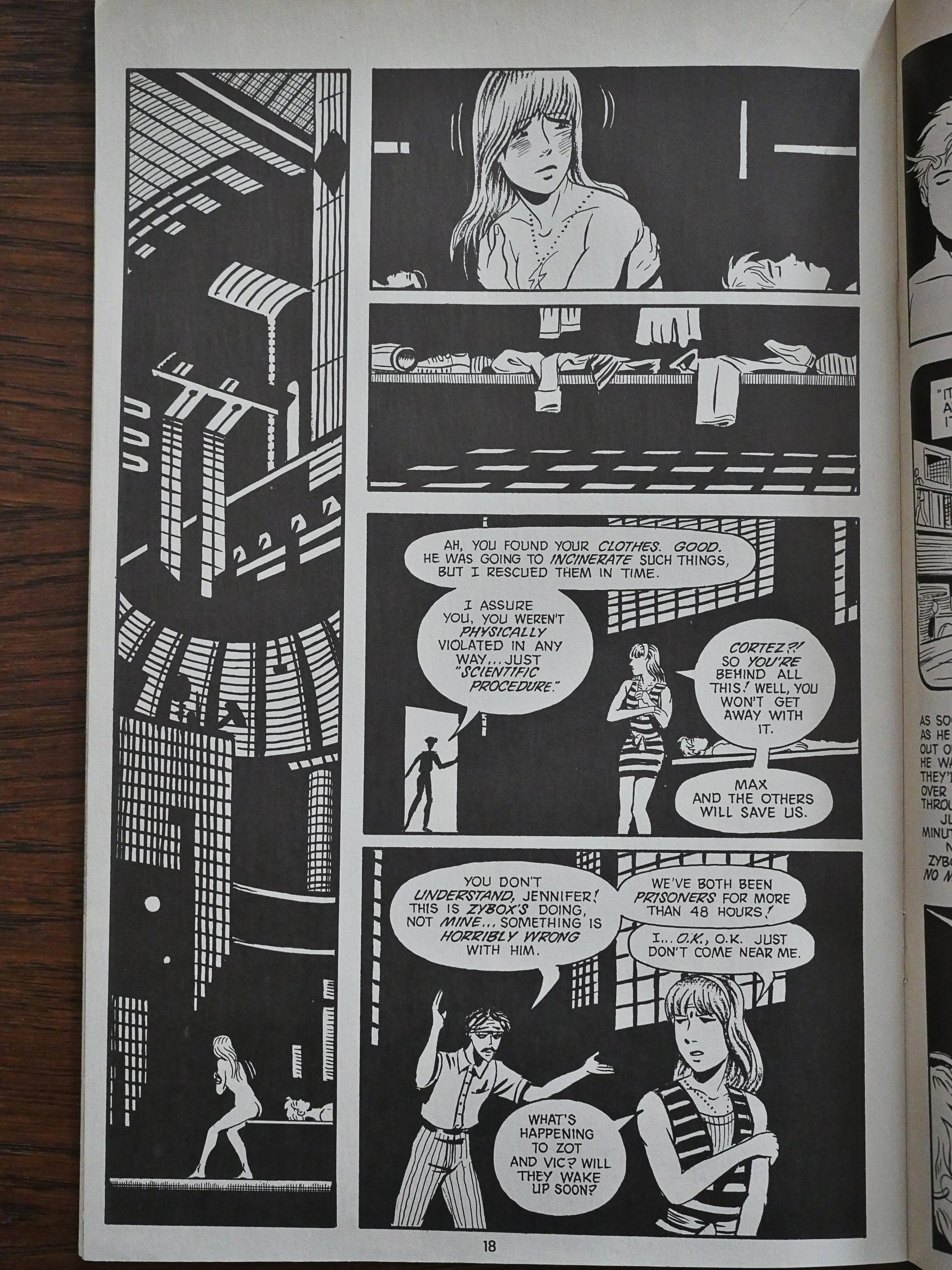
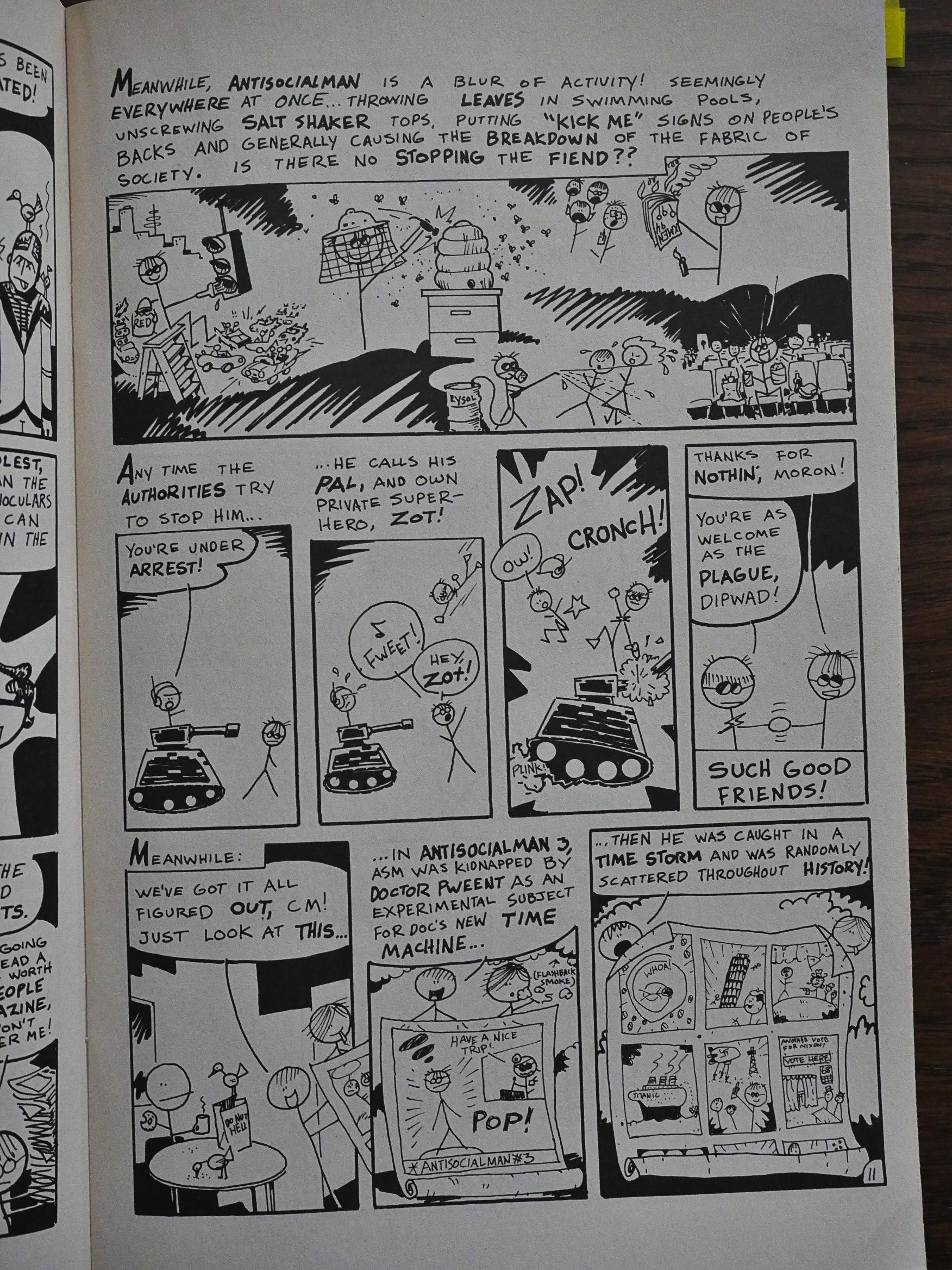
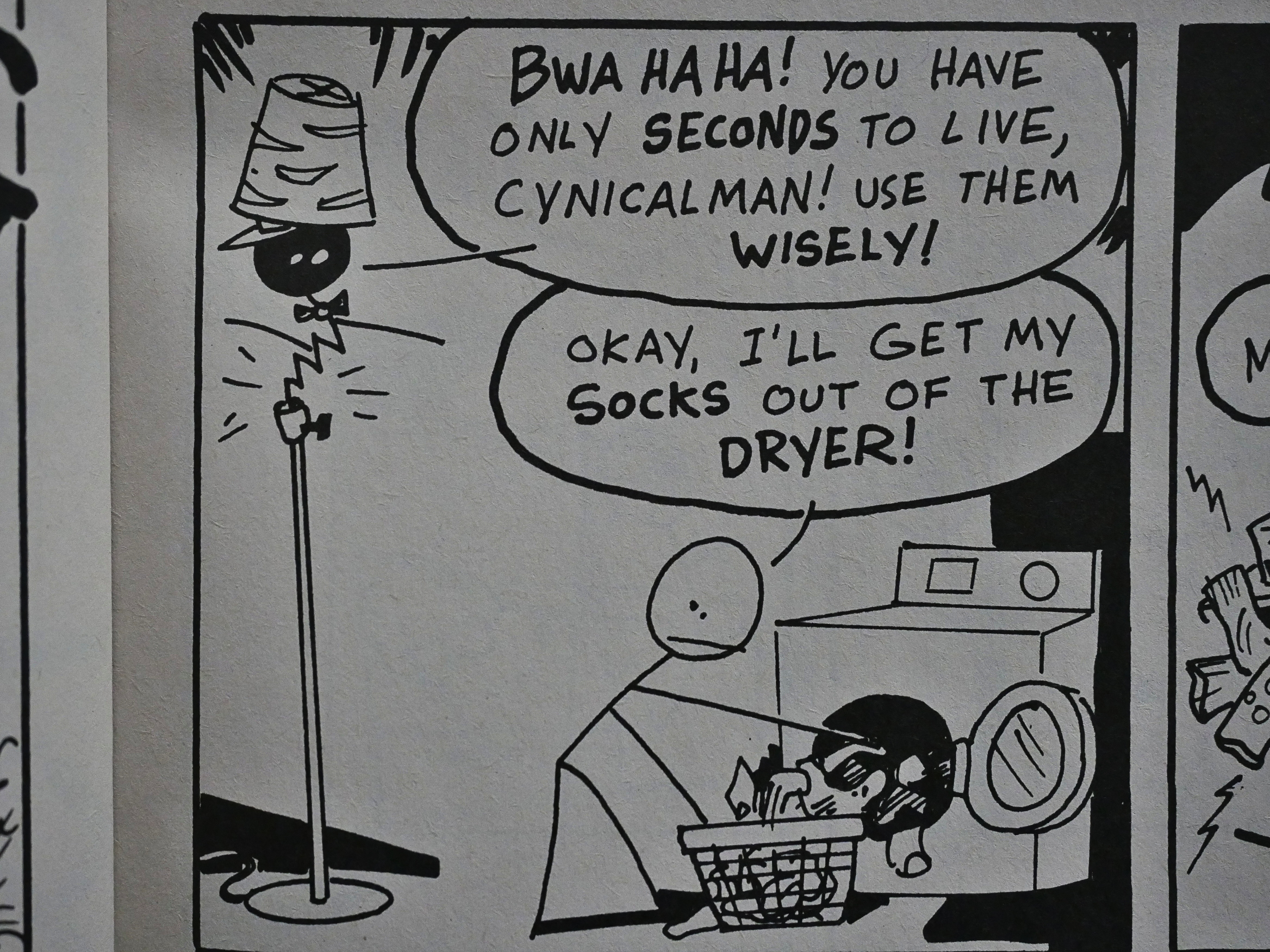
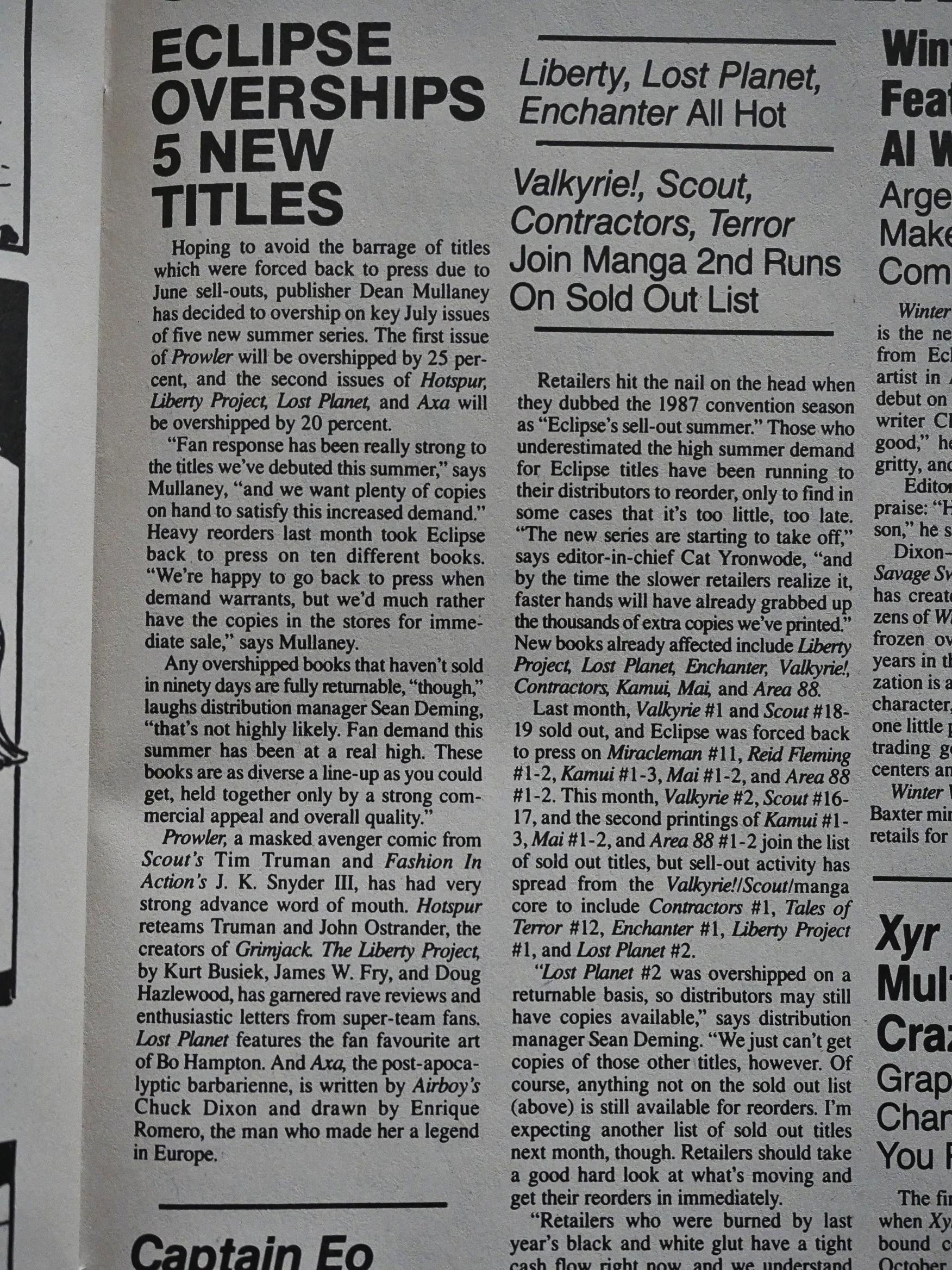
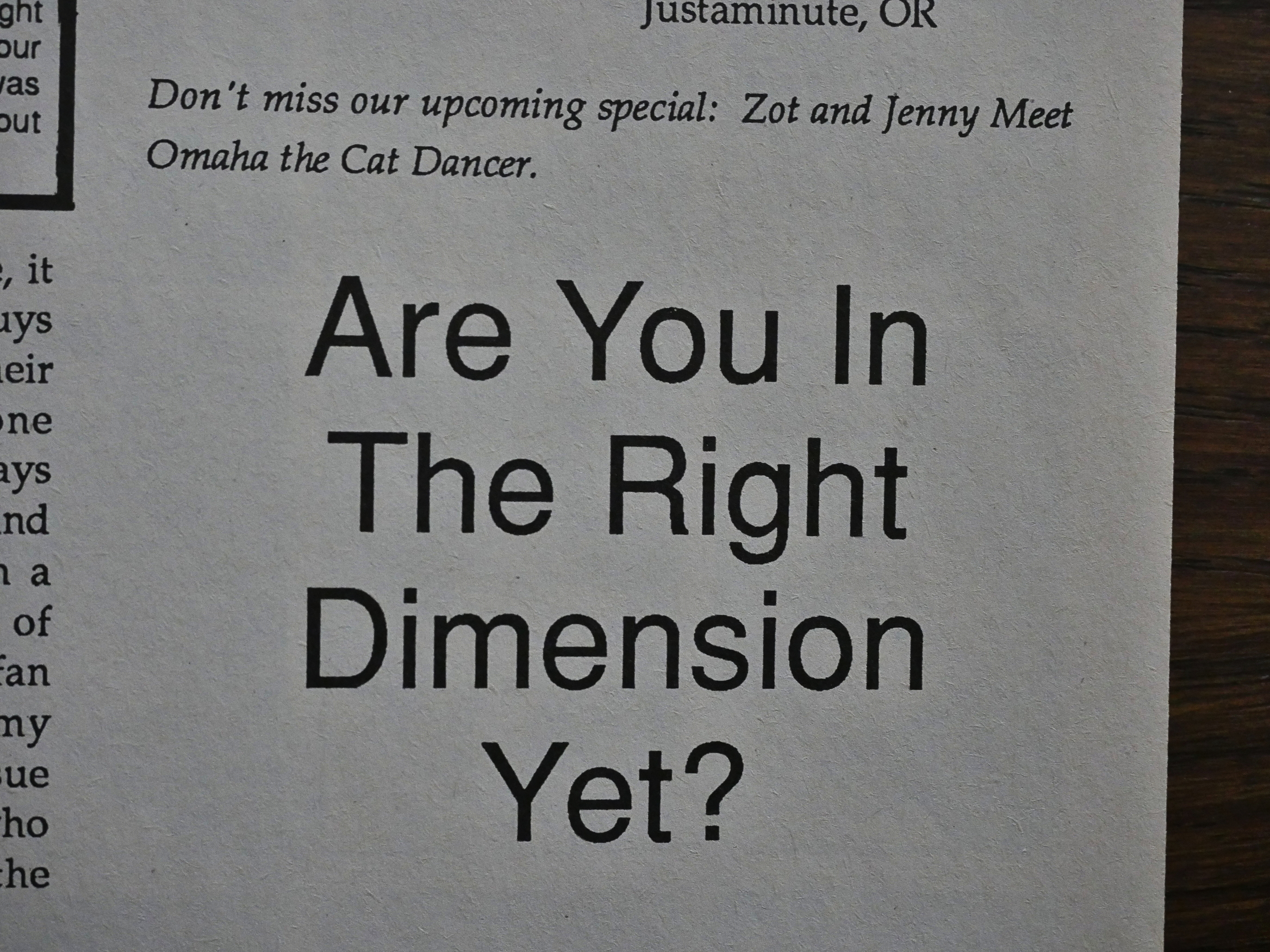
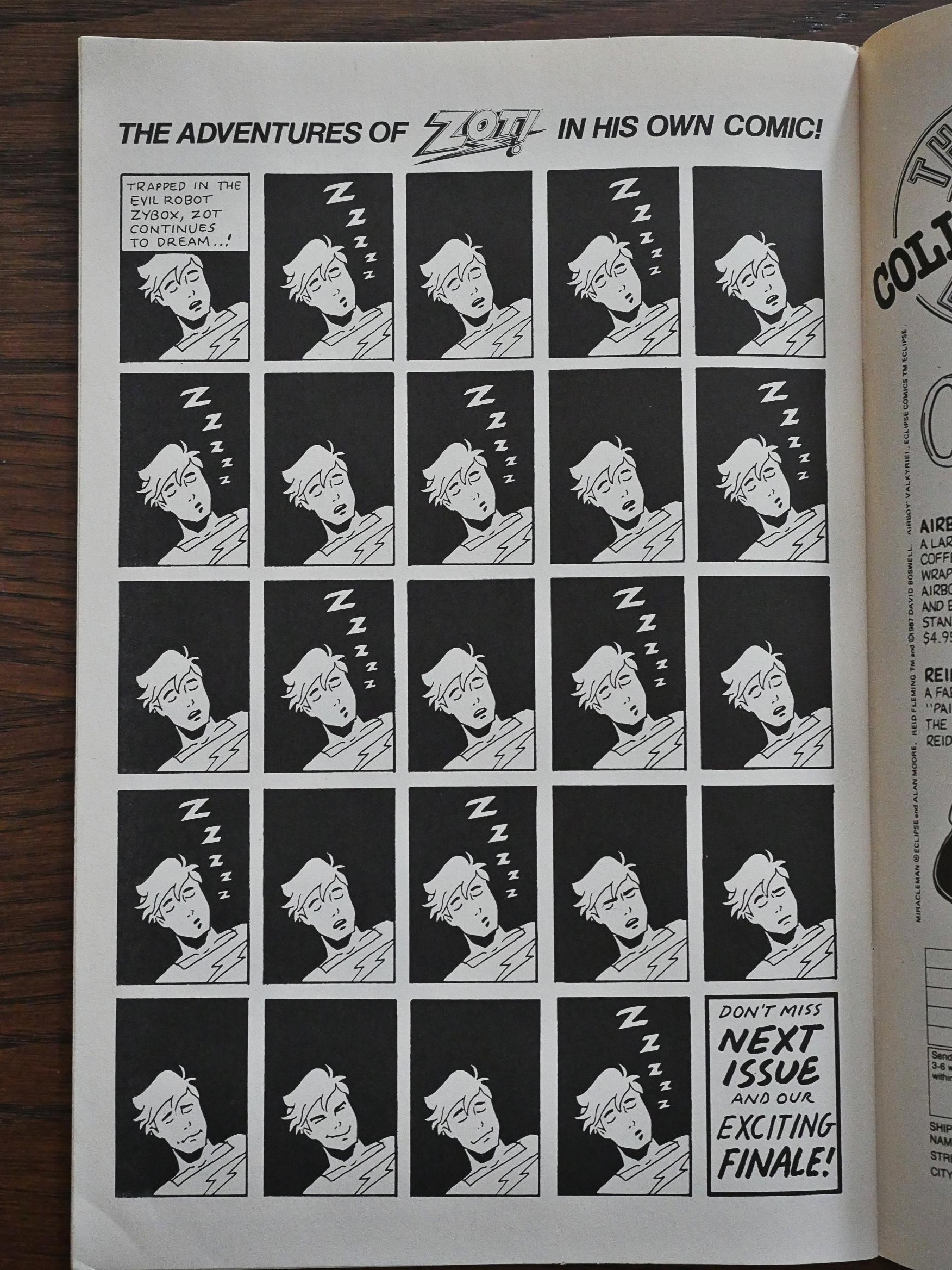
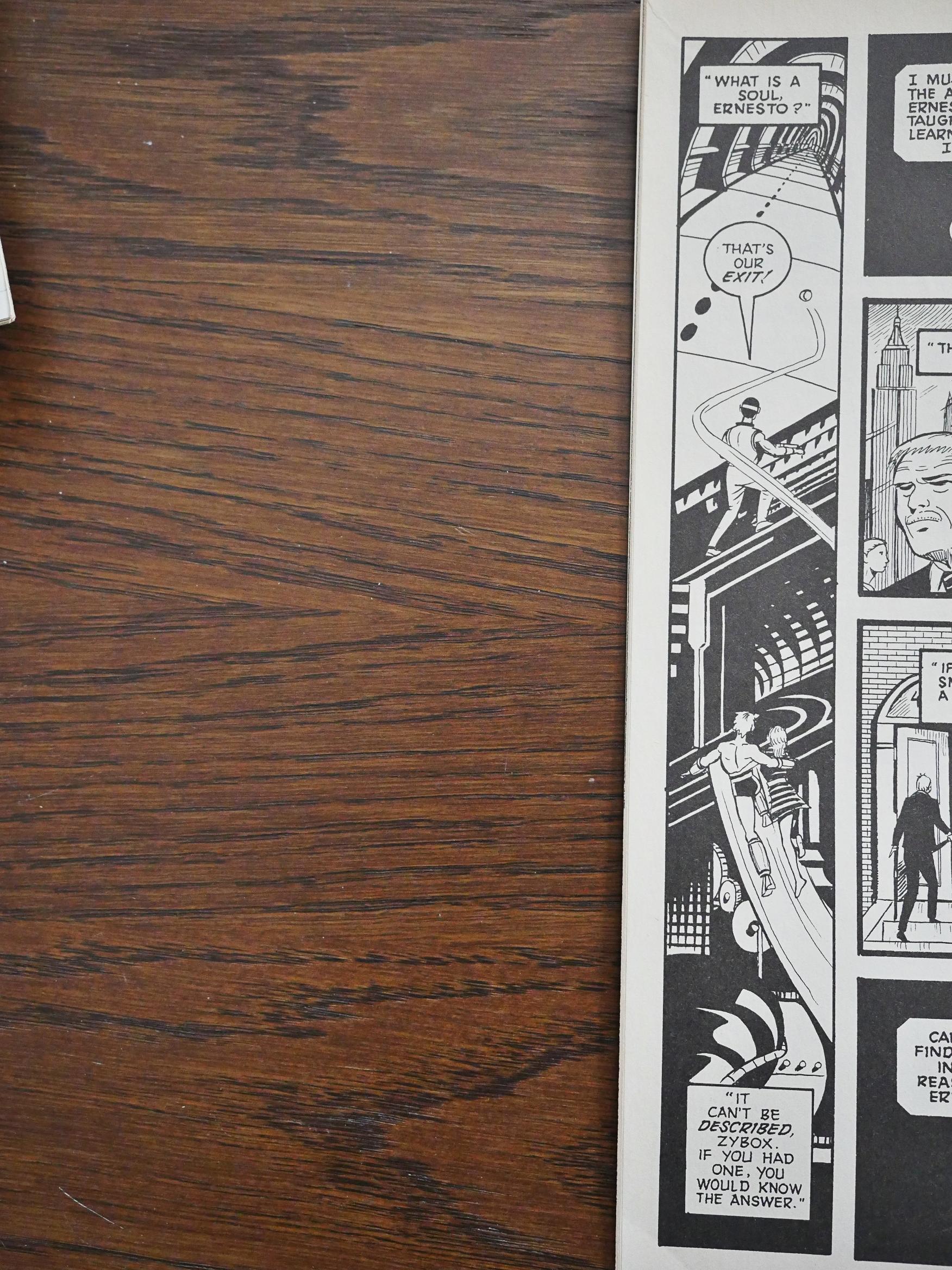
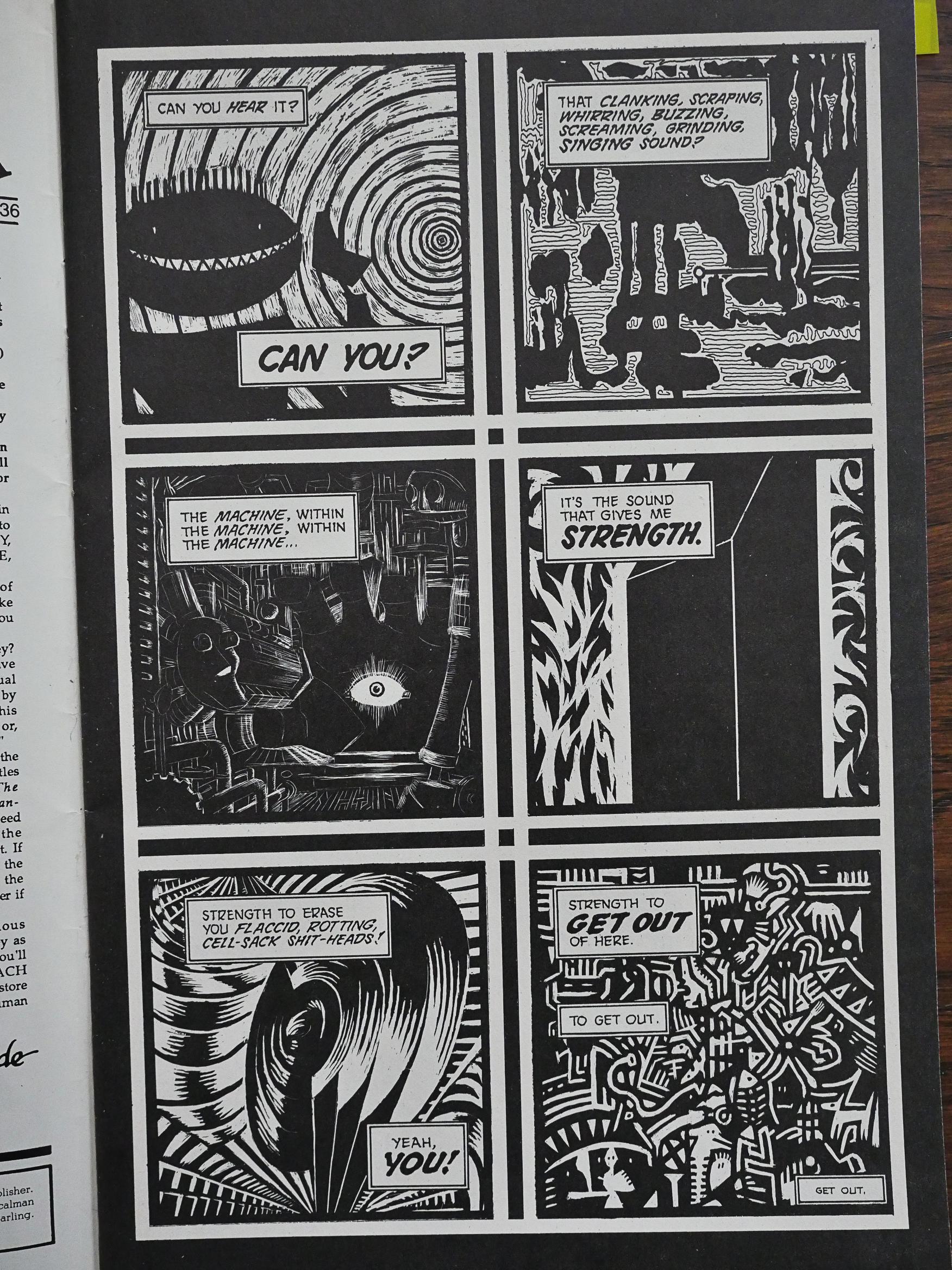
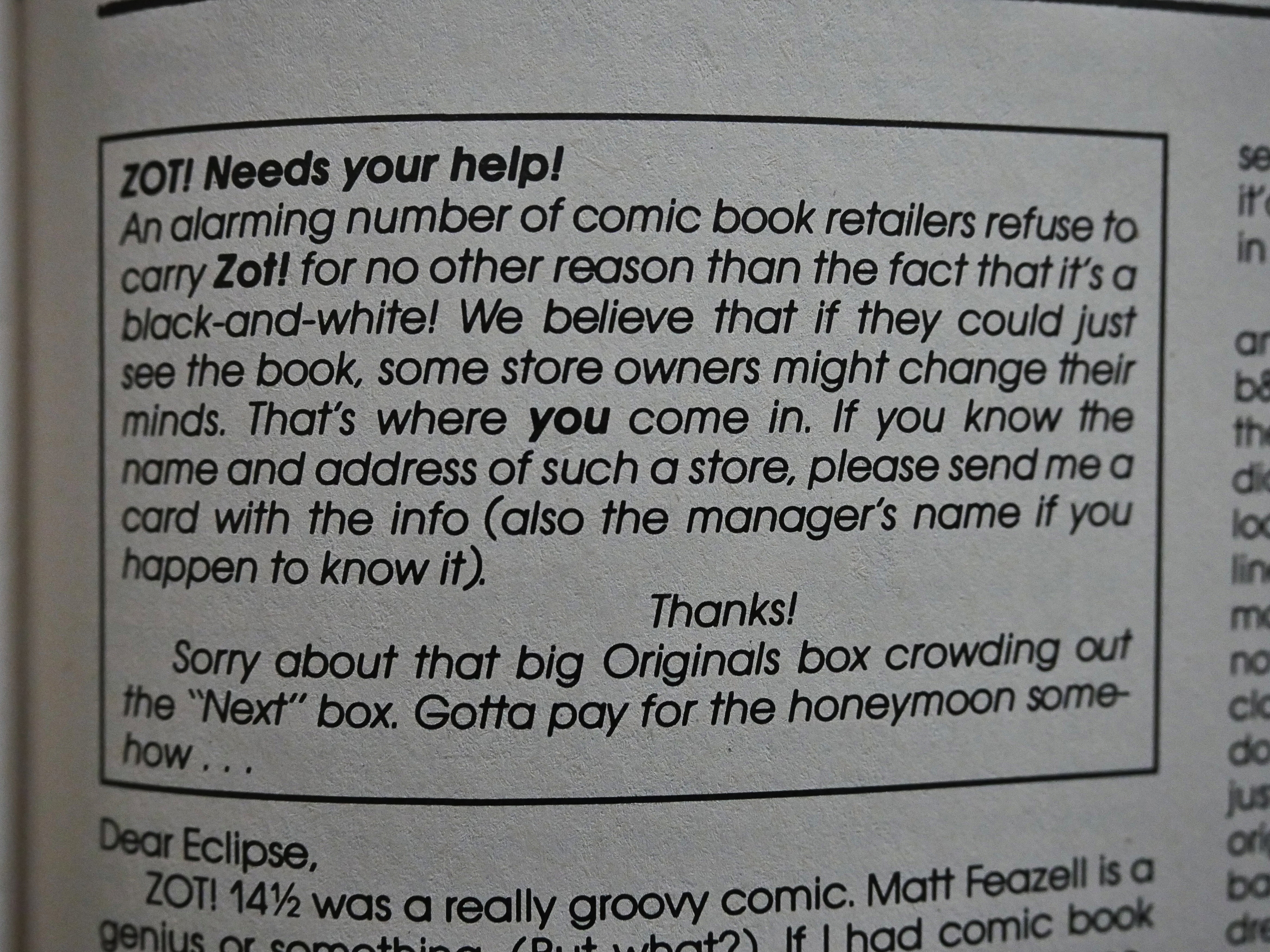
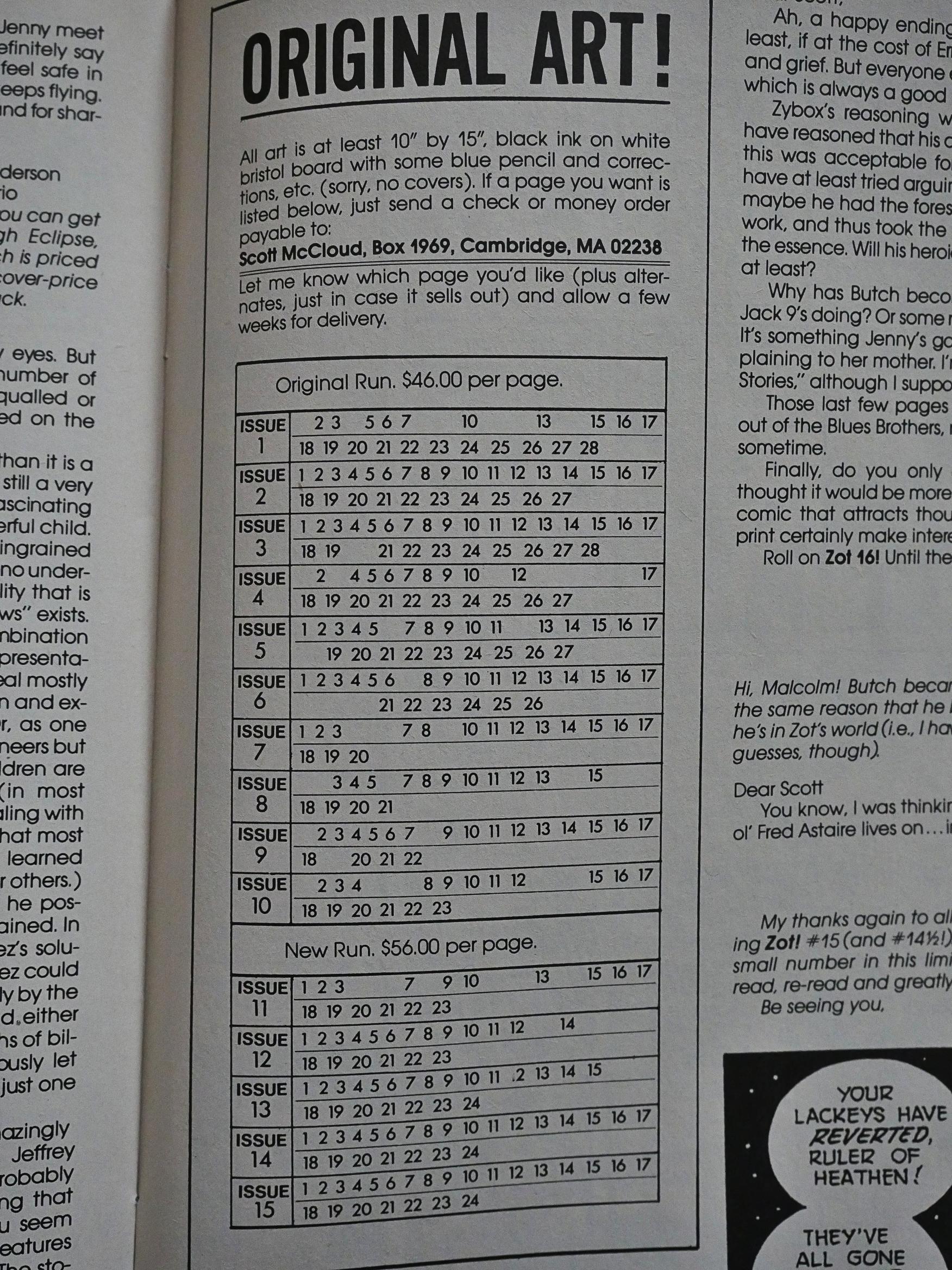
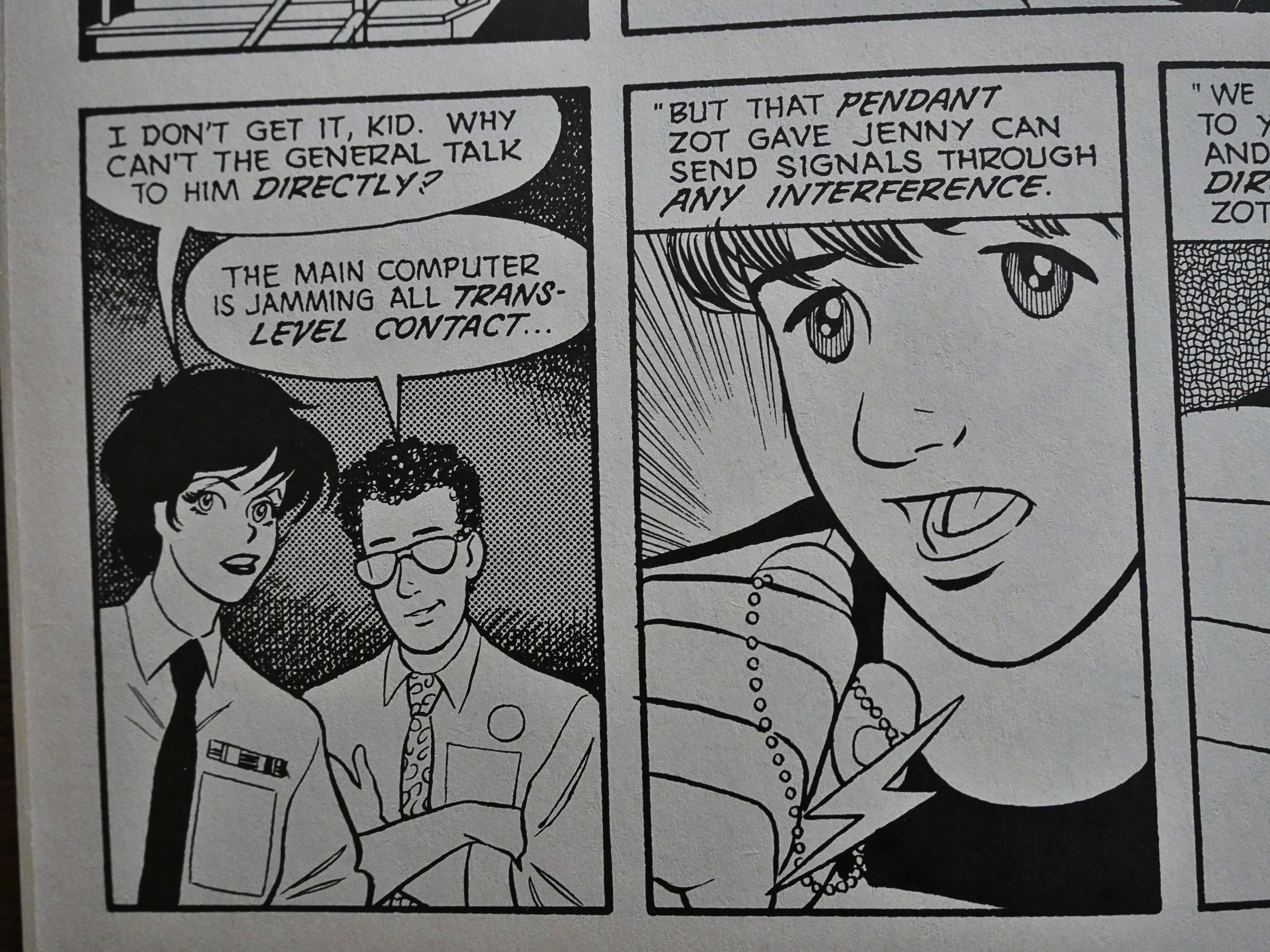
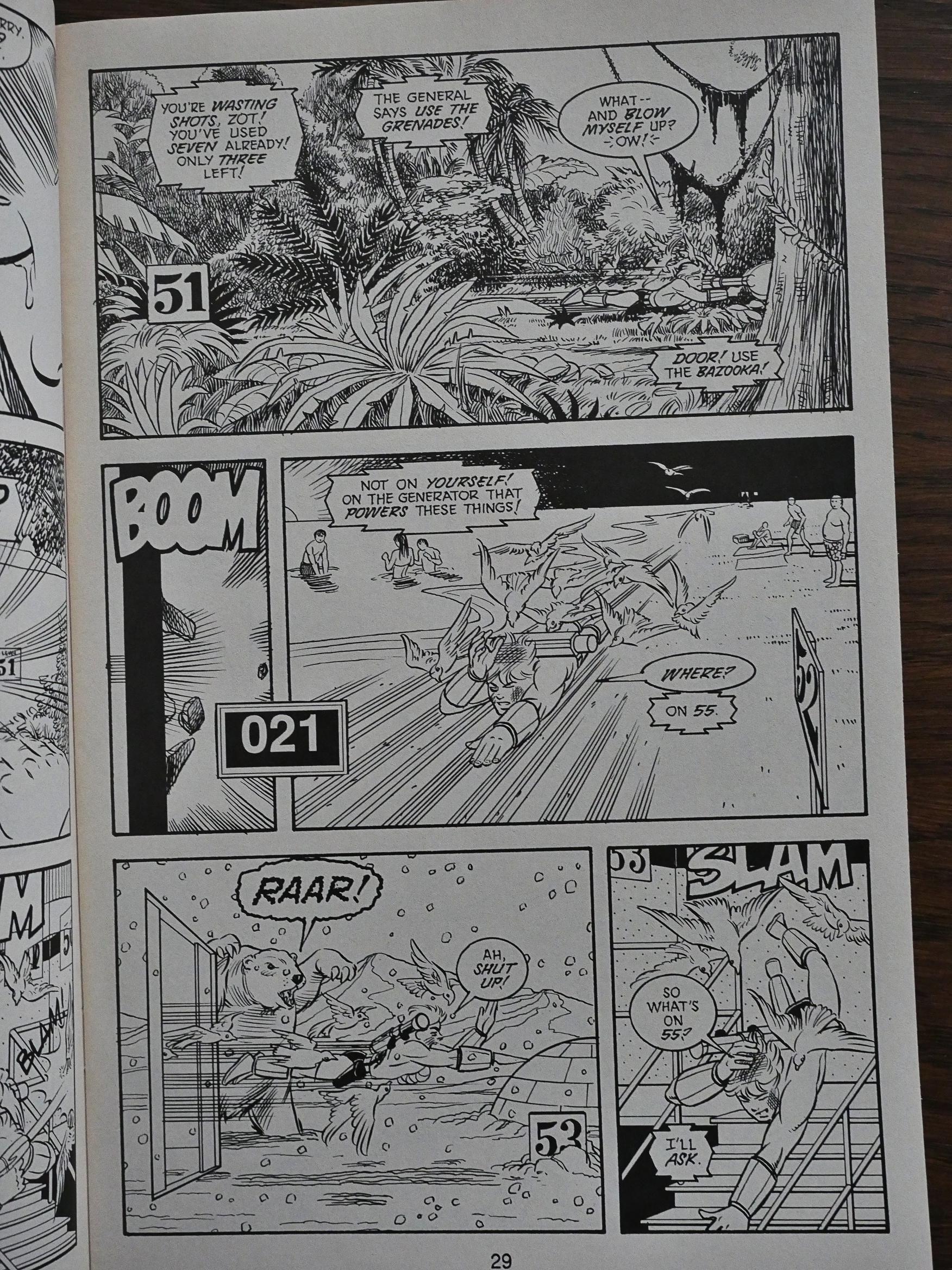
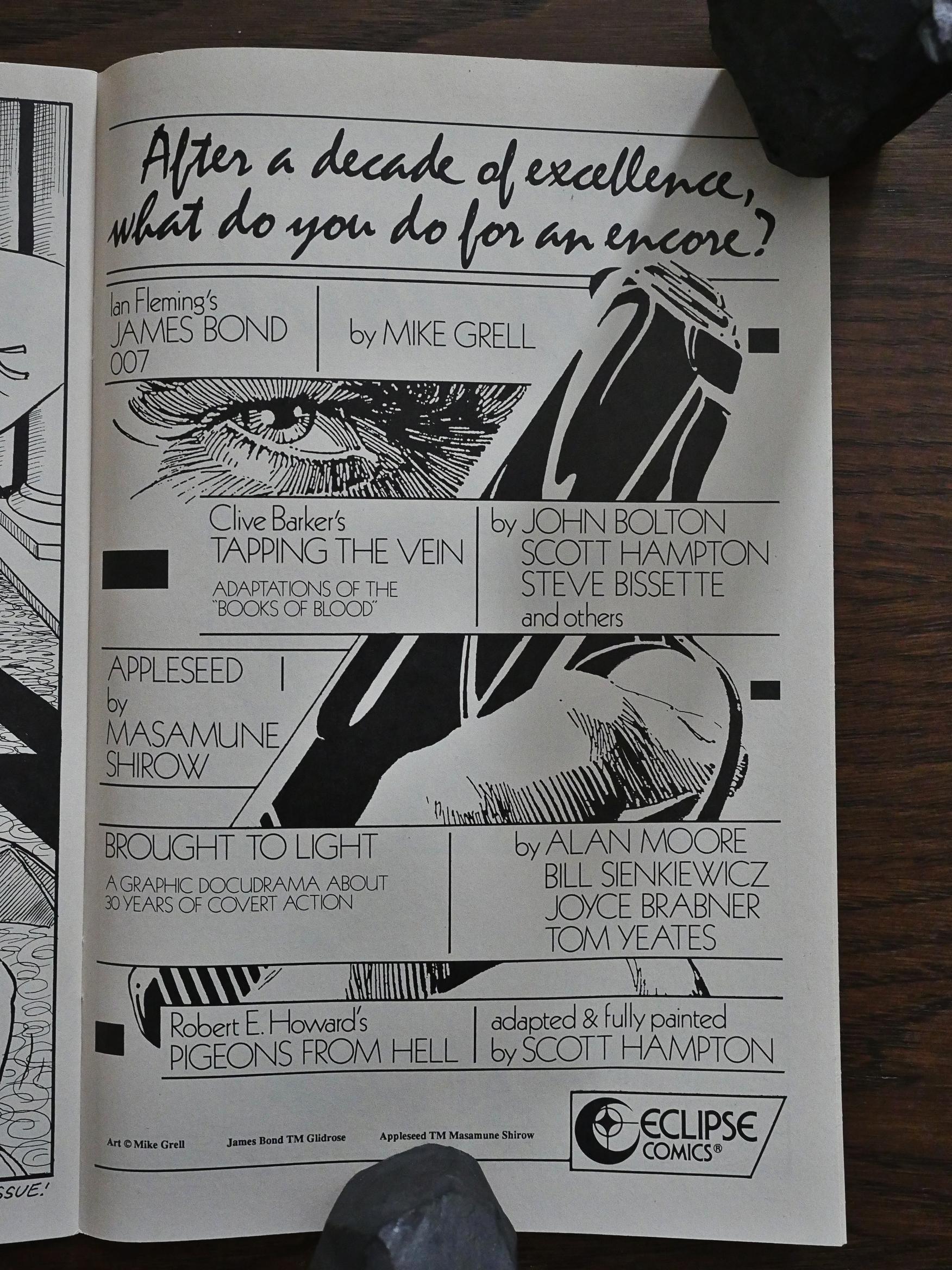
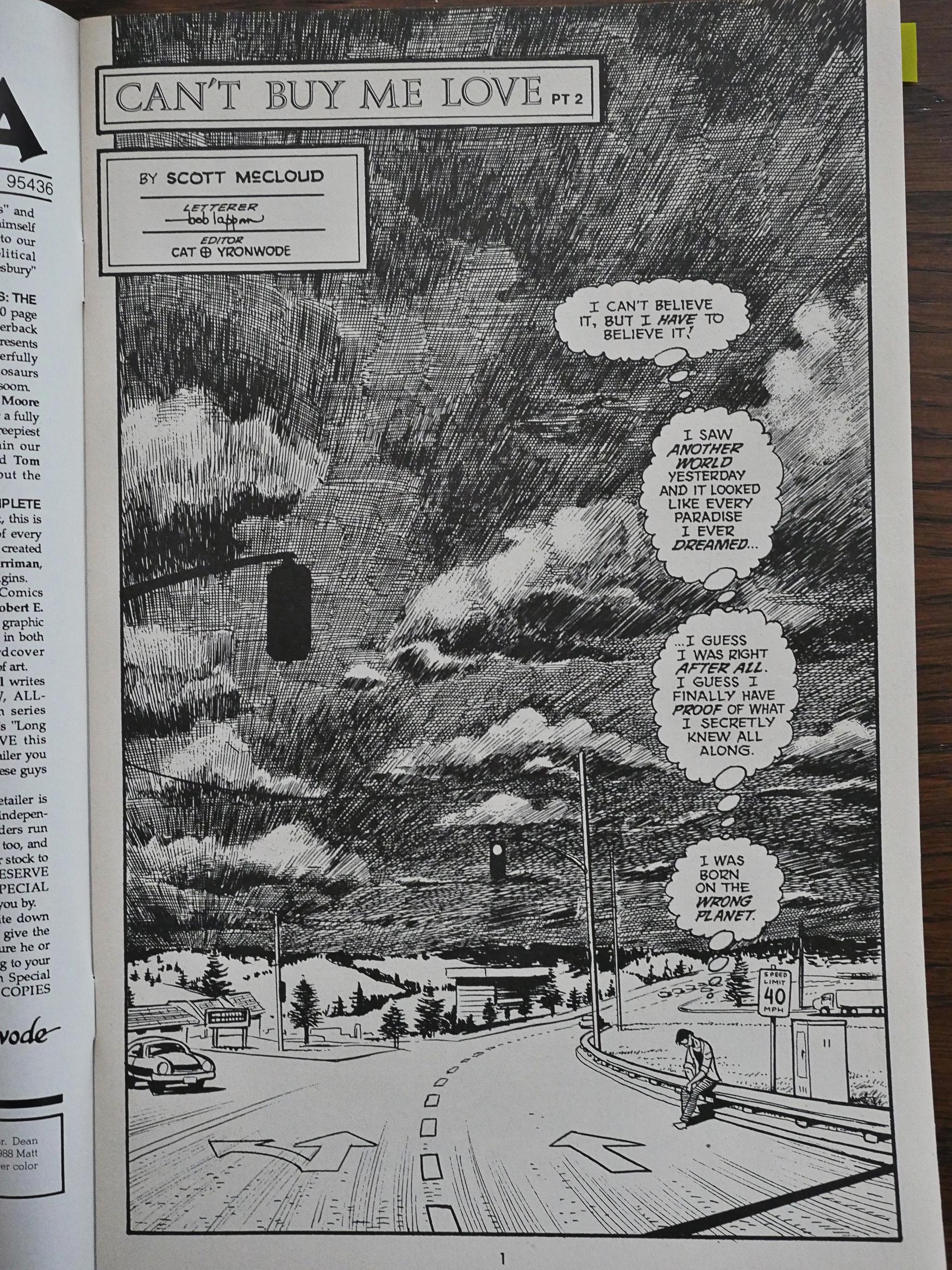
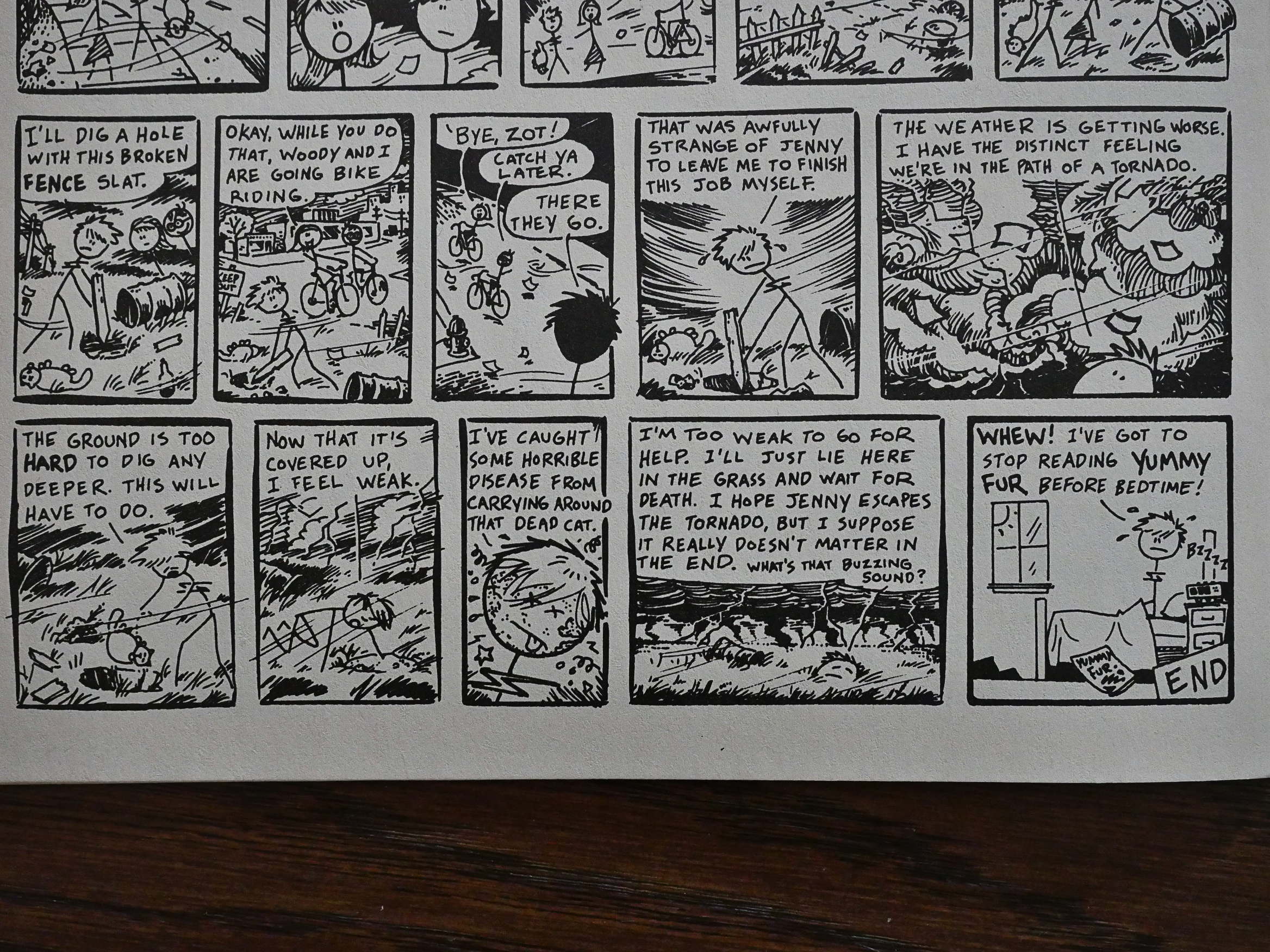
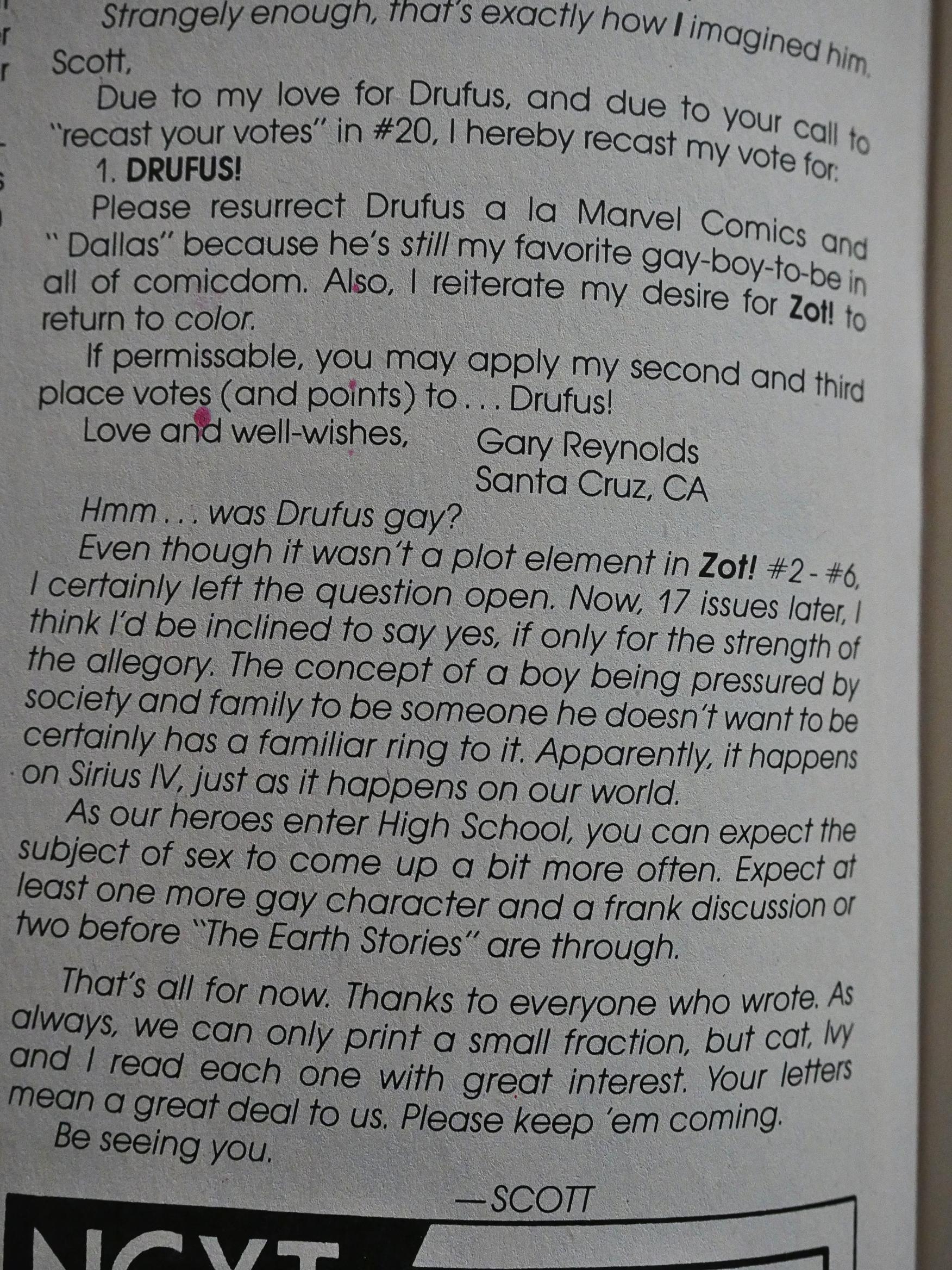
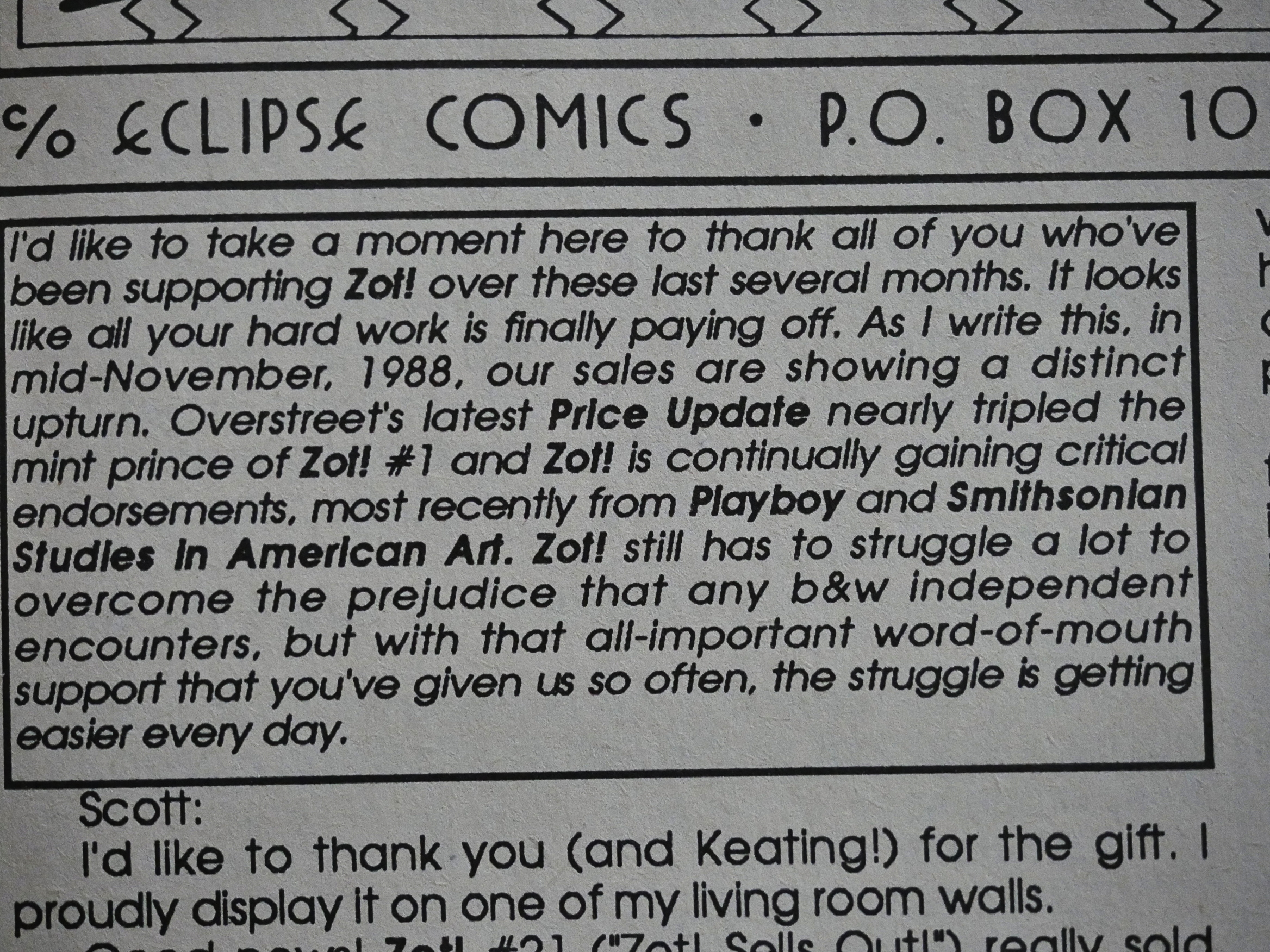
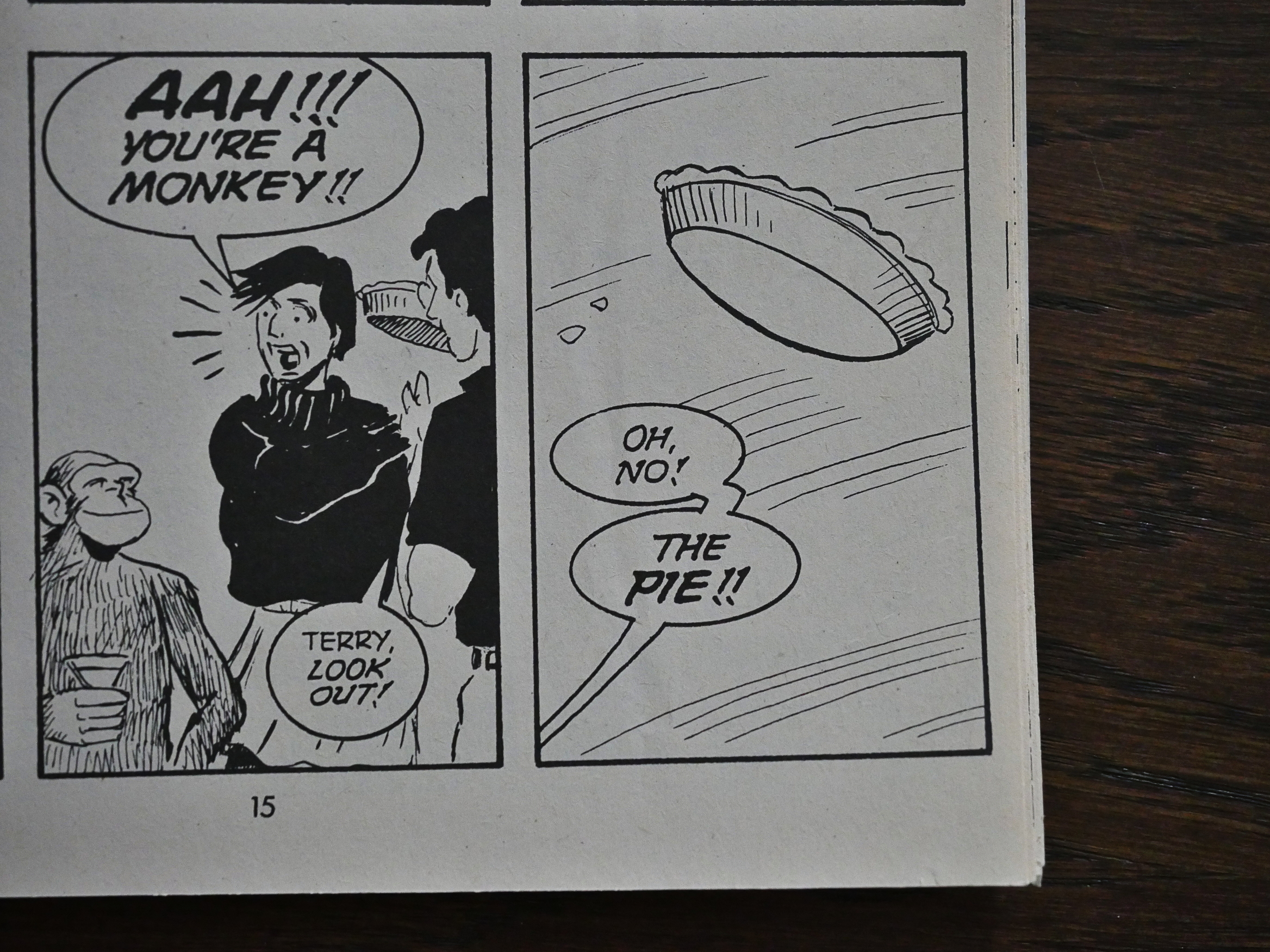
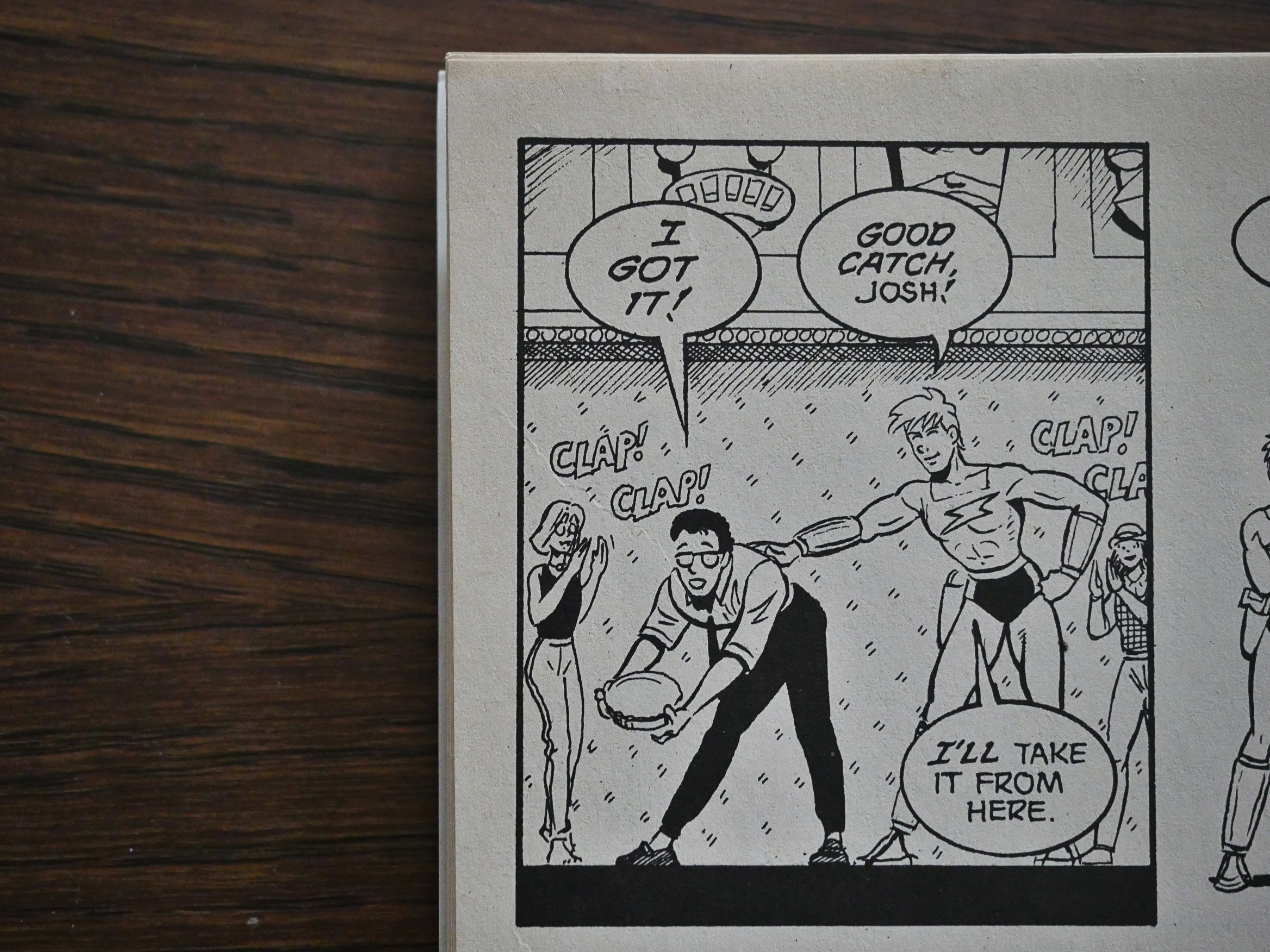
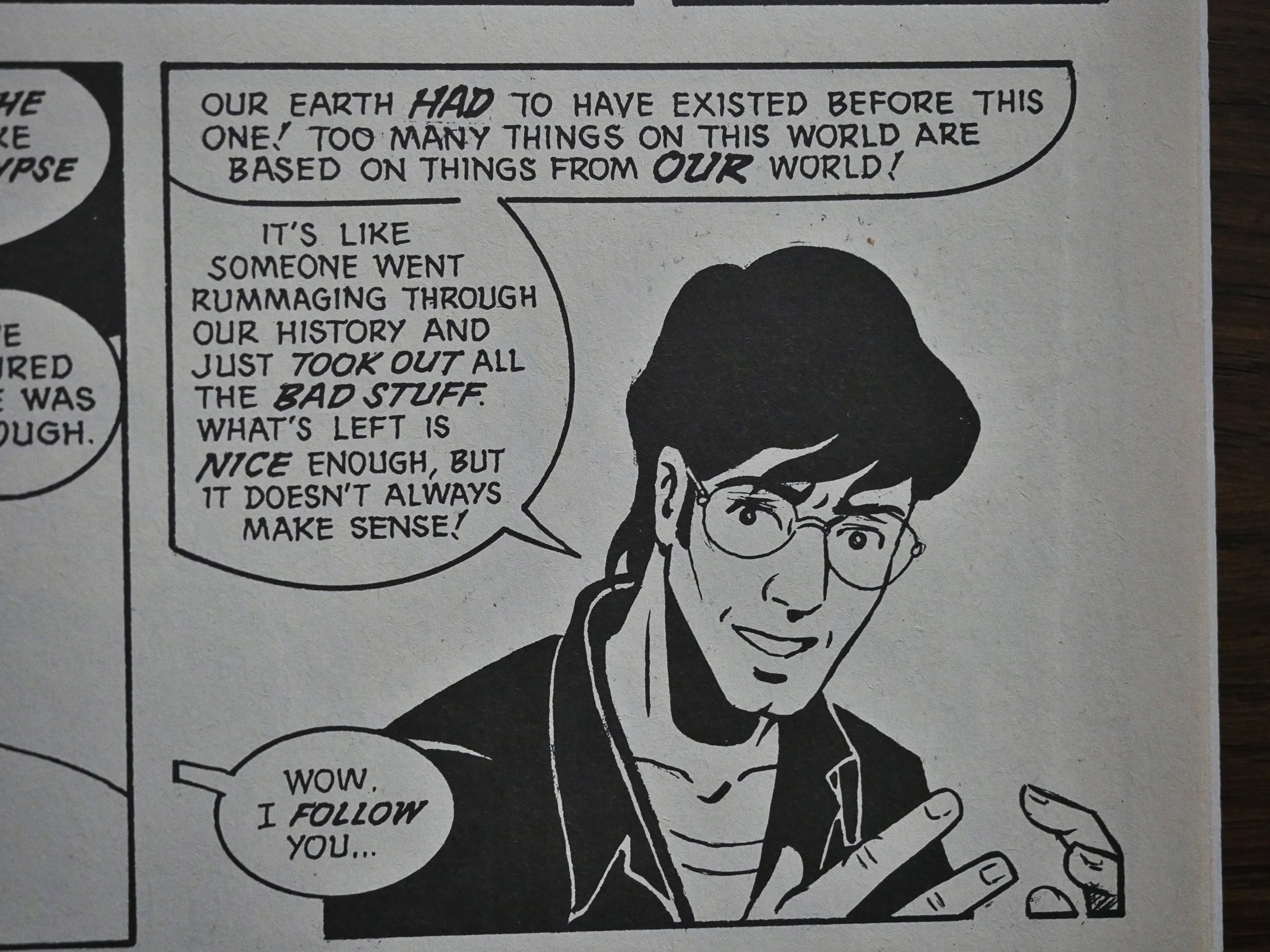
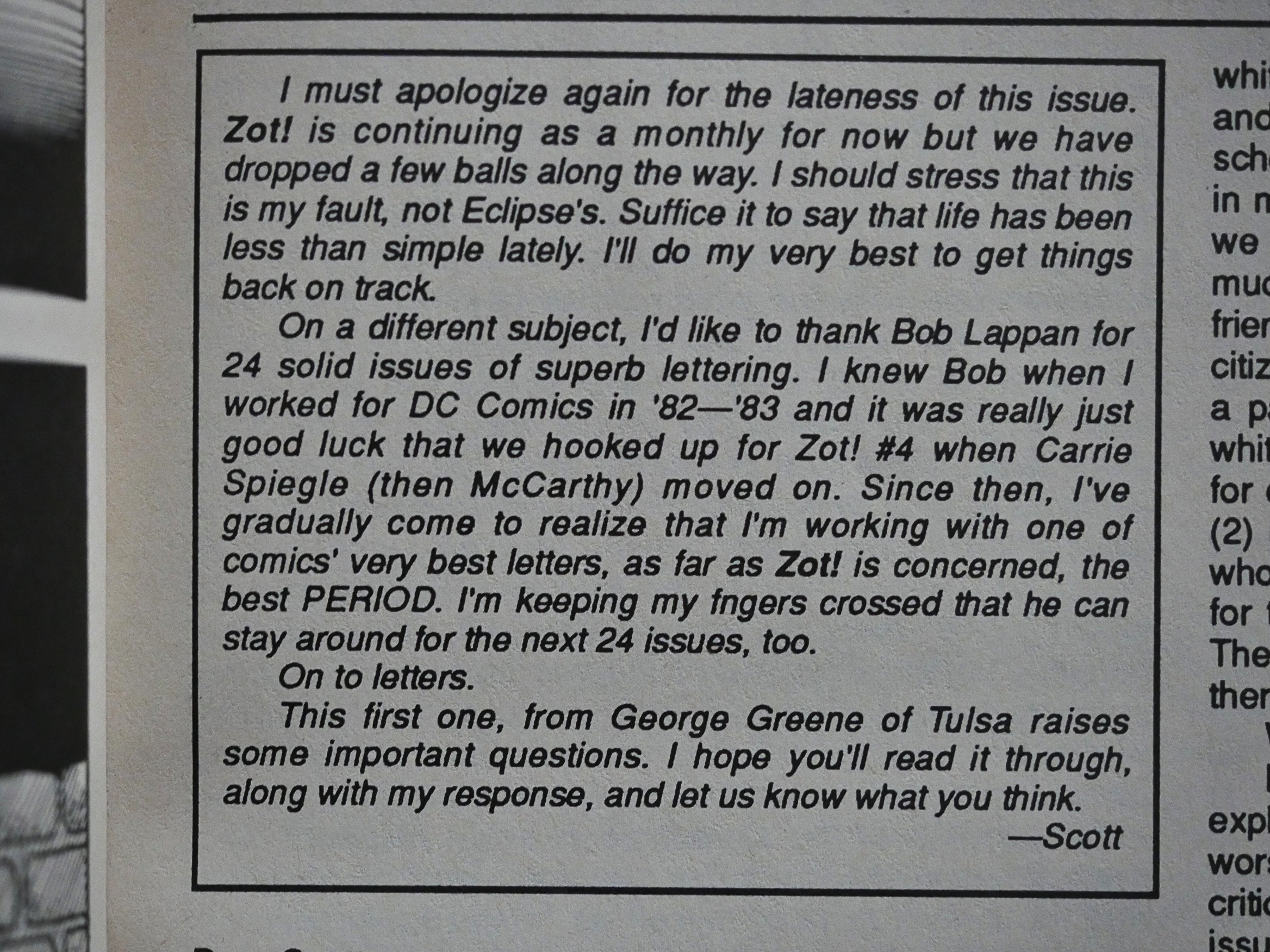
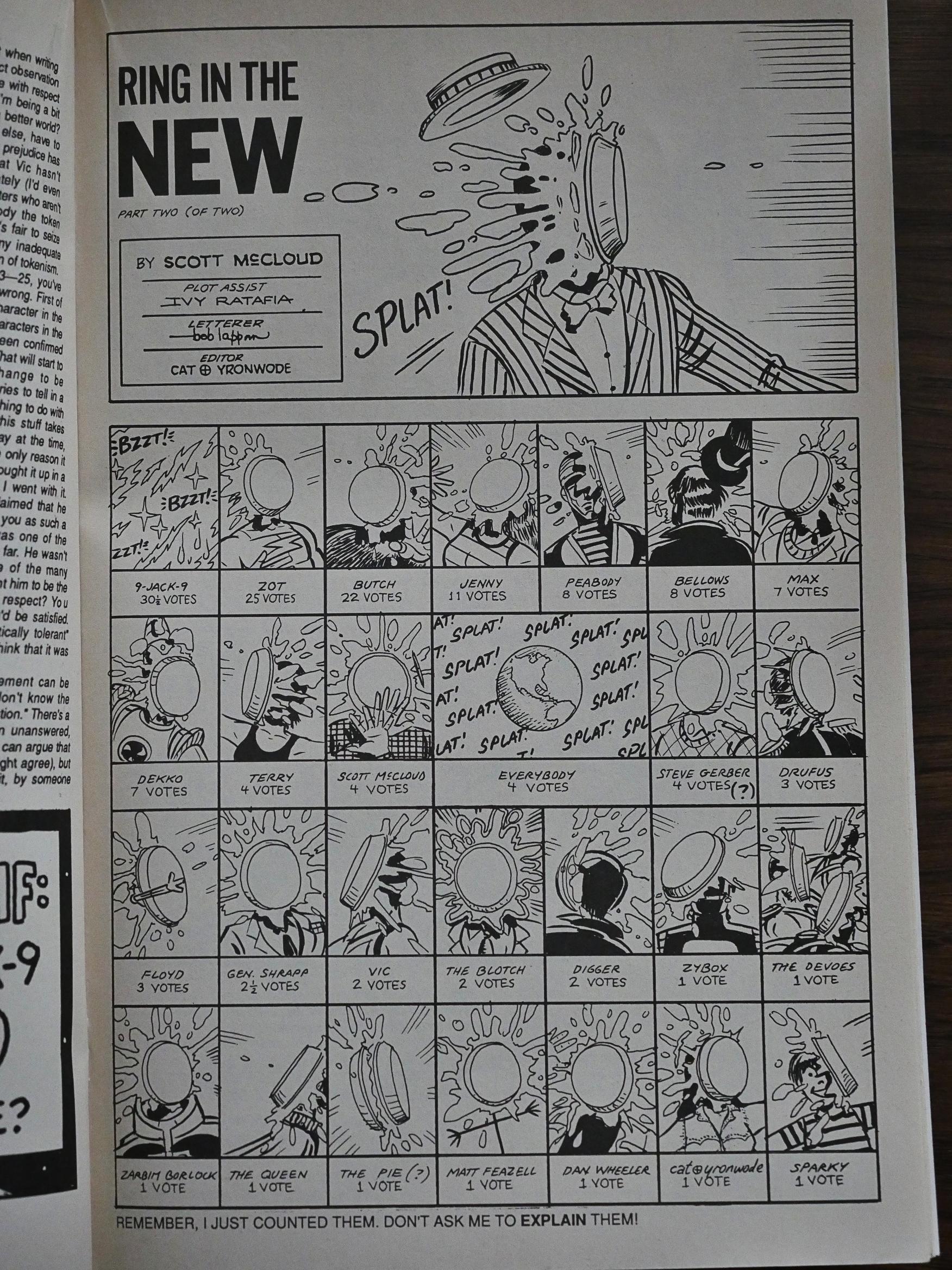
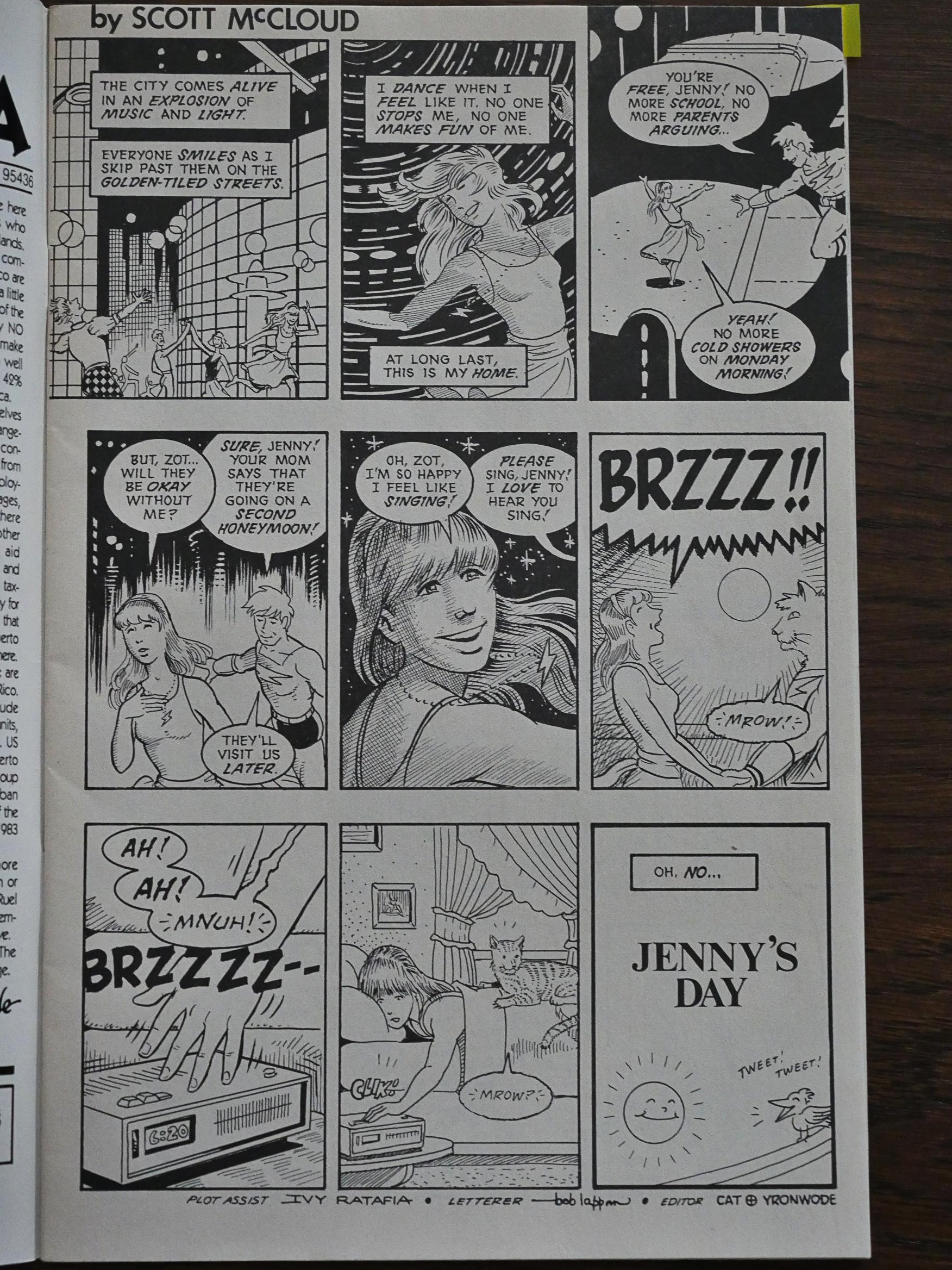
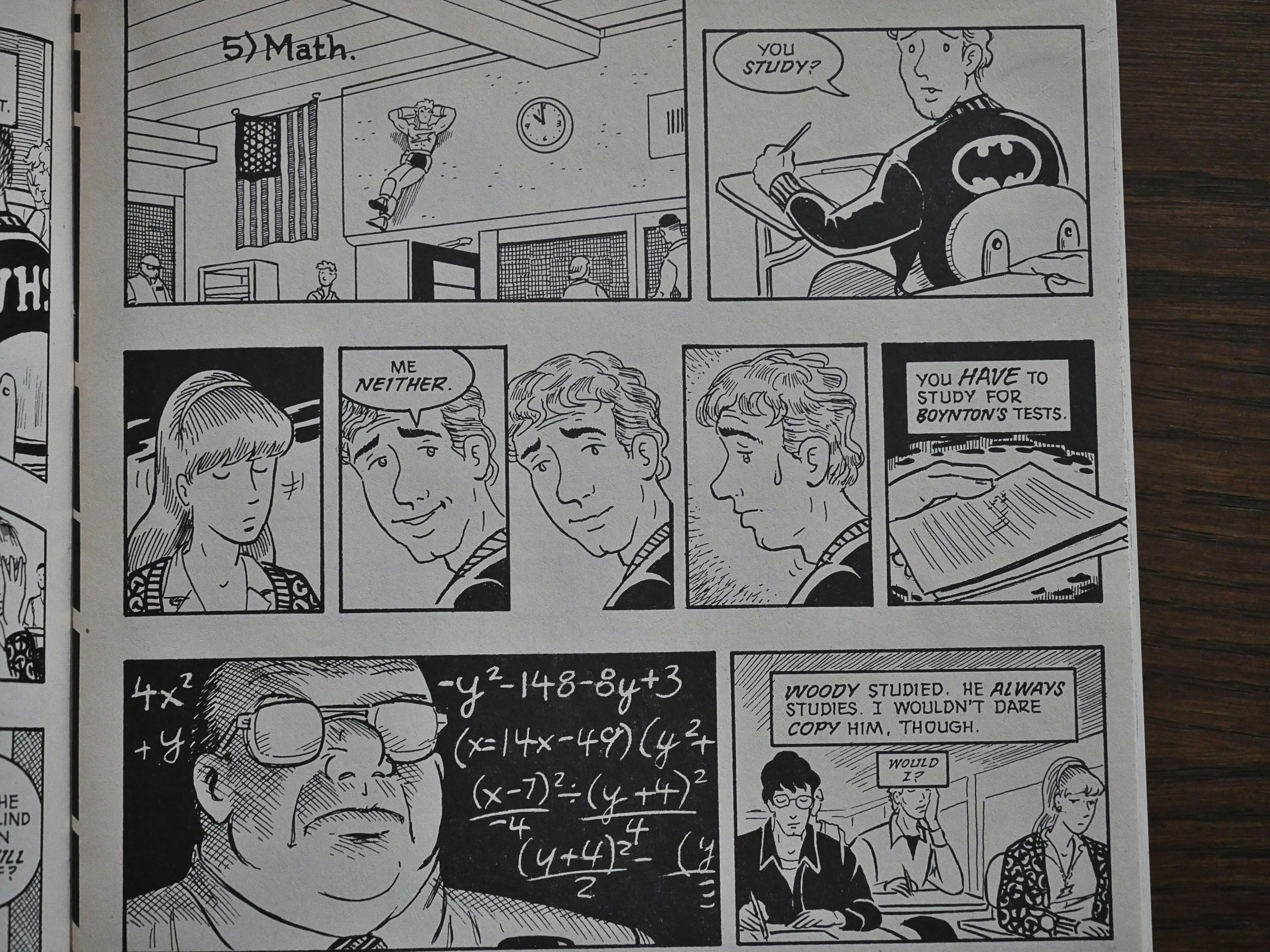
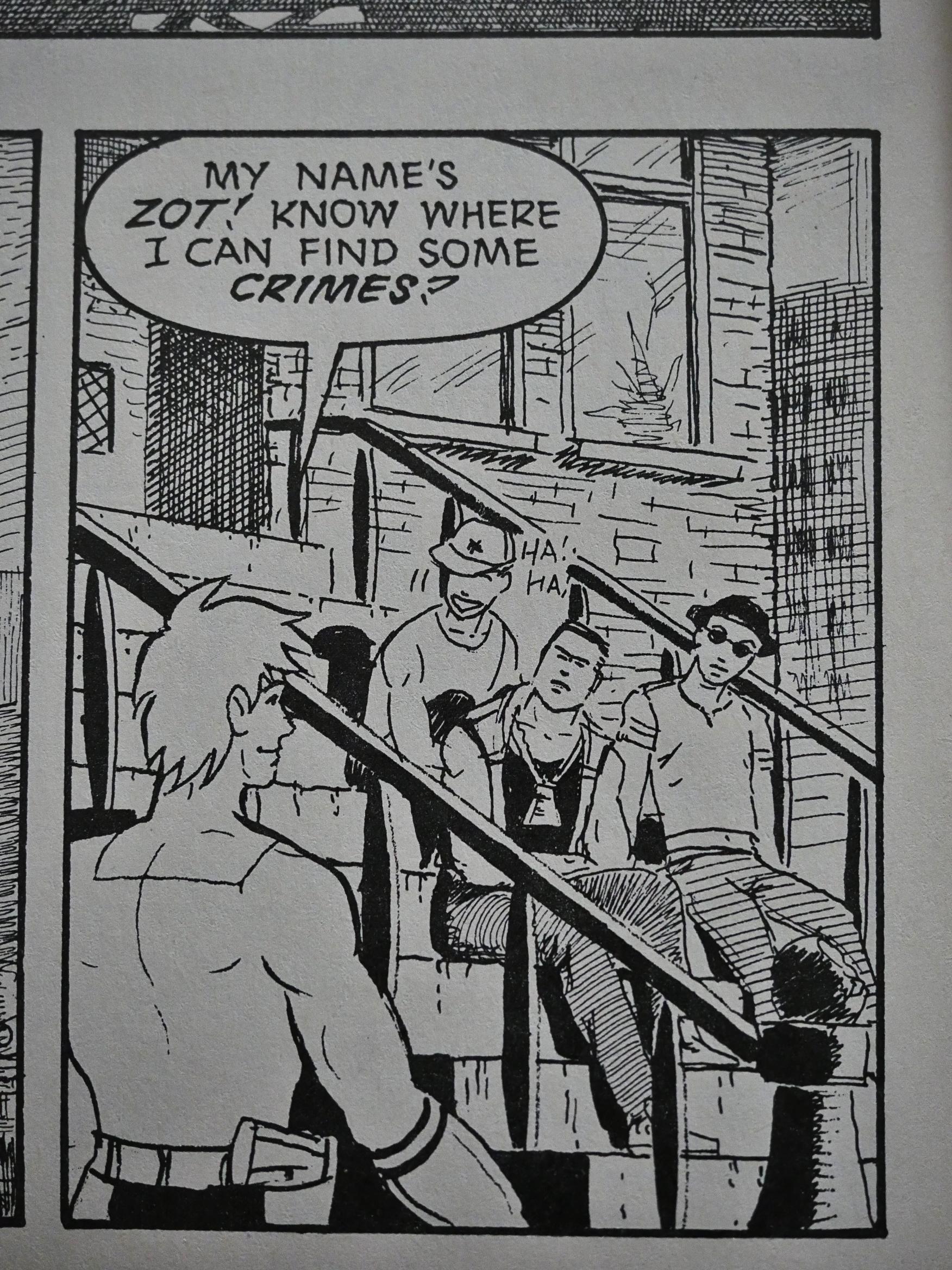
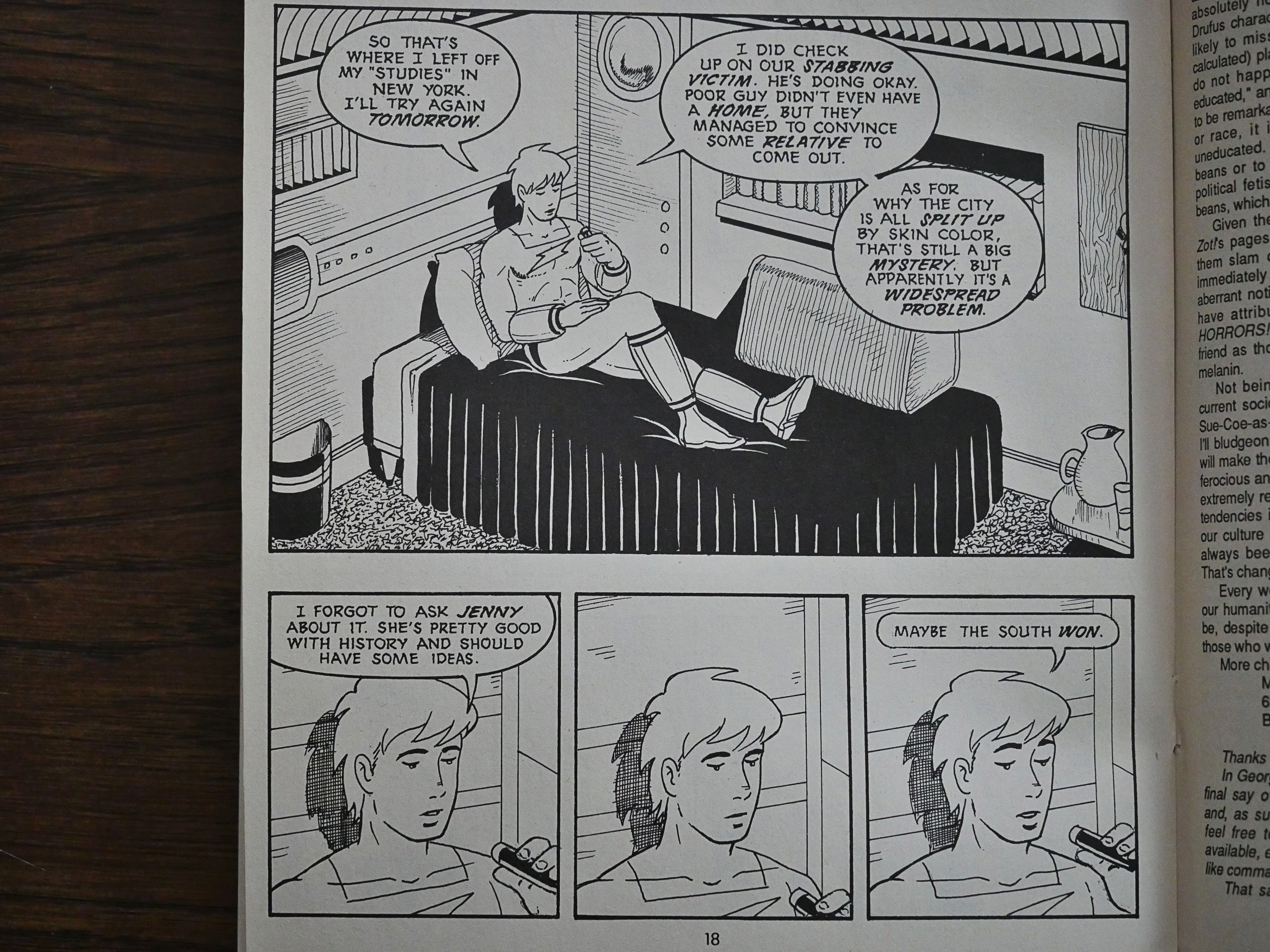
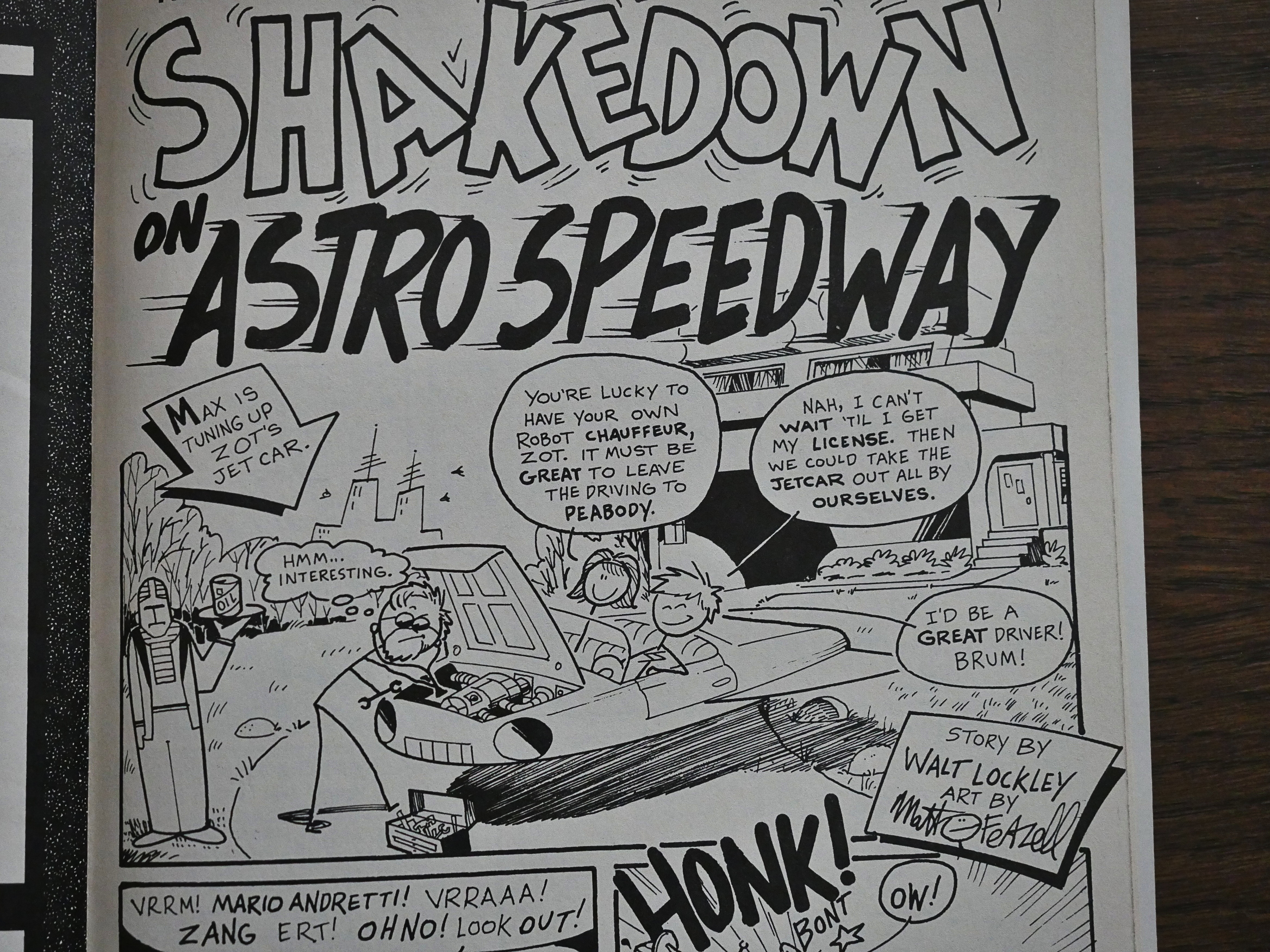
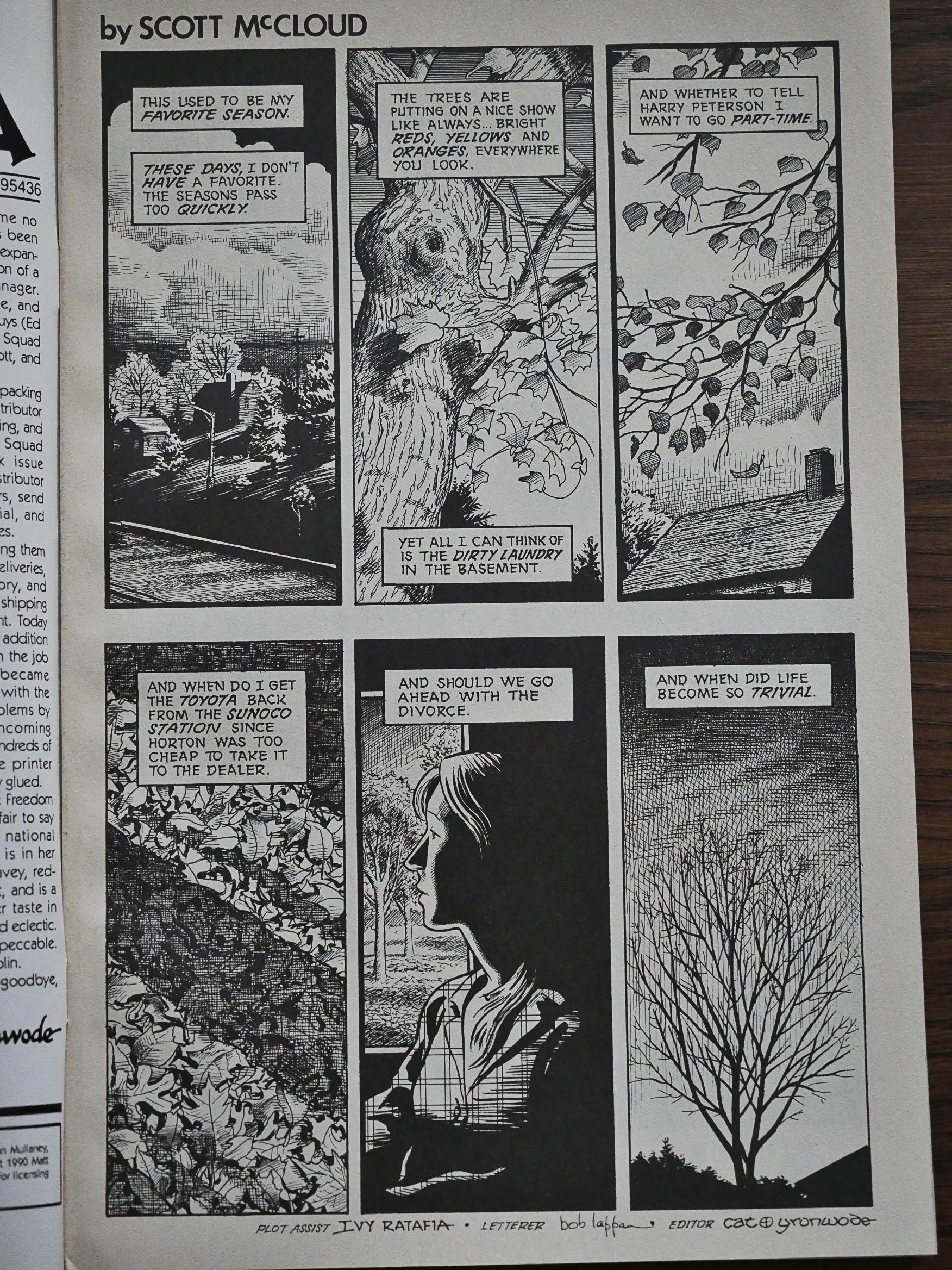
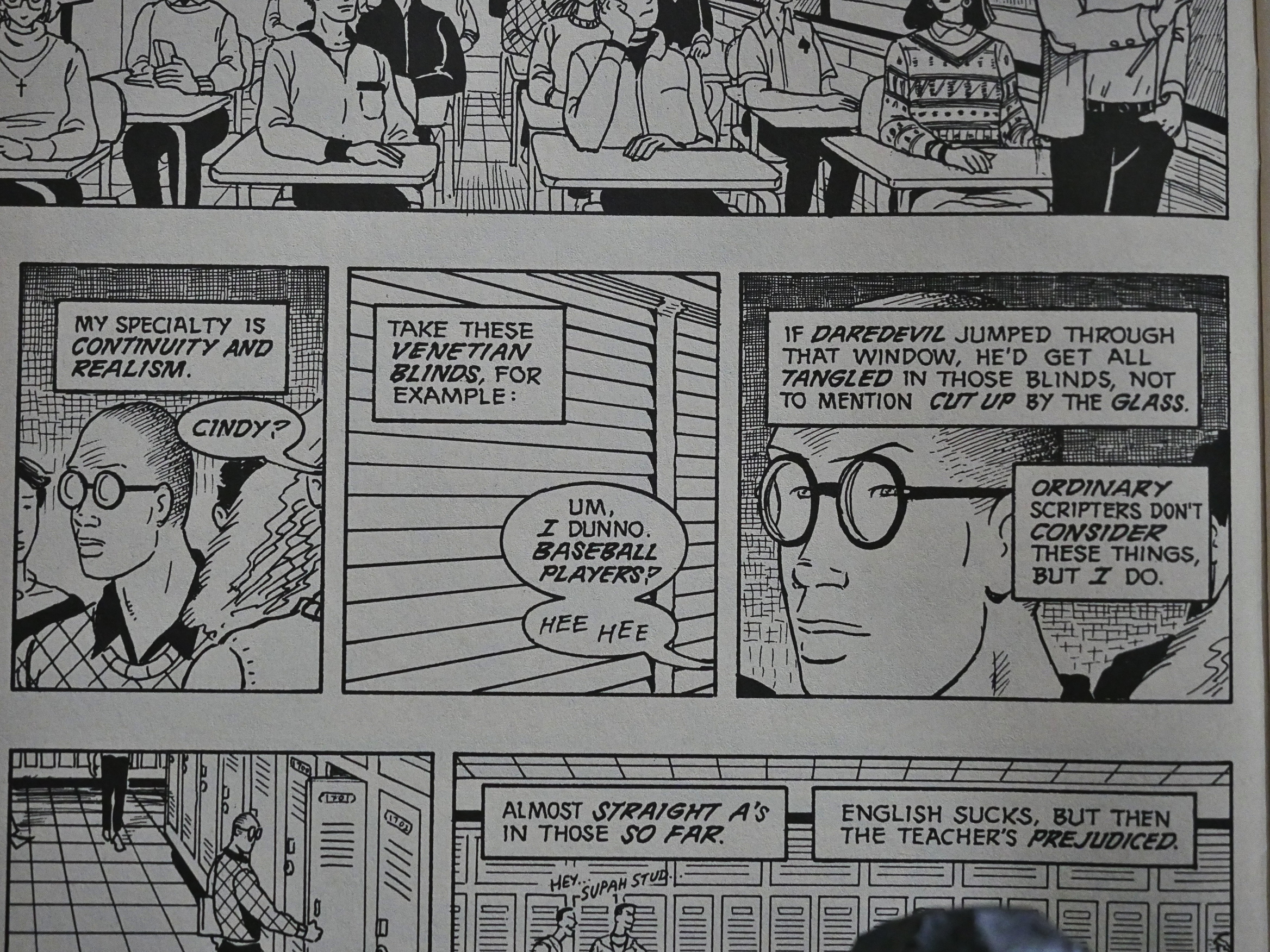
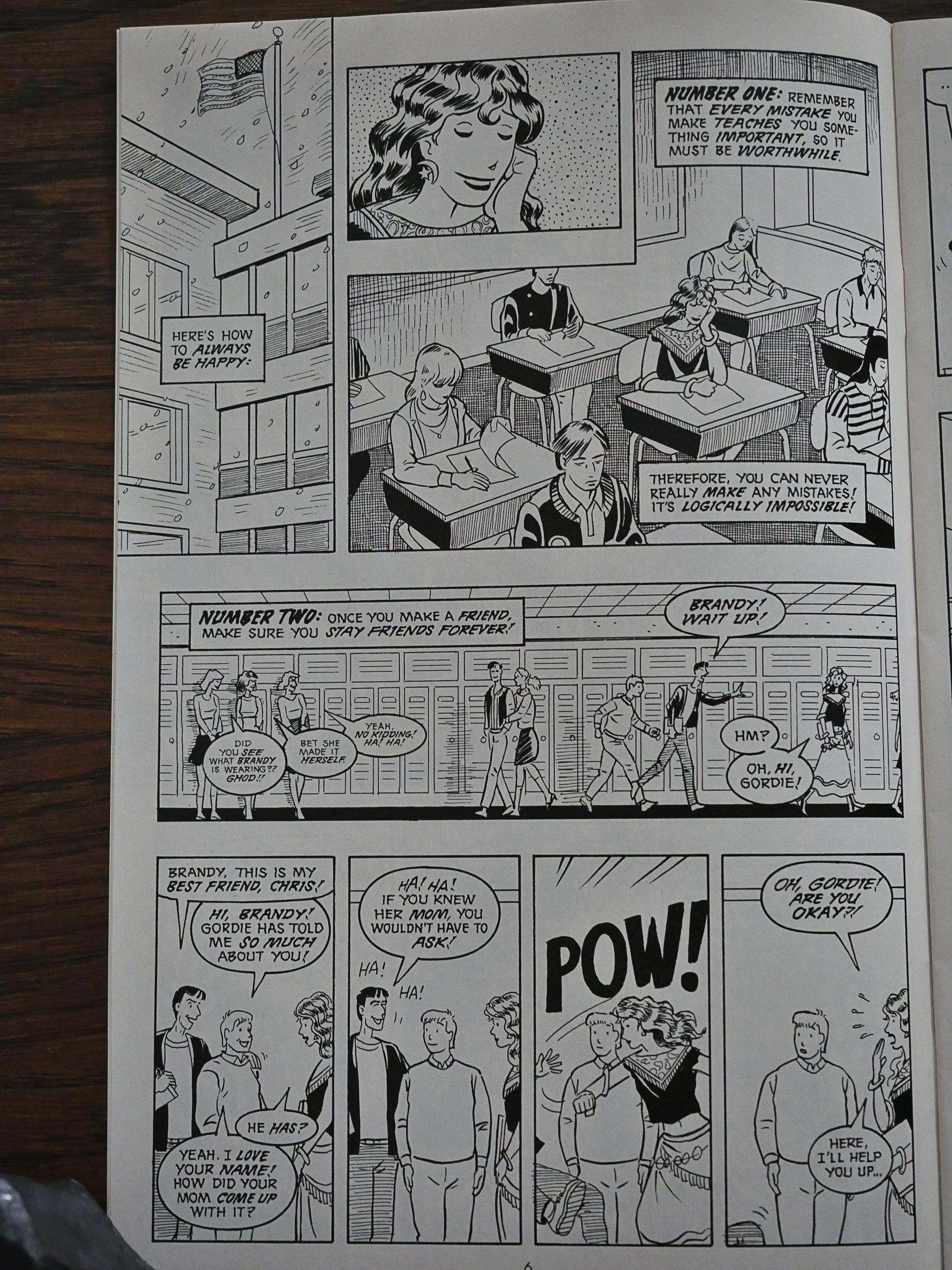
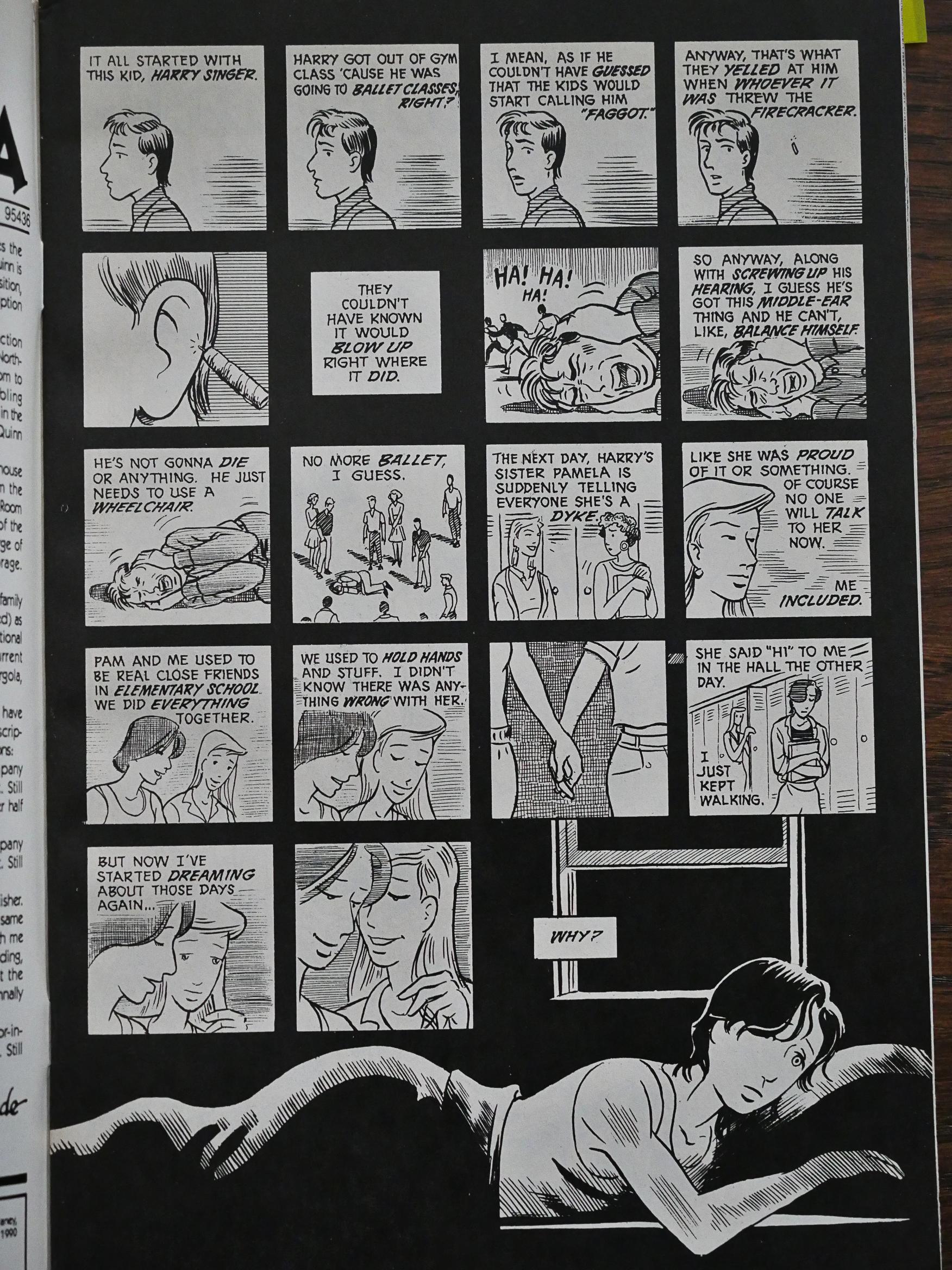
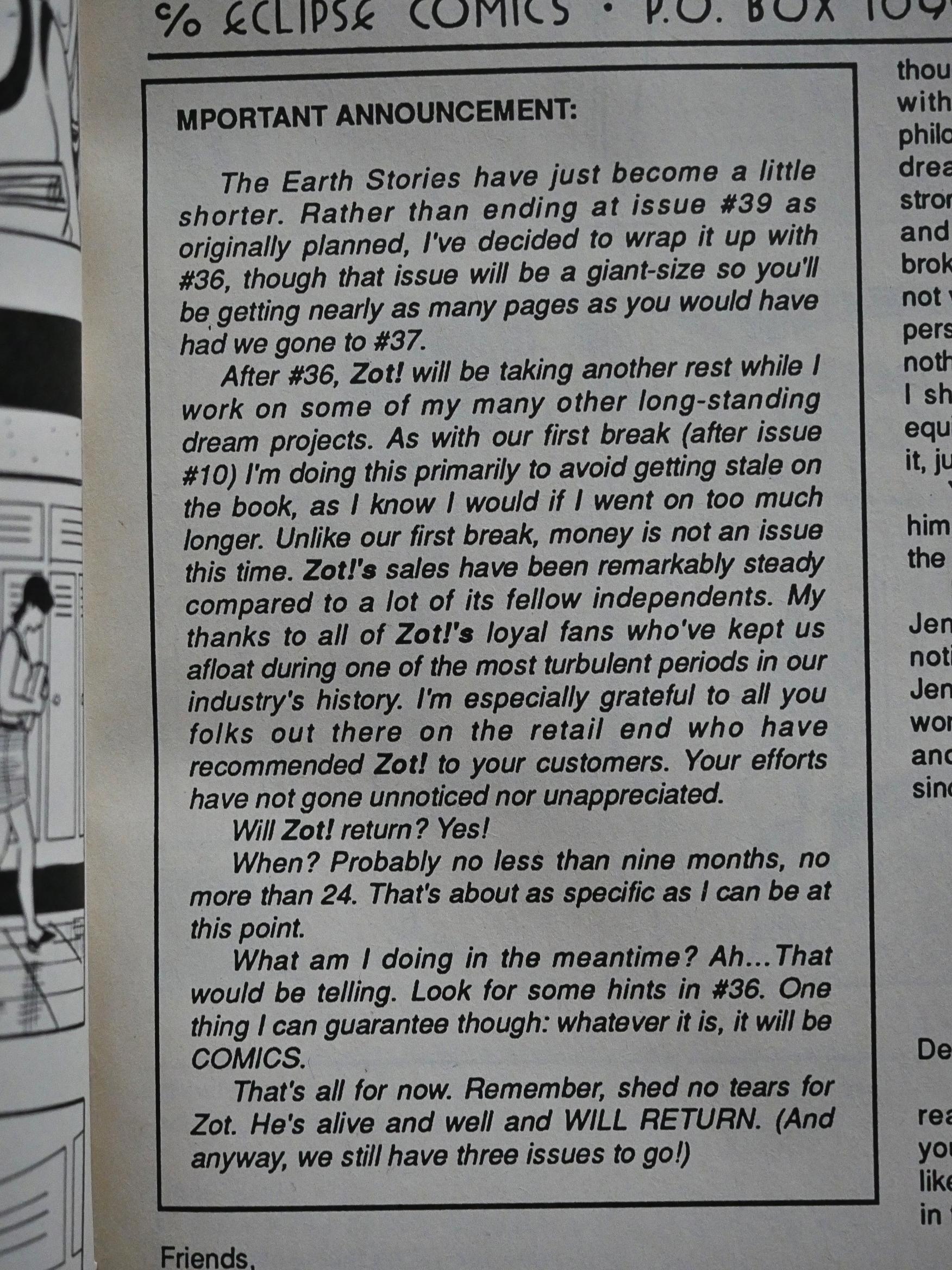
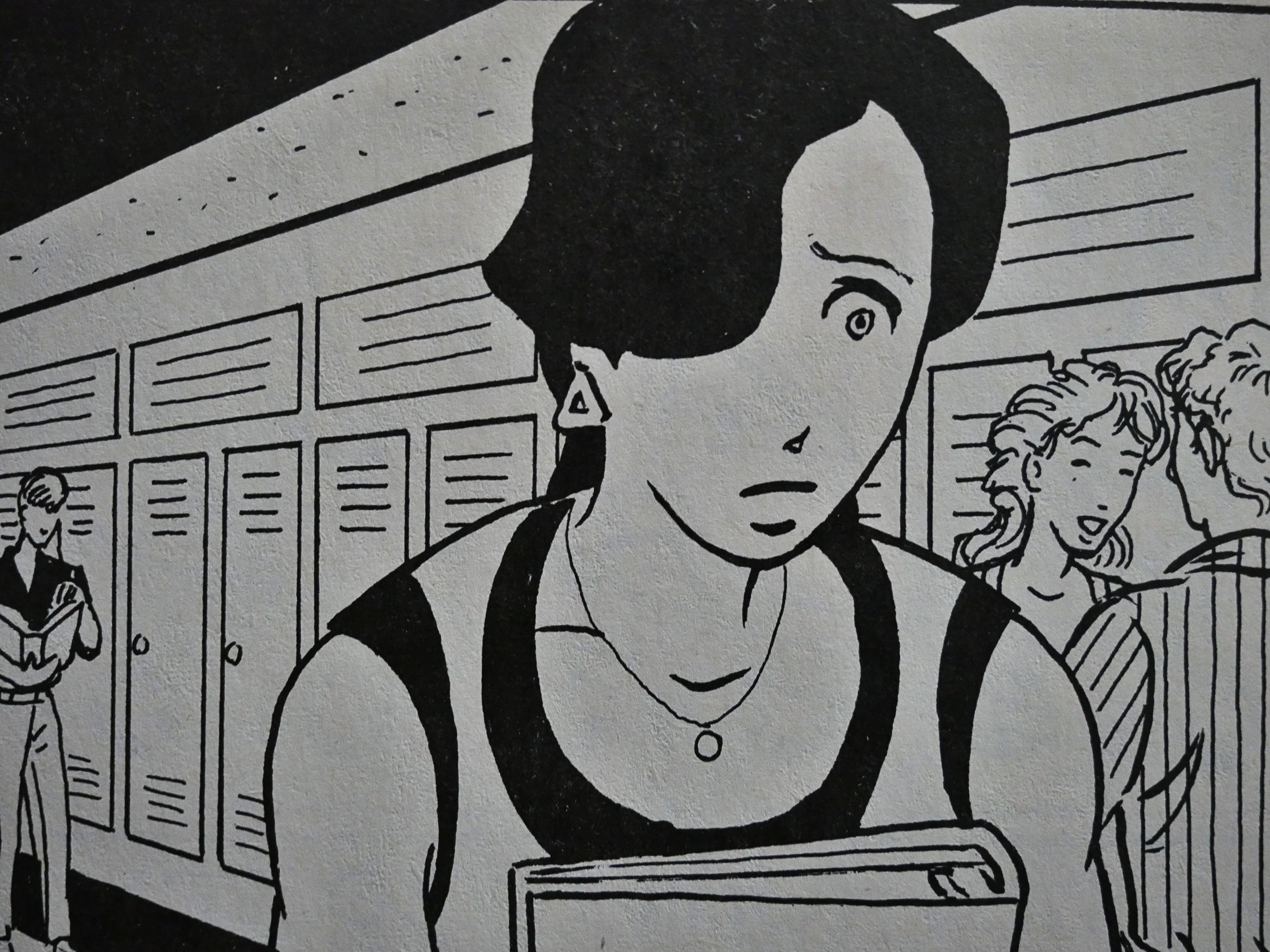
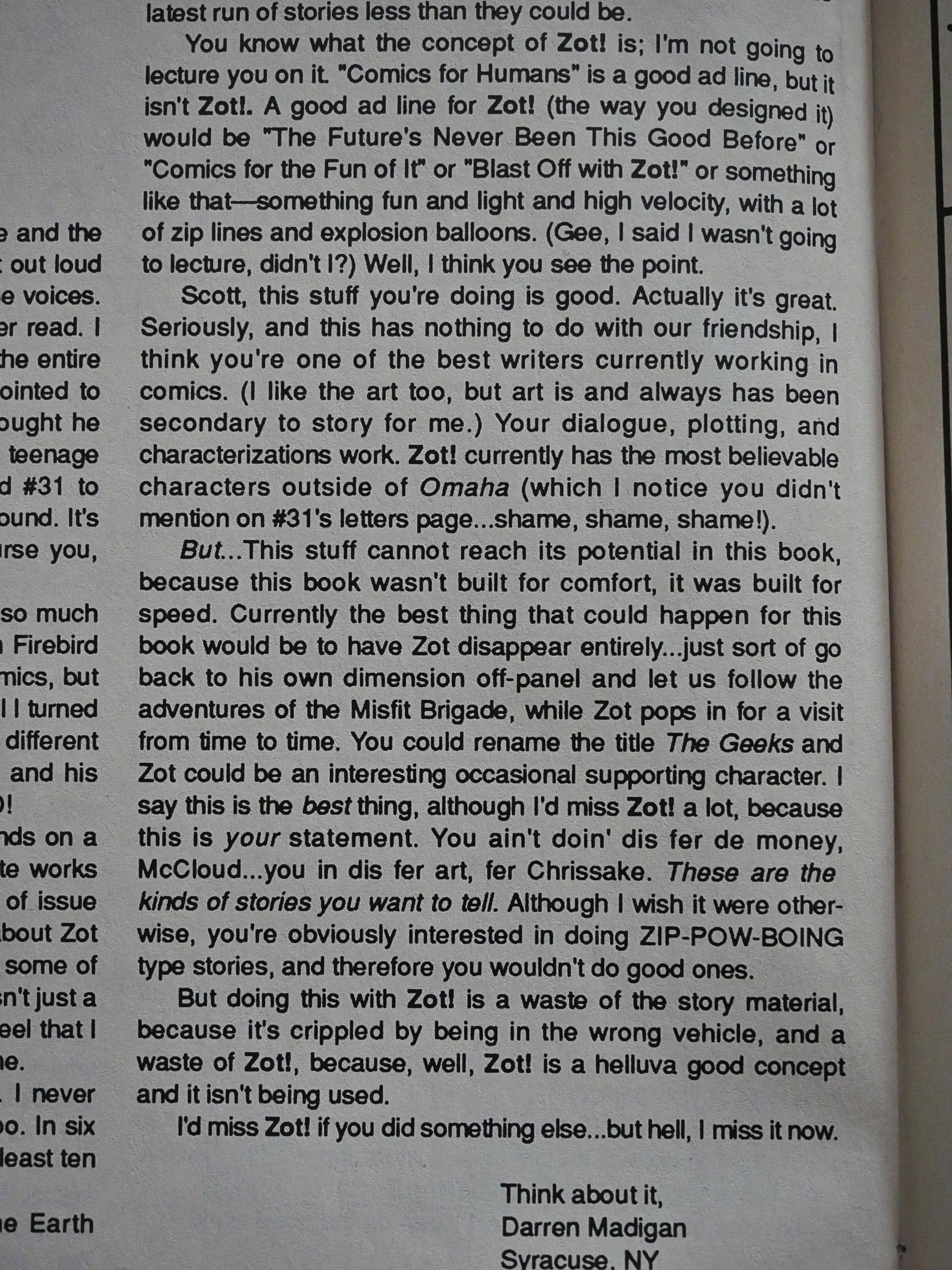
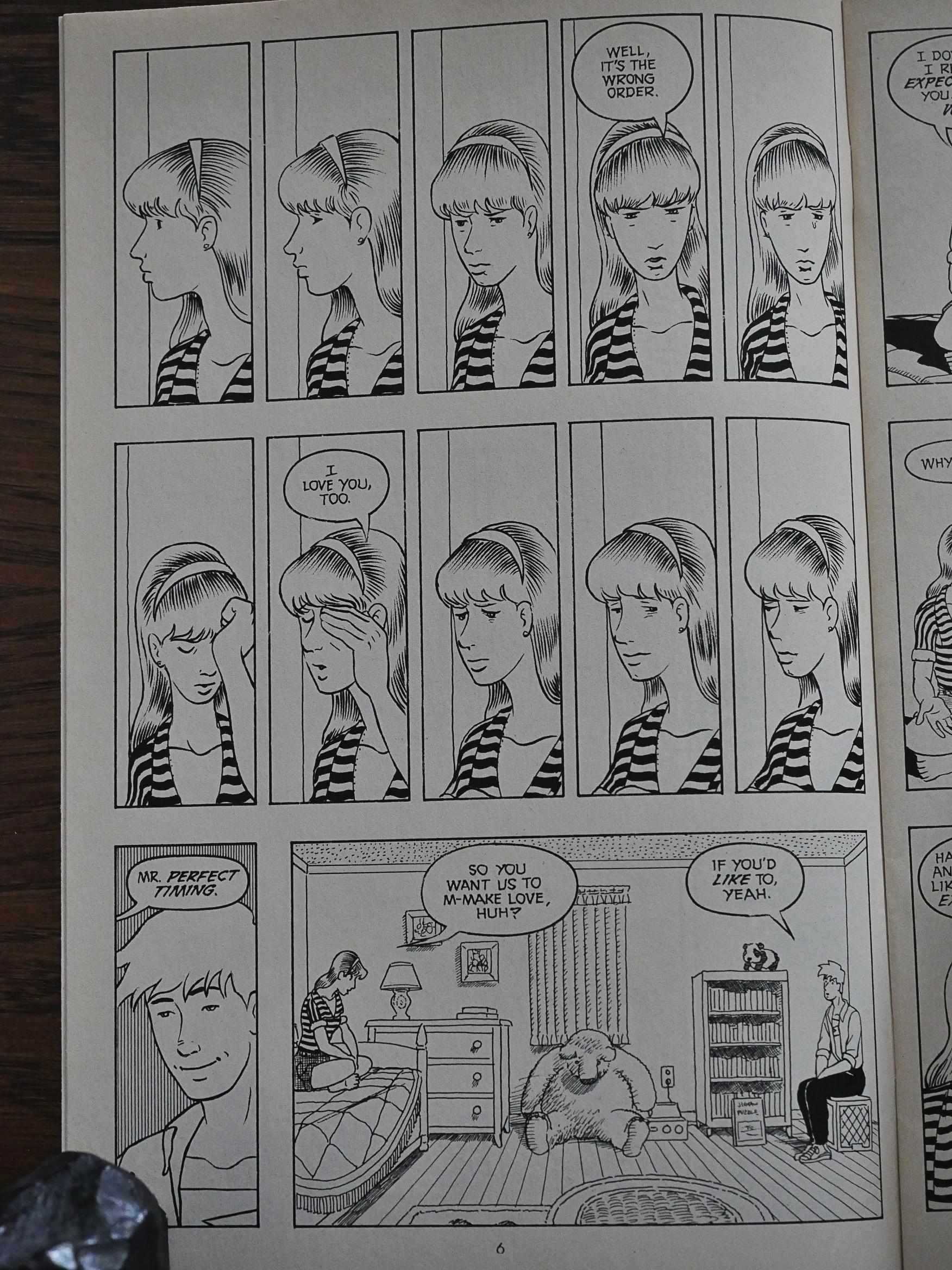
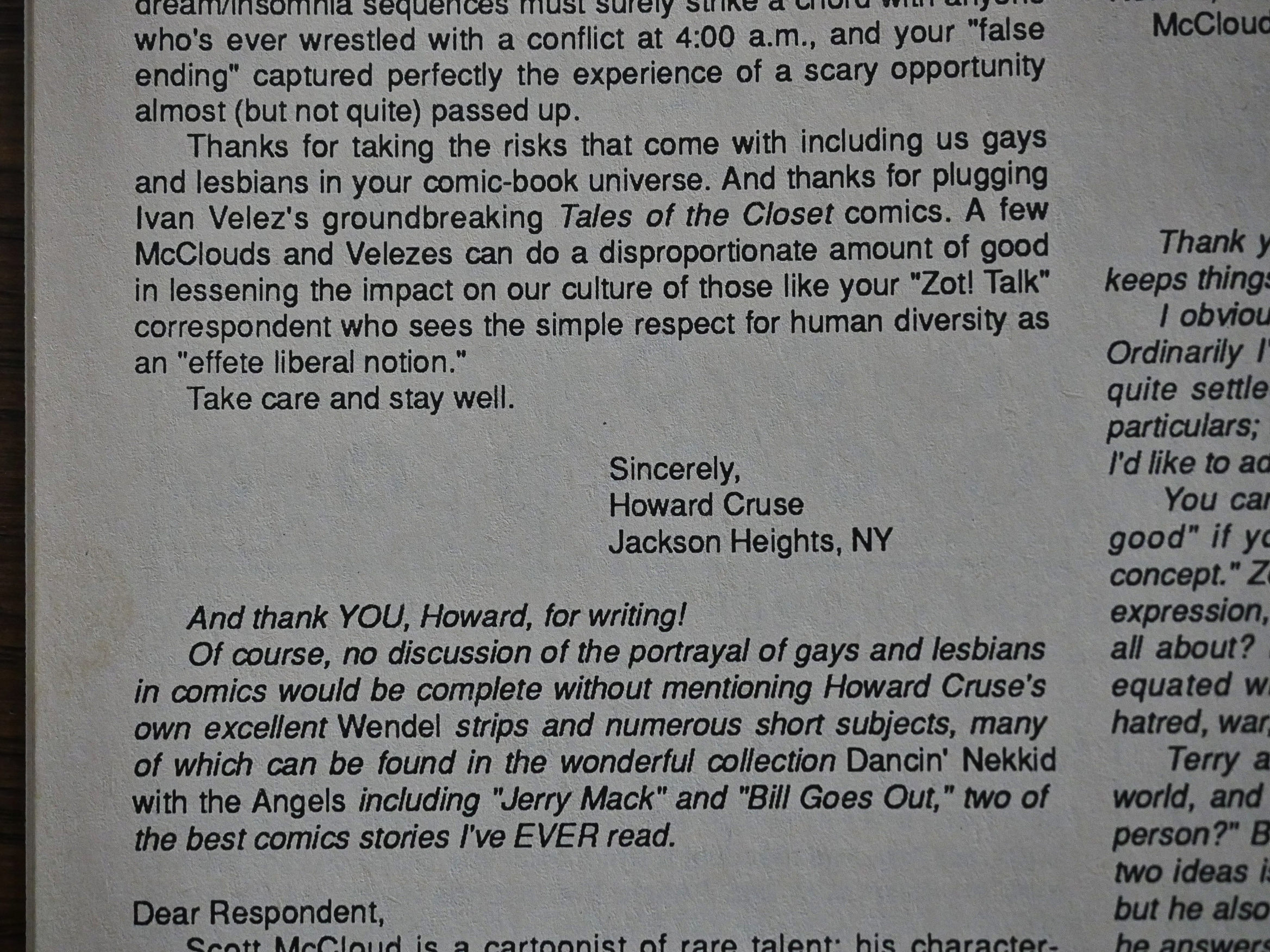
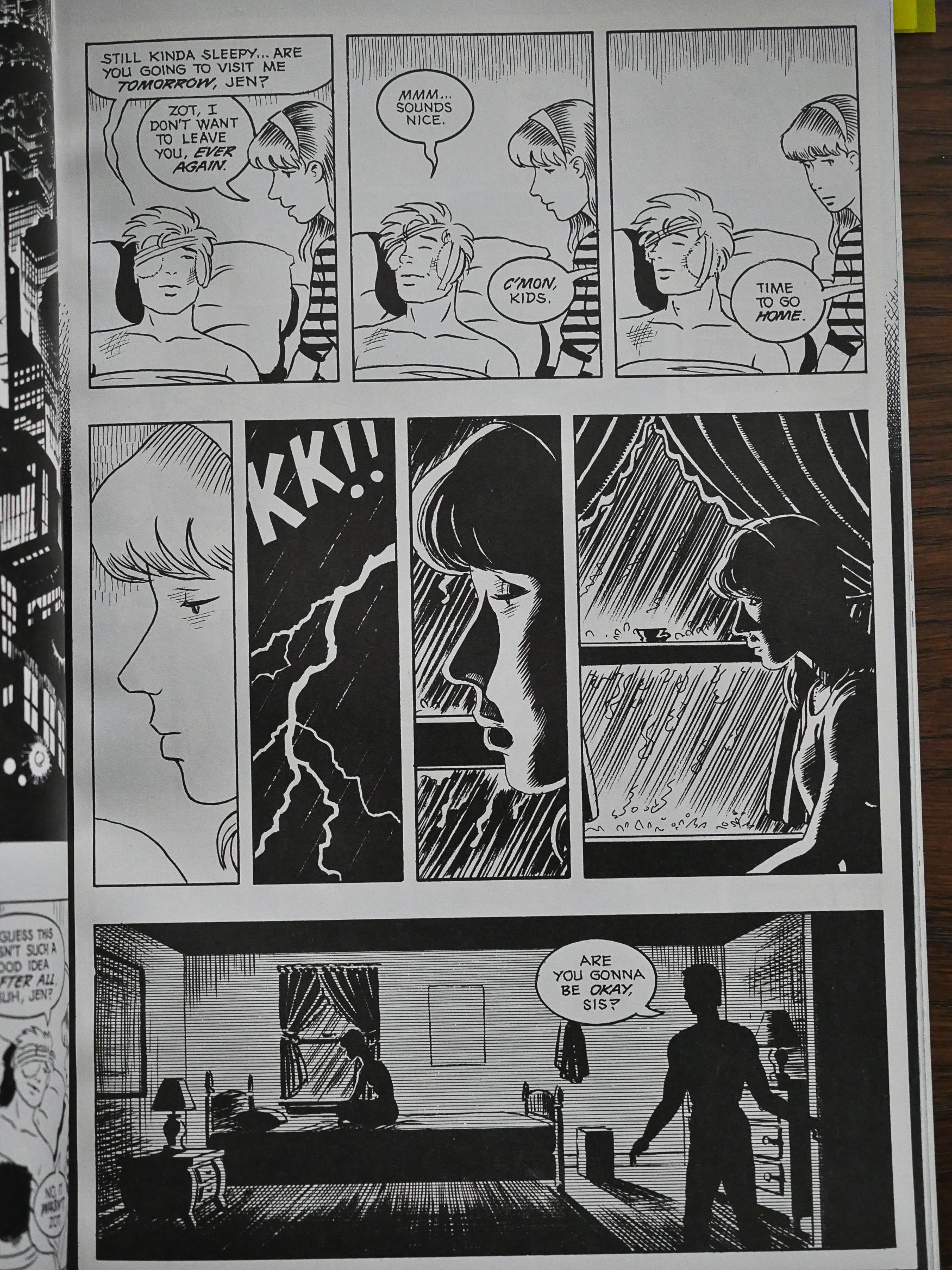
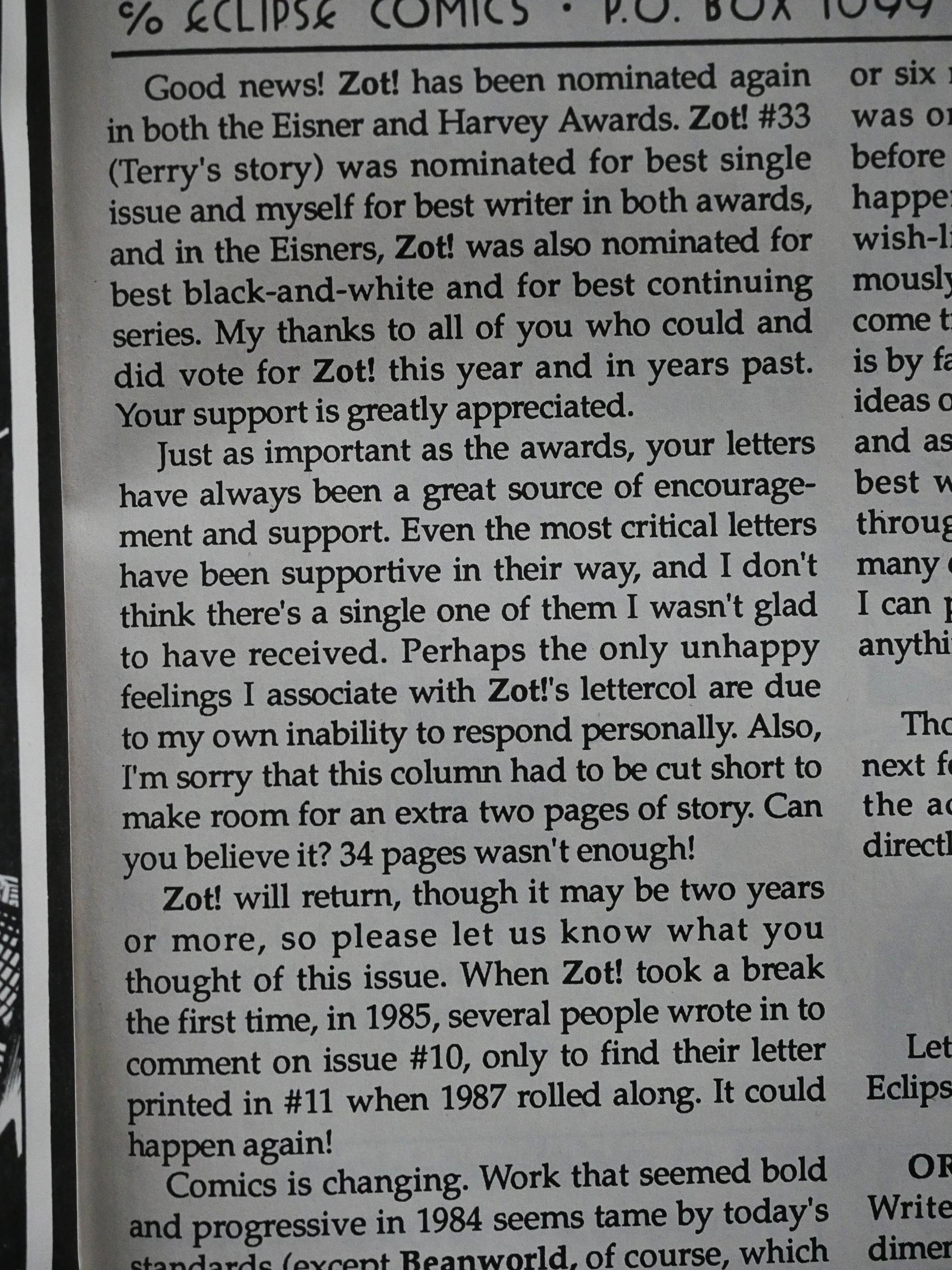
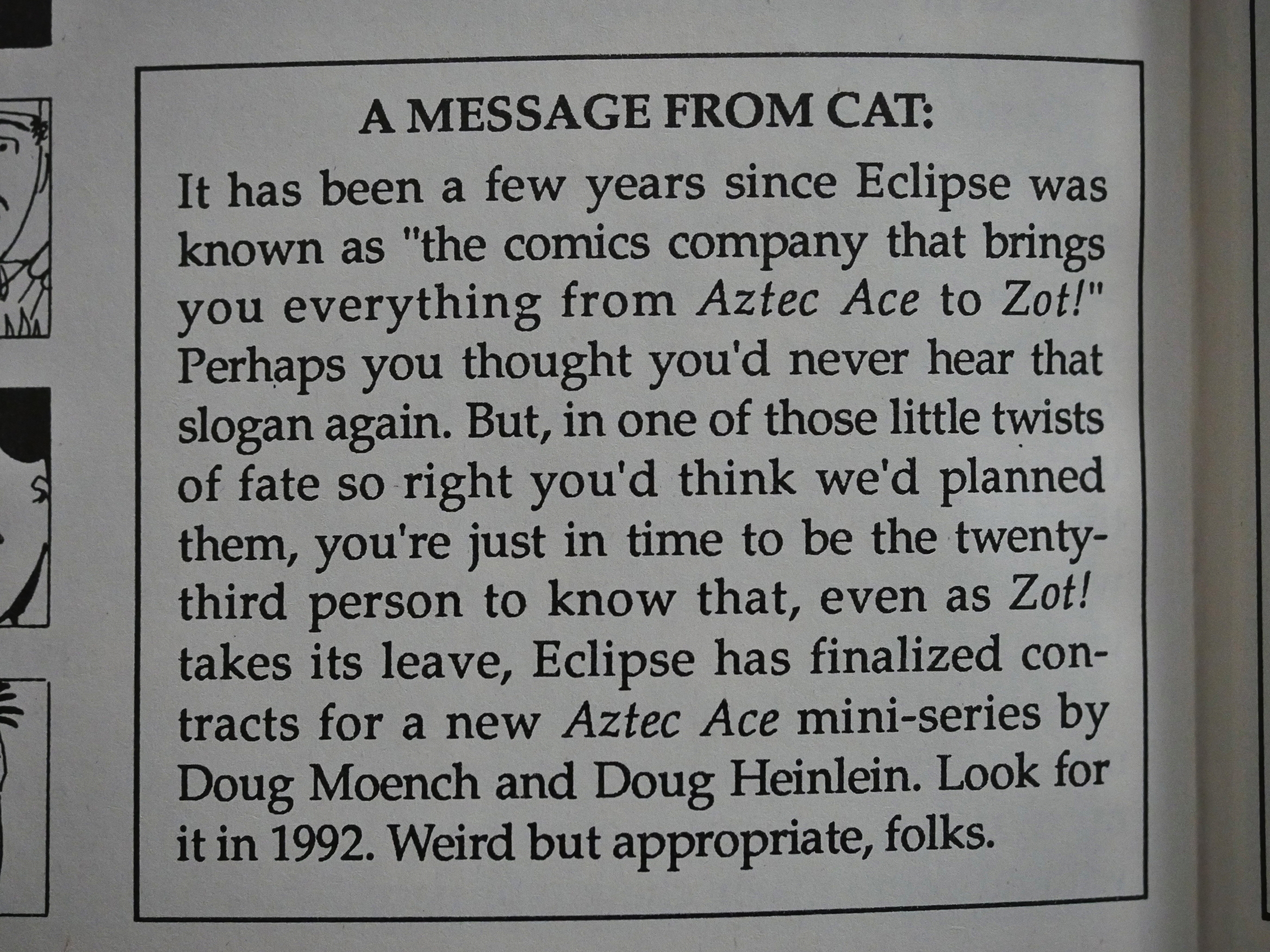
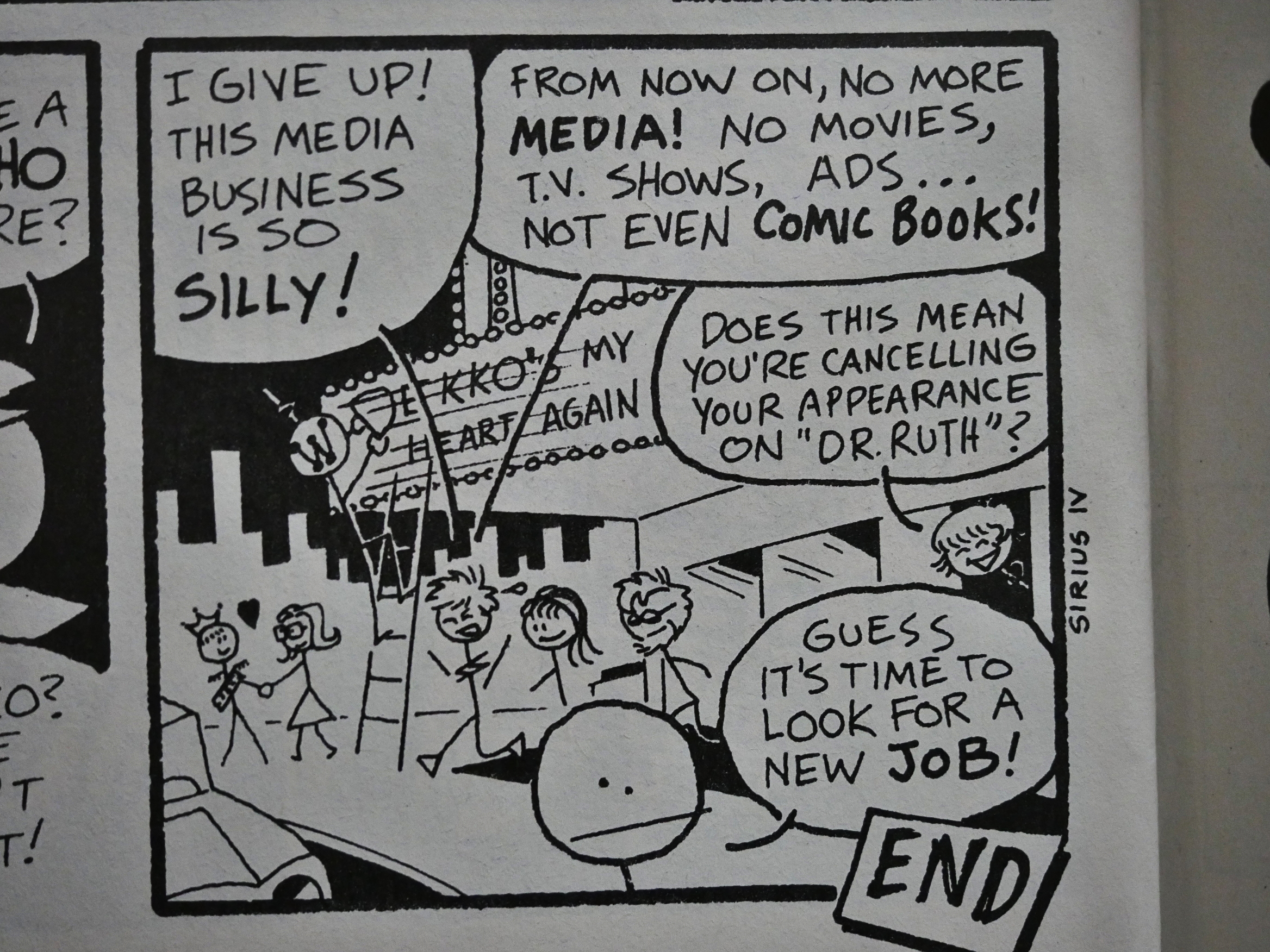
>> Kurt Busiek is listed as “script consultant” for most of the initial ten-issue run, which is, er, not the most common role in comics…>>
The more usual credit would be “story editor,” but Eclipse didn’t want anyone not at Eclipse to be given an editor credit, so since I actually wrote a couple of lines of script in #1 (including the first one!), Scott settled on “script consultant.”
And yeah, THE MAGIC SHOP, which would have gotten a lot stranger as it went along, was canceled because they couldn’t afford to pay Dan, or the letterer, or the colorist. Not me — I was dirt cheap.
My paperback is in storage, so I don’t know about the centre spread. However, he handled the fake ending well, by writing an afterword (in lieu of the letters page). The last sentence mentioned the fake ending, and then you turned the page to get the real ending.